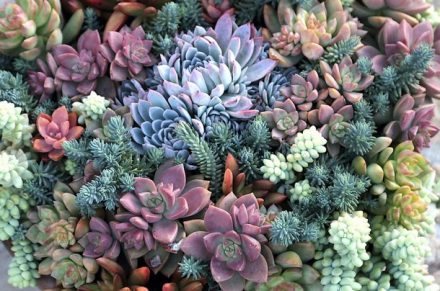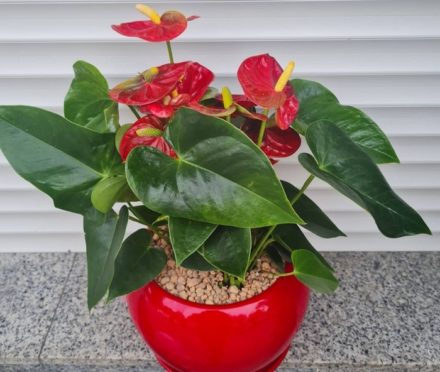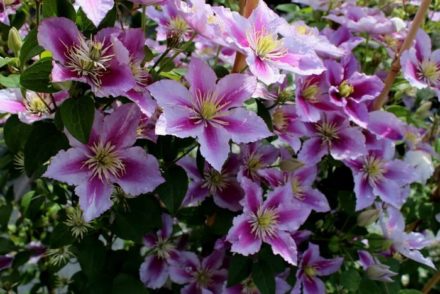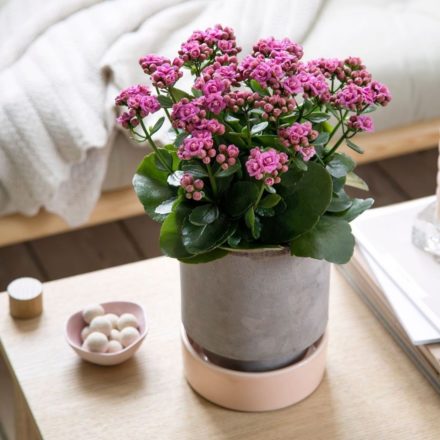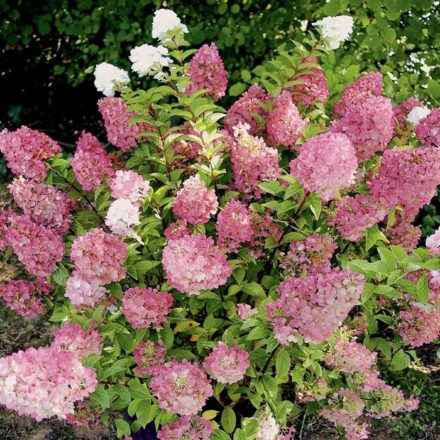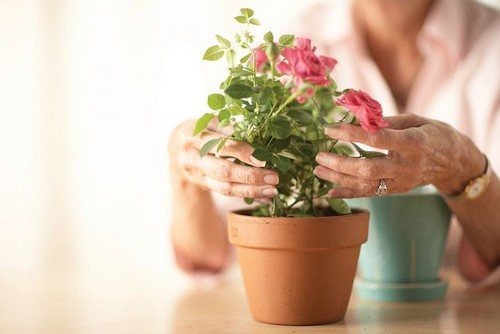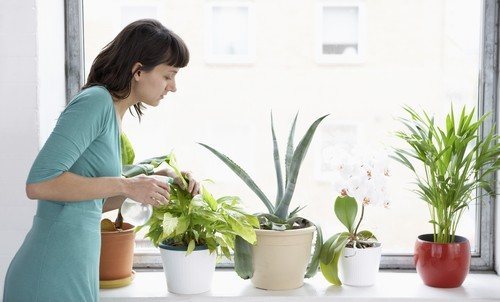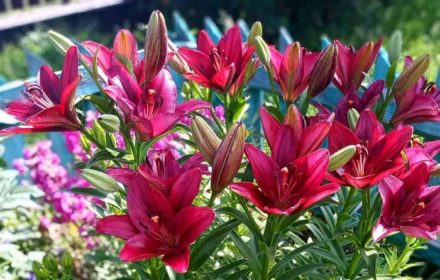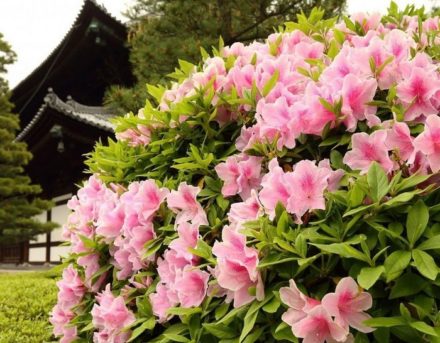Zamioculcas zamiifolia or aroid palm is an evergreen, perennial plant of the aroid family, growing in the tropics of East and Central Africa. Since the end of the last century, zamioculcas has been actively cultivated as a houseplant. The popularity of the succulent has been steadily increasing in recent years, because without requiring special care, it develops well and reaches a height of a meter or more. Today, this exotic plant can be found in home flower beds, offices, botanical gardens and greenhouses. It is loved for its neat, noble appearance. There is a belief that zamioculcas brings prosperity to the home, as evidenced by the popular name - the dollar tree. In the article we will tell:
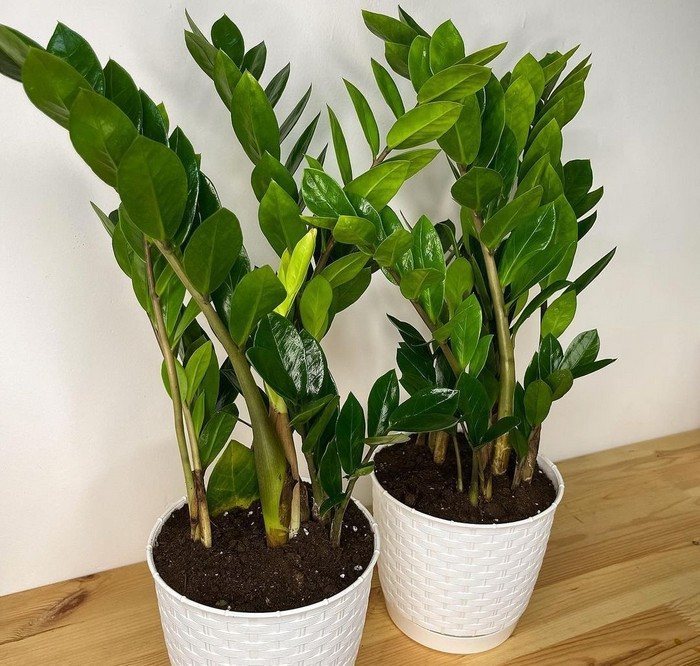
- Varieties
- Zamiefolium
- Lanceolate
- Variegated
- Variegated
- Dark purple
- Buaven (Zanzibar pearl)
- Dwarf Zenzi
- Common names of the plant in Russia
- Conditions of maintenance
- Temperature
- Humidity indicators
- Lighting
- Where to keep
- Flower care
- Soil
- Container
- Supports
- Watering
- Spraying
- Fertilizer
- Pruning
- Replanting
- When necessary
- Process
- Flowering
- During
- After
- Rest period
- Rejuvenation
- Care errors
- Is it possible to leave zamioculcas without care
- Reproduction
- Cuttings (cuttings)
- Plume leaf
- Compound leaf
- By dividing the bush
- Tubers
- Seeds
- Diseases
- Chlorosis
- Anthracnose
- Powdery mildew
- Sooty (black) fungi
- Pests
- Aphids
- Thrips
- Scale insectsZamioculcas (105 photos): caring for a dollar tree at home
- Skip to content
- Wash
- Ironing
- Stains
- Cleaning
- Things
- Pests
- Technique
- Storage
- Dishes
- Interior
- Garden
- Adviсe
- 105 photos of different types of Zamioculcas flowers and care for indoor plants
- Zamioculcas zamifolia or aroid palm is an evergreen, perennial plant of the aroid family, growing in the tropics of East and Central Africa. Since the end of the last century, Zamioculcas has been actively cultivated as a houseplant. The popularity of succulents has been steadily increasing in recent years, because without requiring special care, it develops well and reaches a height of a meter or more. Today this exotic plant can be found in home flower beds, offices, botanical gardens and greenhouses. He is loved for his neat, noble appearance. There is a belief that Zamioculcas brings prosperity to the house, as evidenced by the popular name - dollar tree.
- In this article we will tell you:
- Botanical description
- Varieties
- Zamielifolia
- Lanceolate
- Variegated
- Motley
- Dark purple
- Buavena (Zanzibar Pearl)
- Dwarf Zenzi
- Common names of plants in Russia
- Conditions of detention
- Temperature
Lighting
Where to keep
Flower care
Priming
Tara
Supports
When necessary
Process
Bloom
During
After
Rest periodRejuvenation
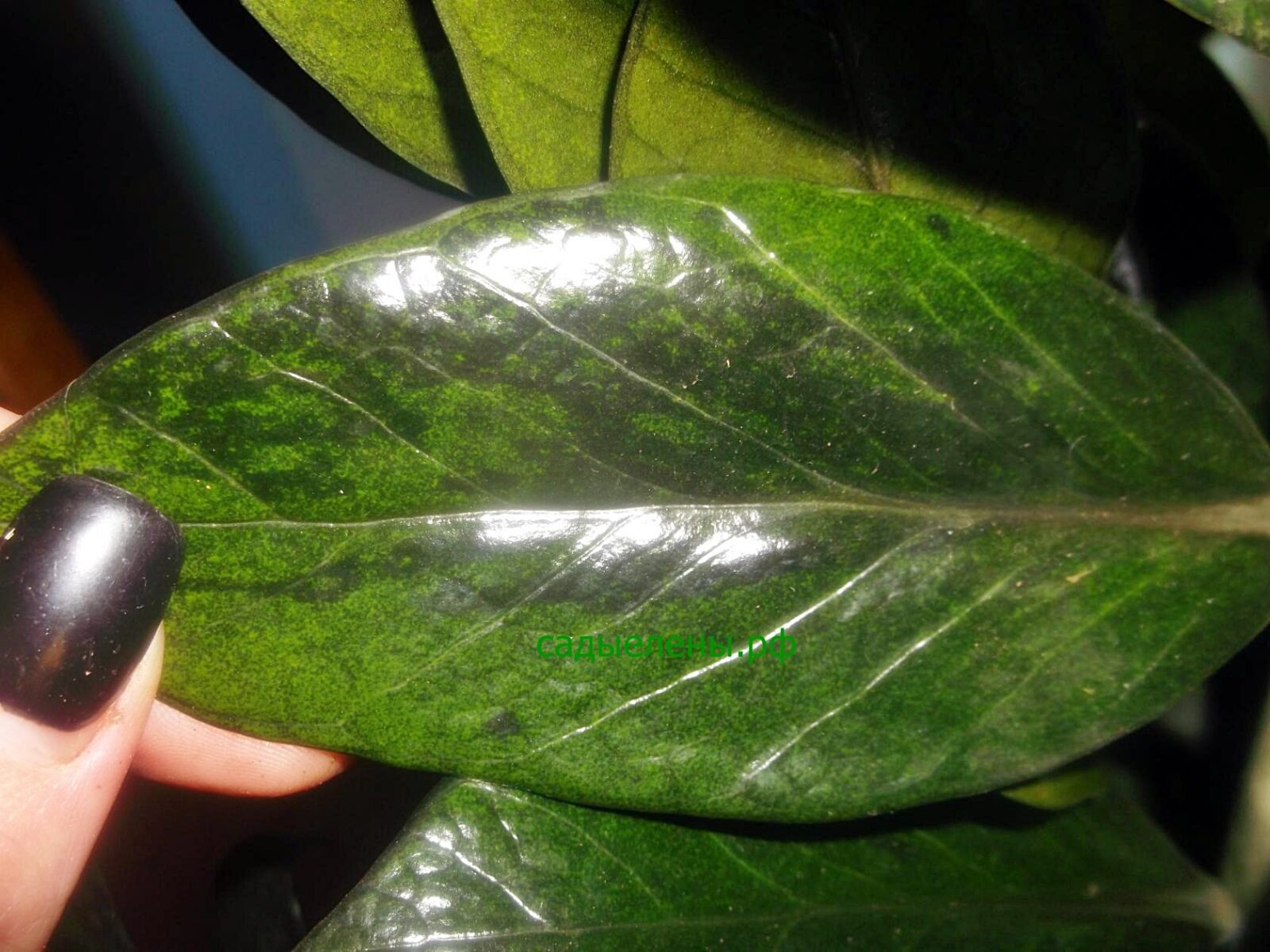
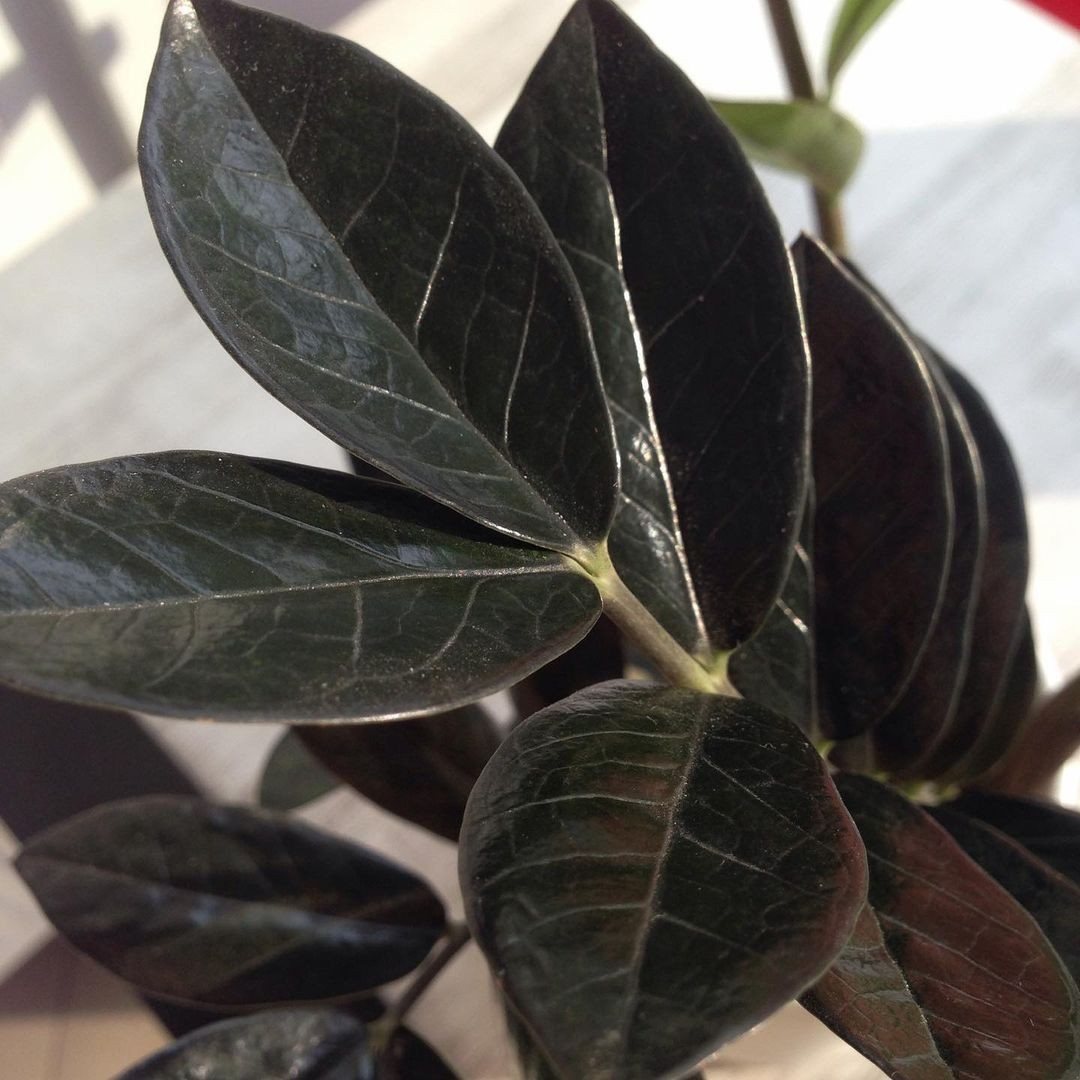
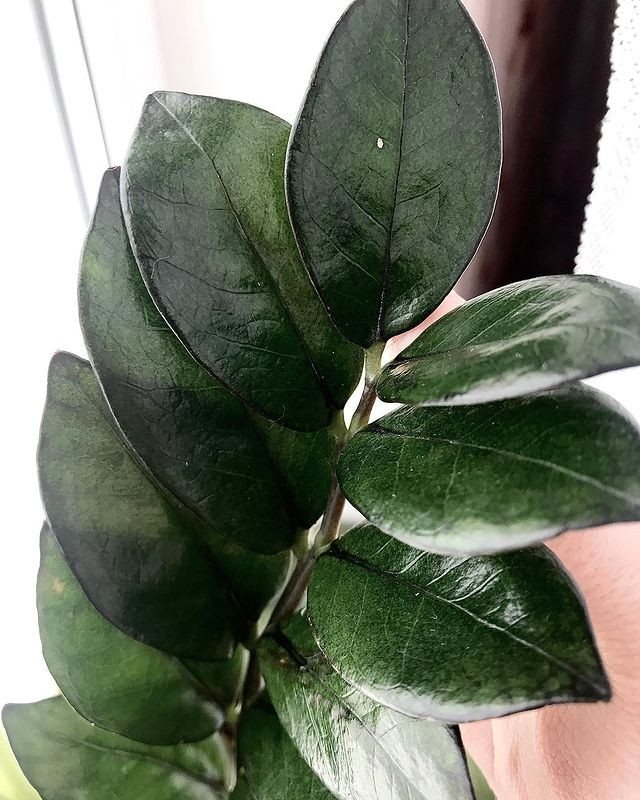
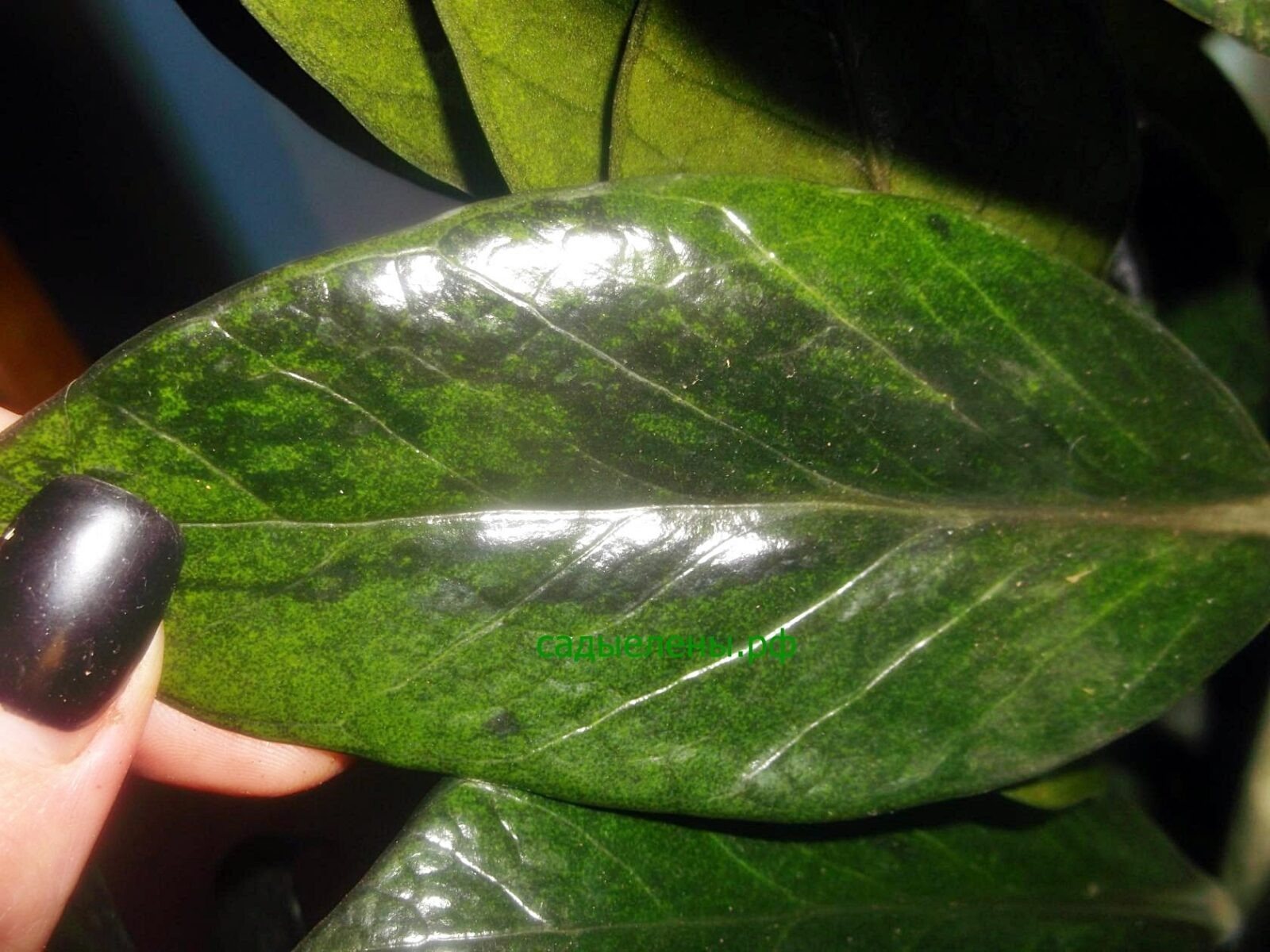
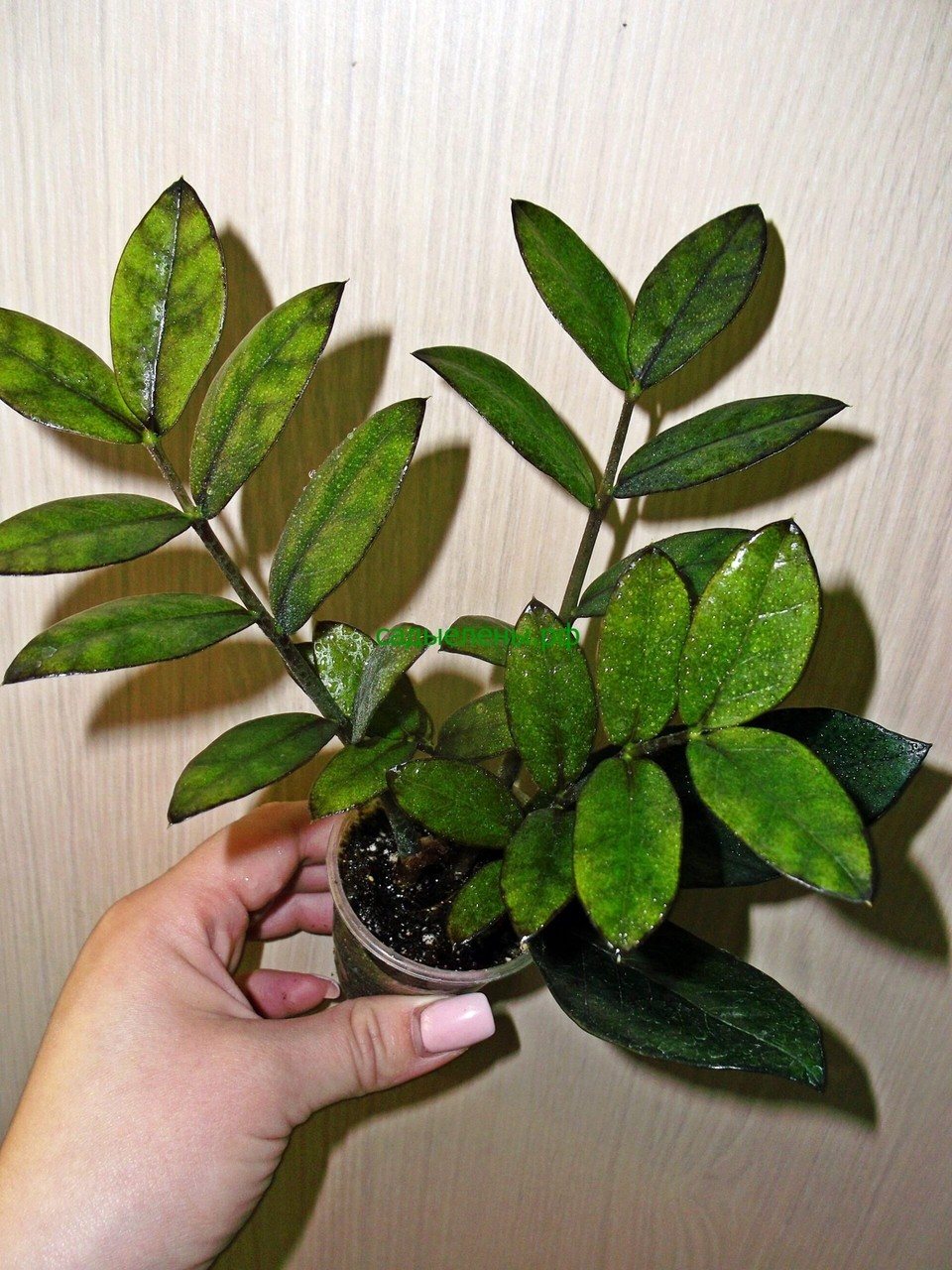





Care errorsIs it possible to leave Zamioculcas without care?
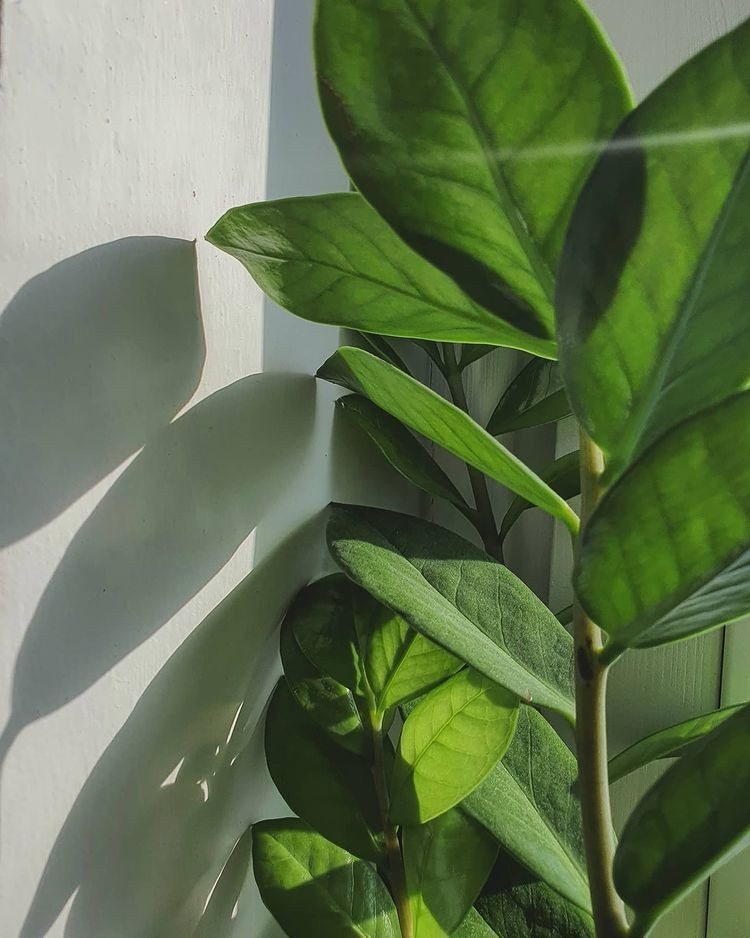

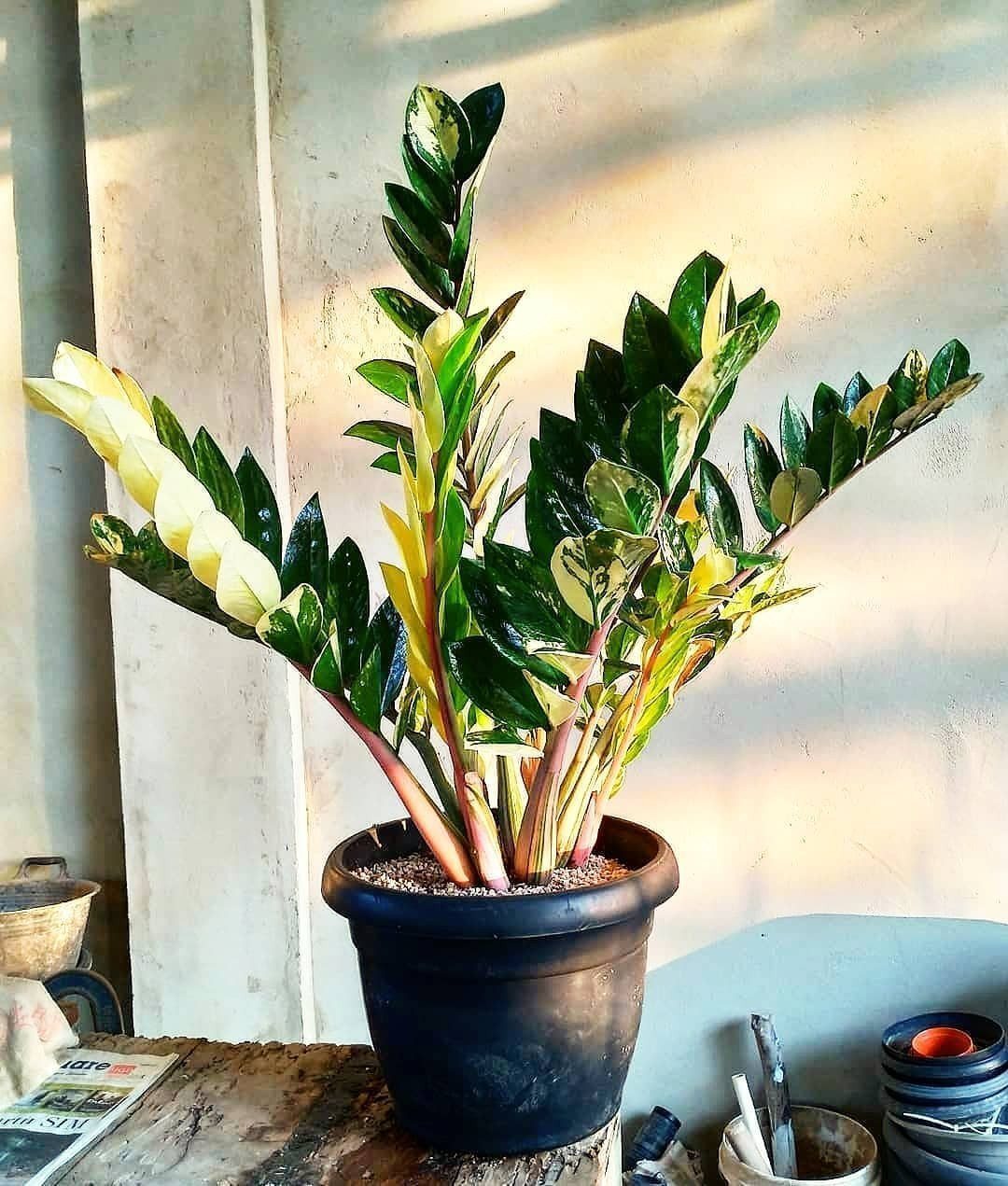
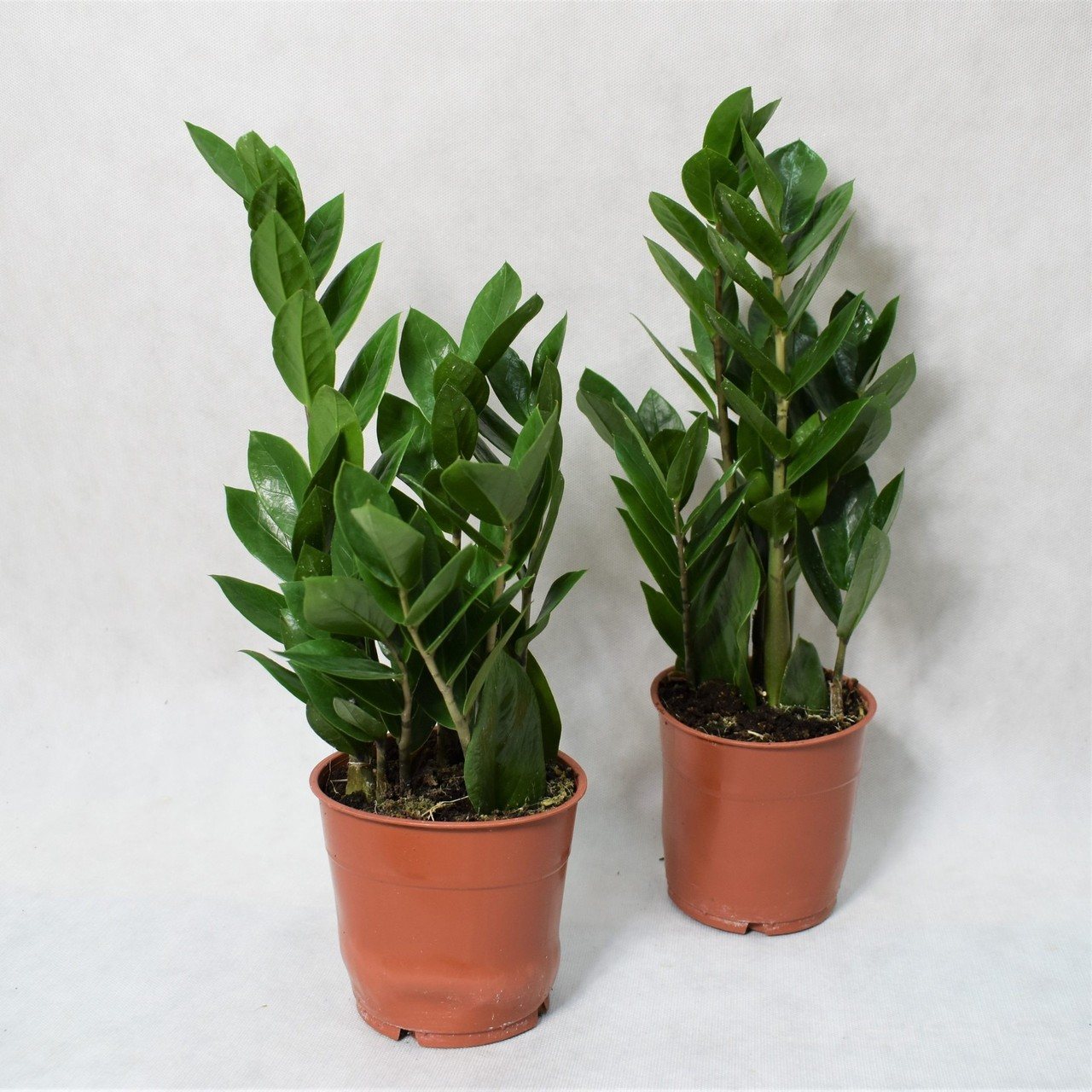
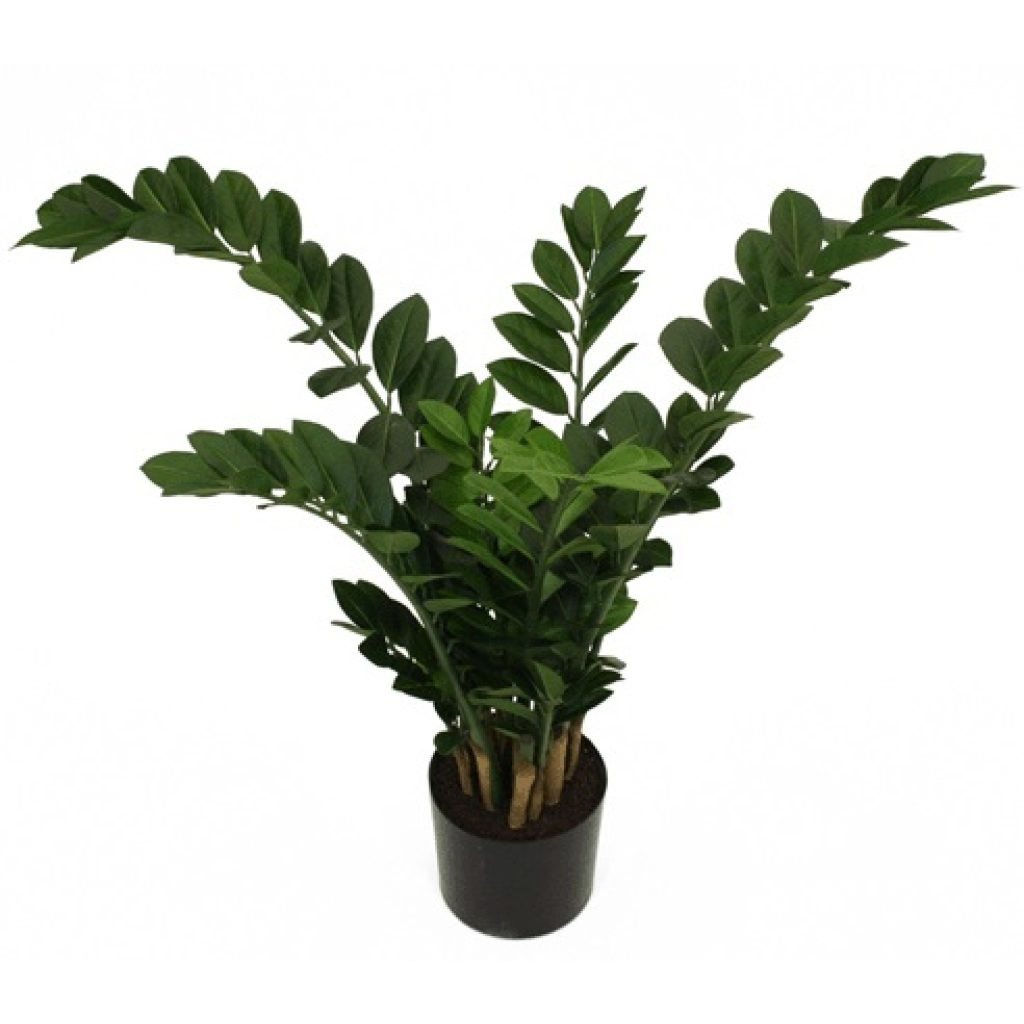





ReproductionCuttings (cuttings)
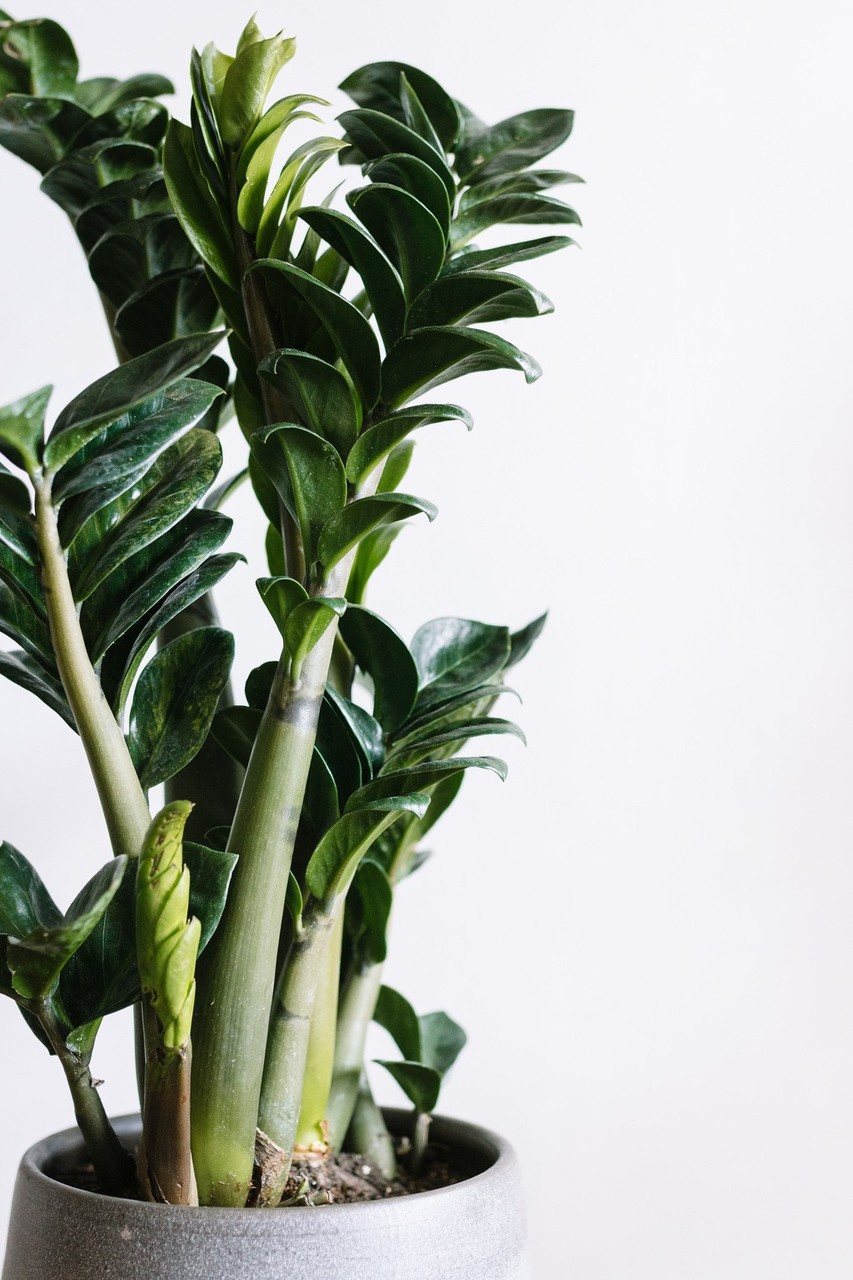
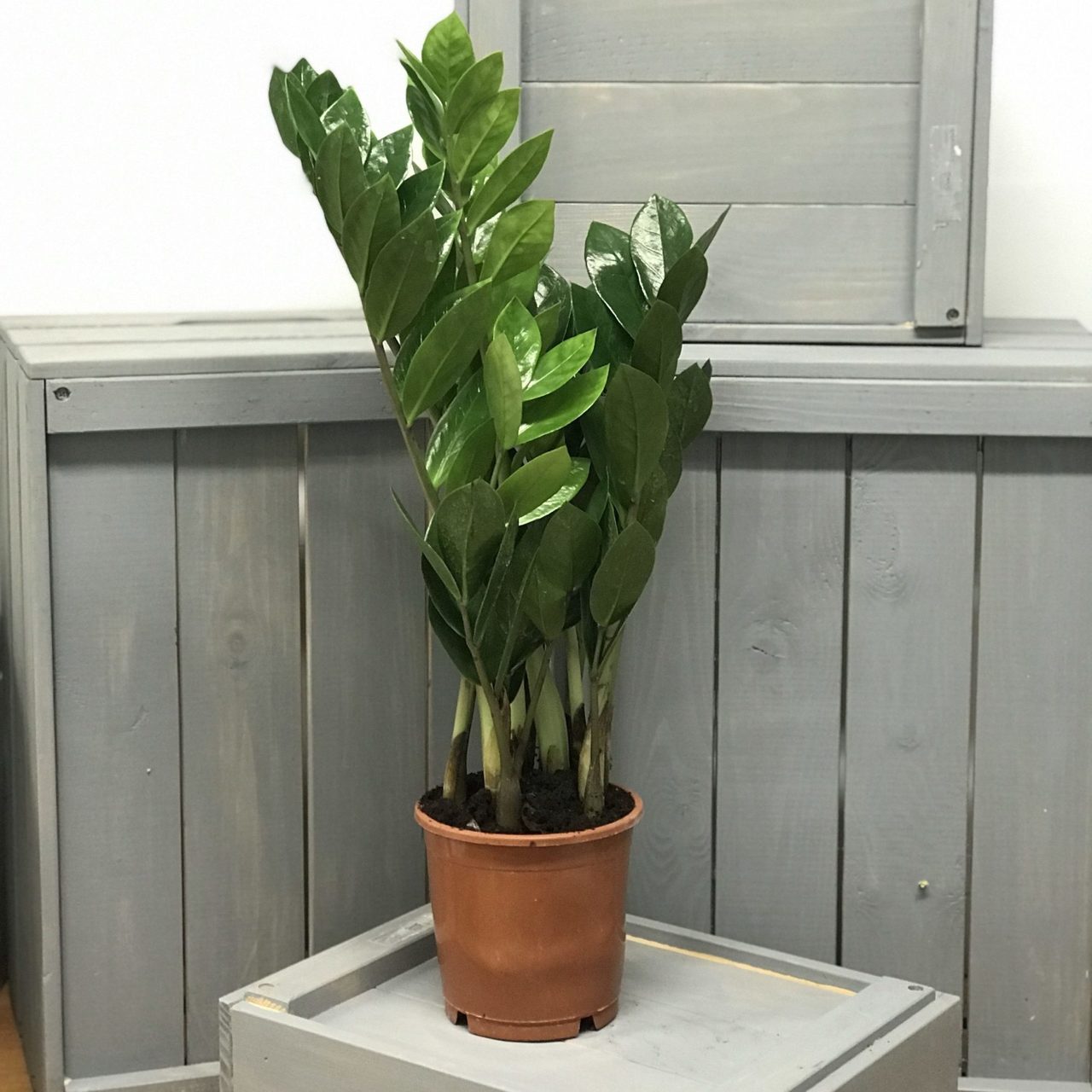
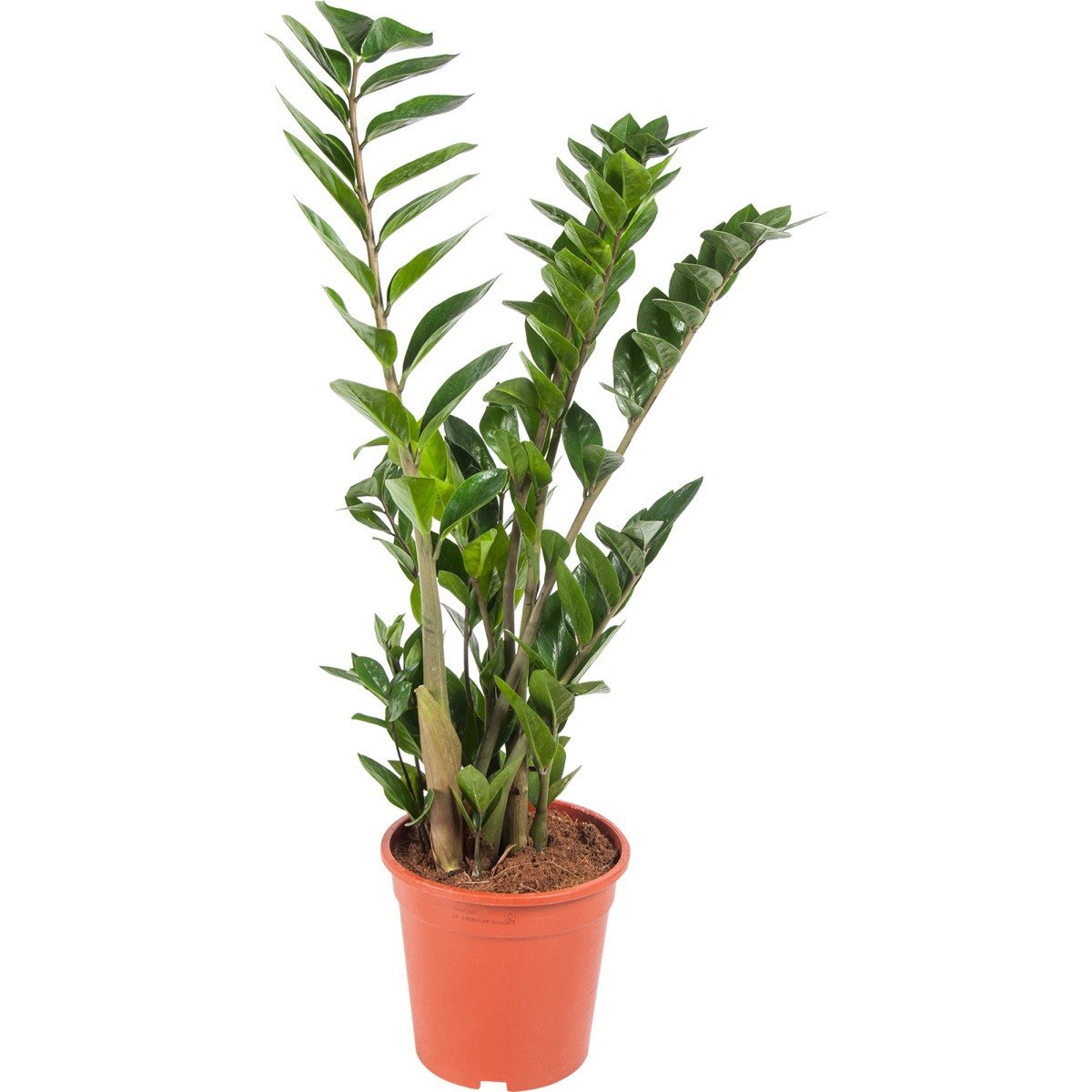

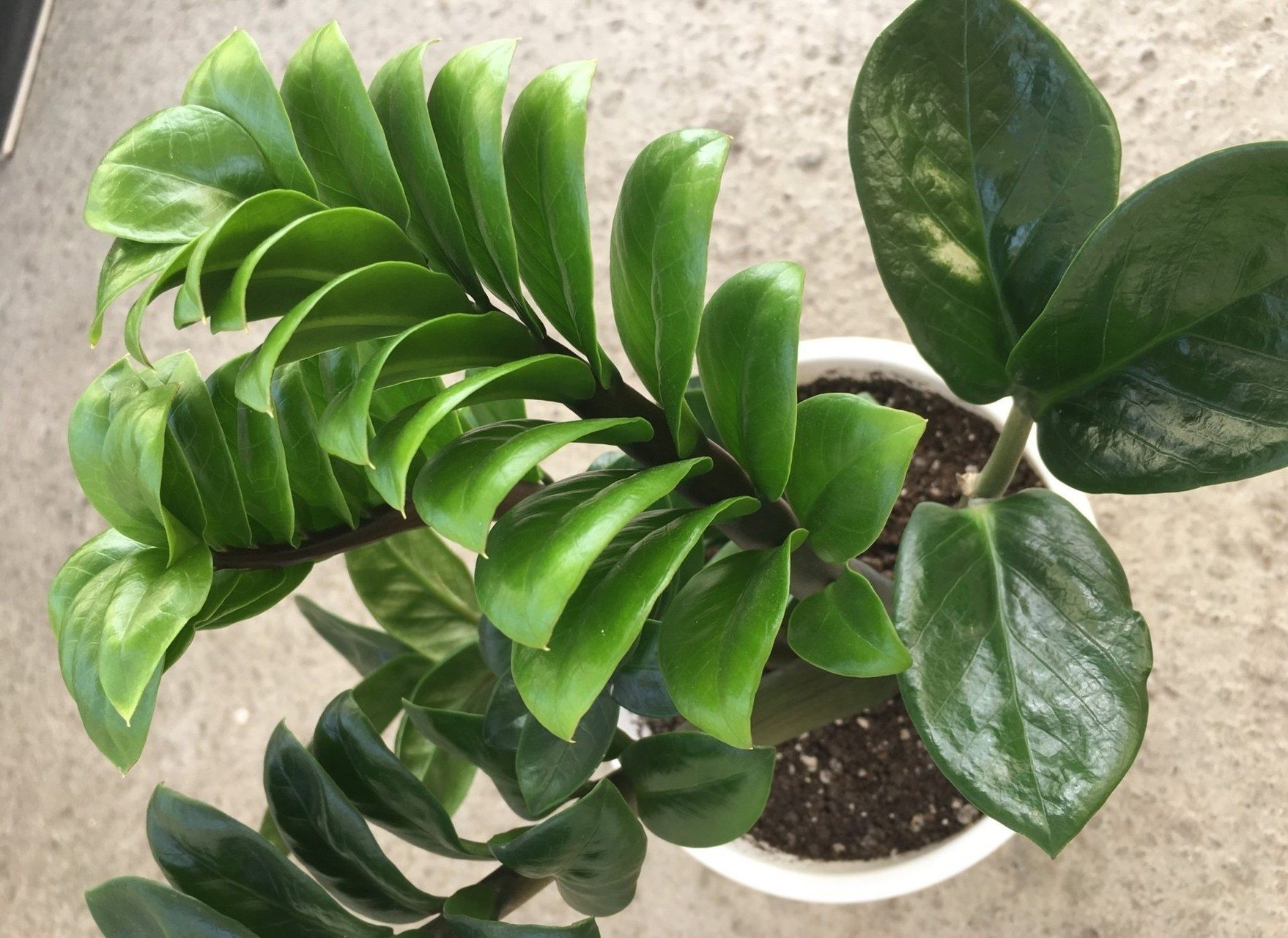





Leaf-featherComplex sheet

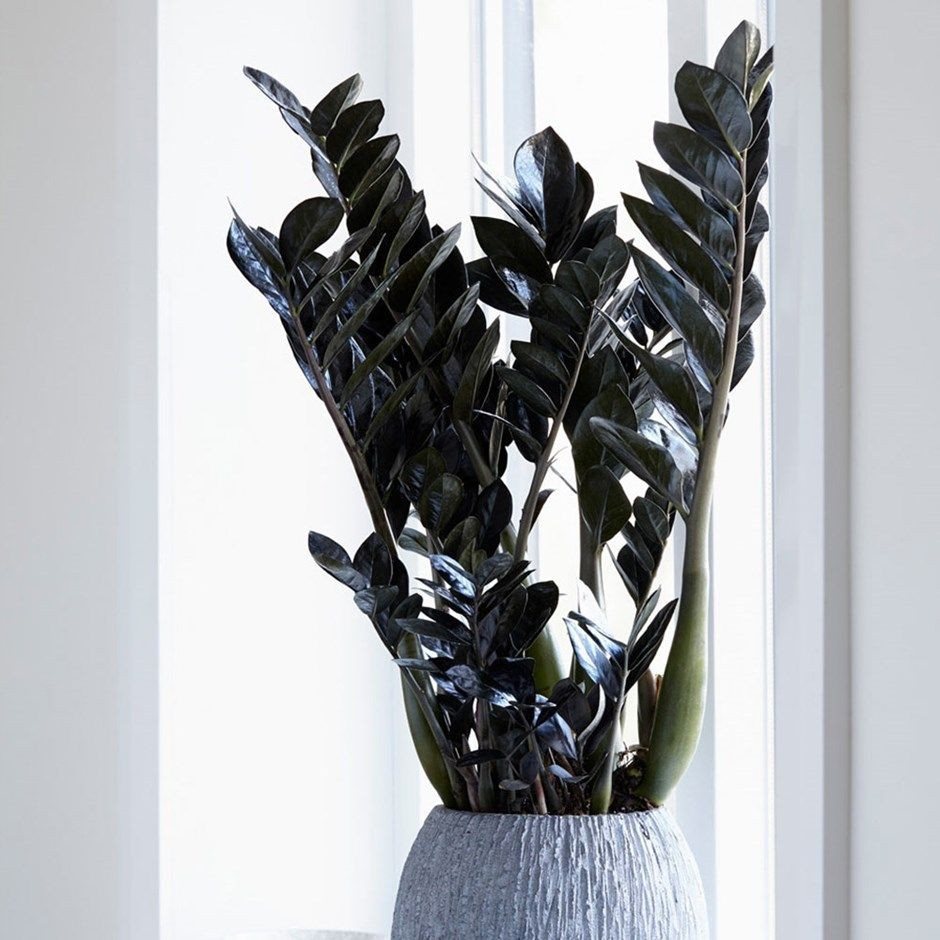
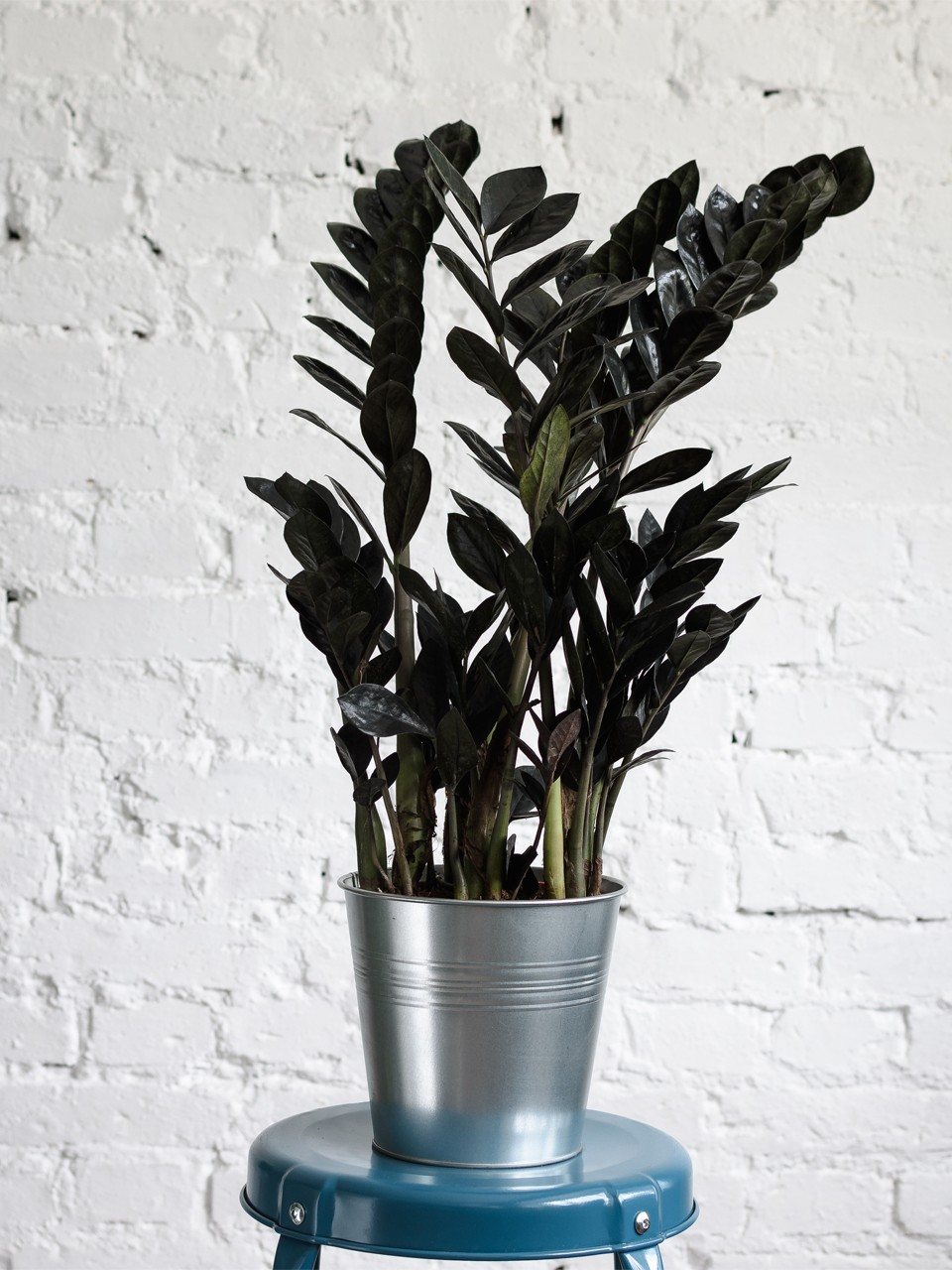
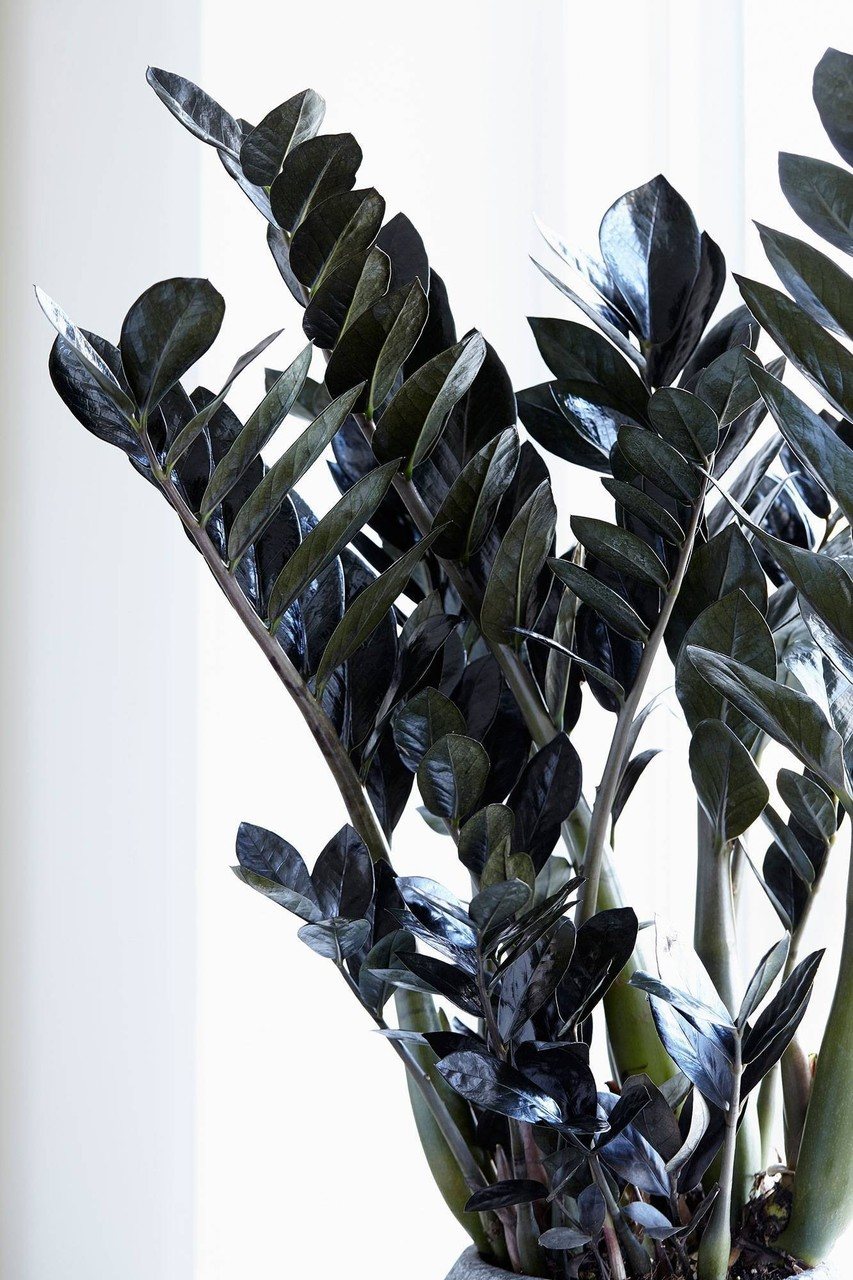
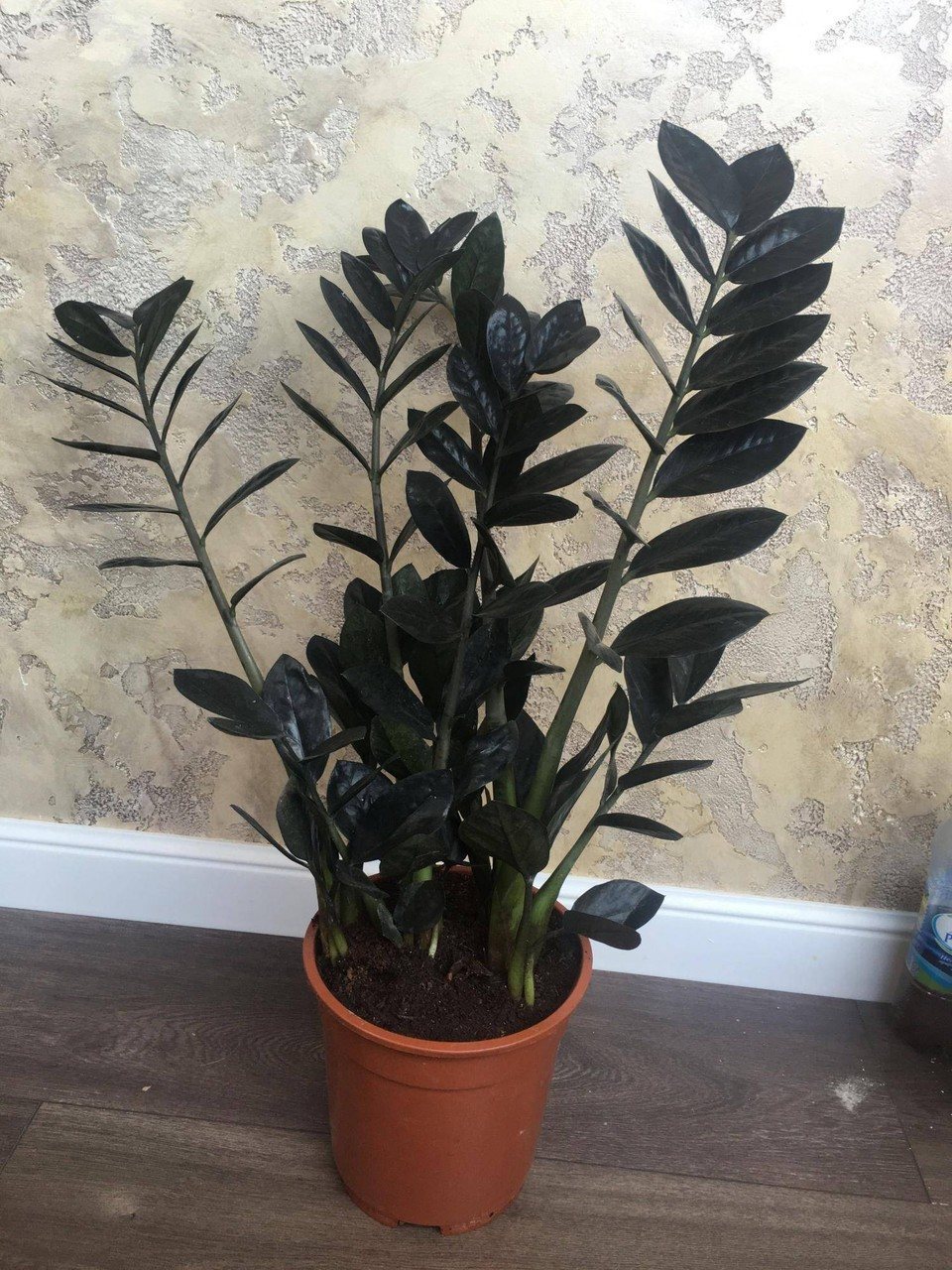





Dividing the bushTubers
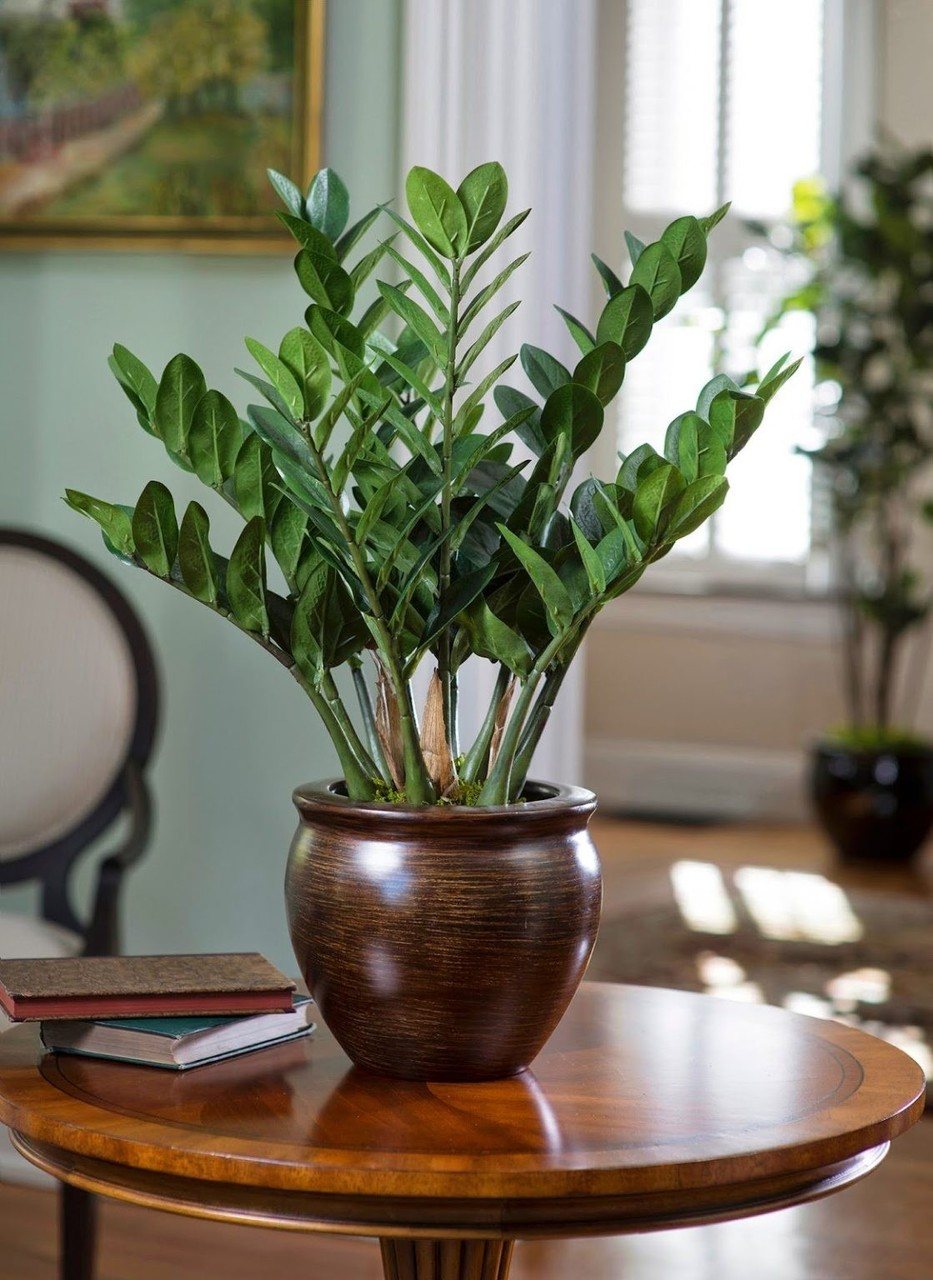
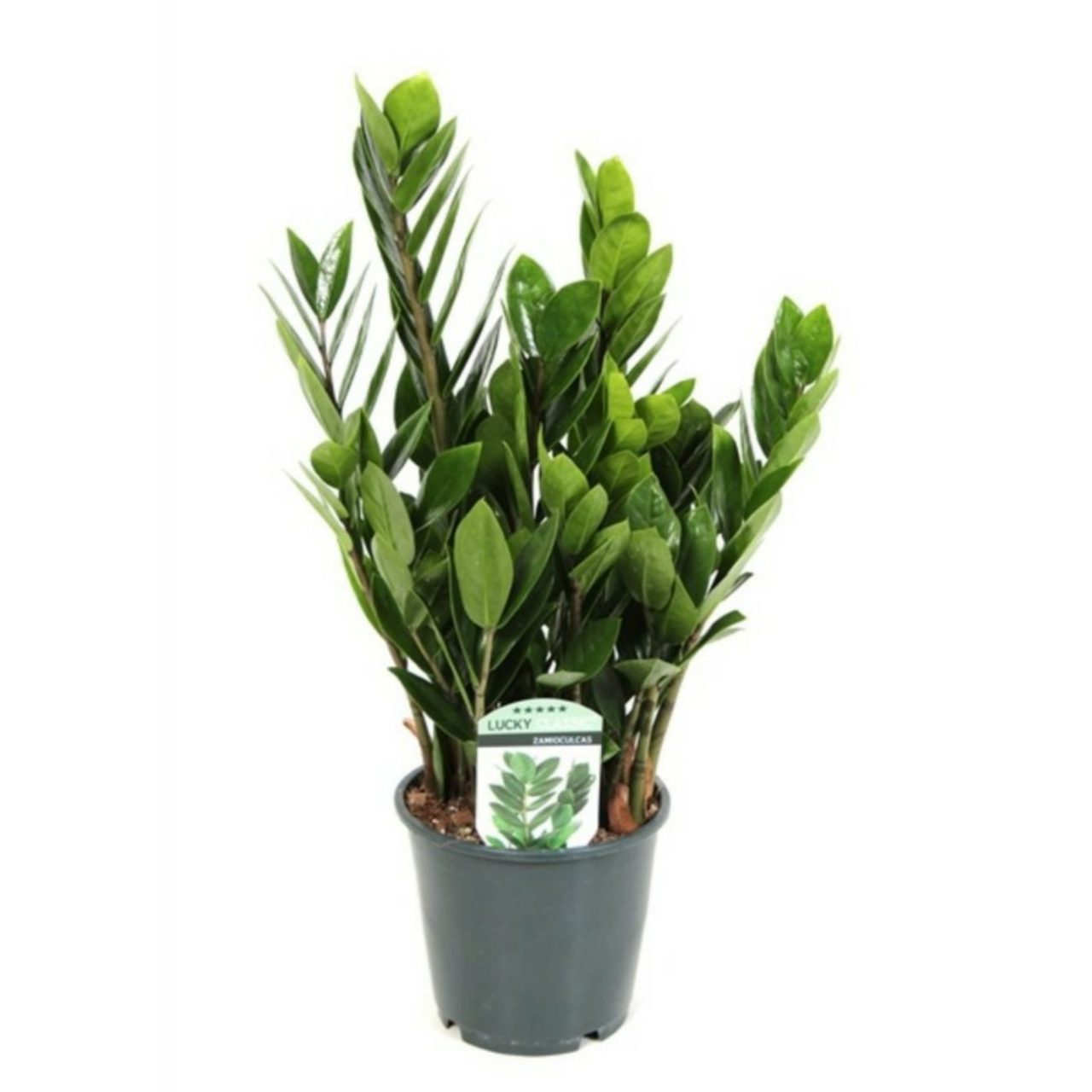
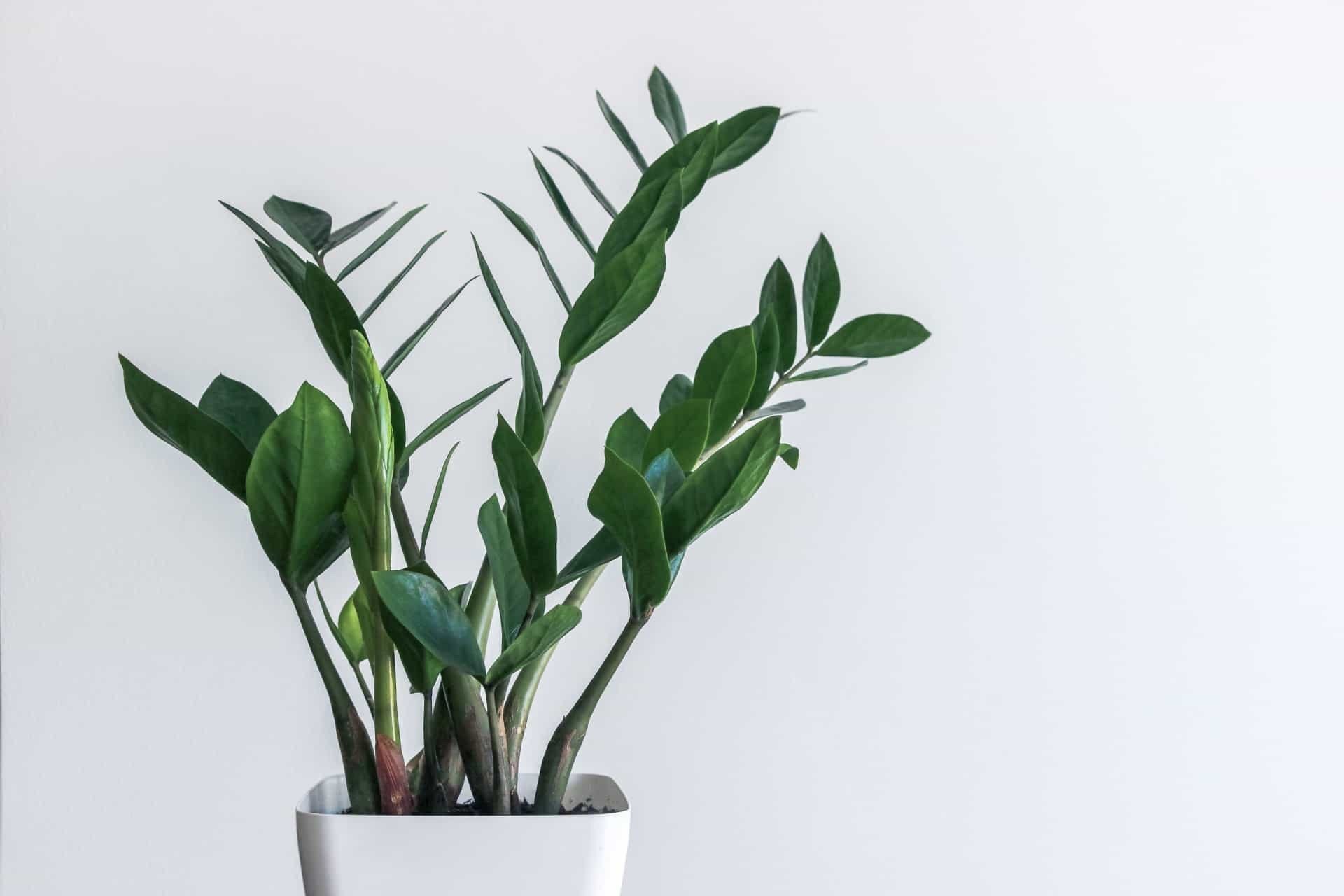
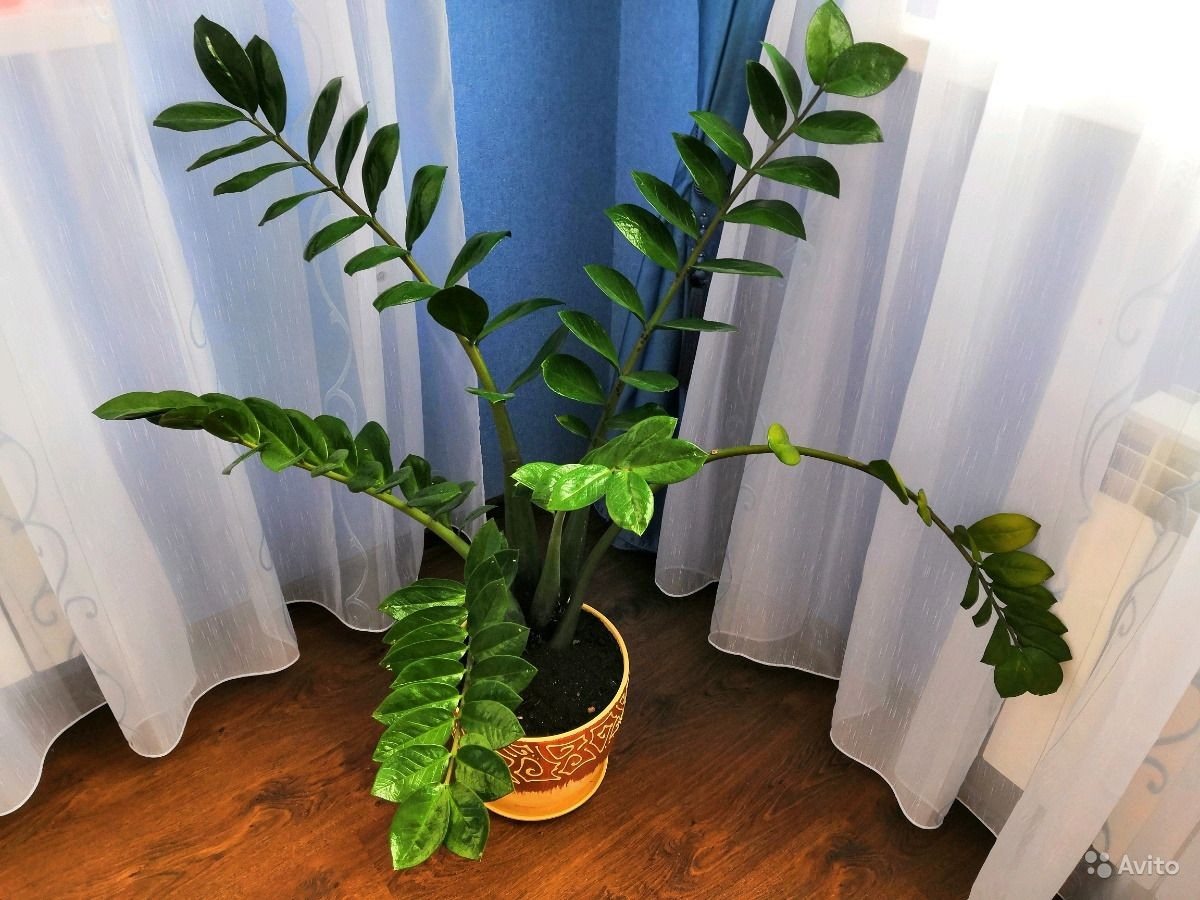
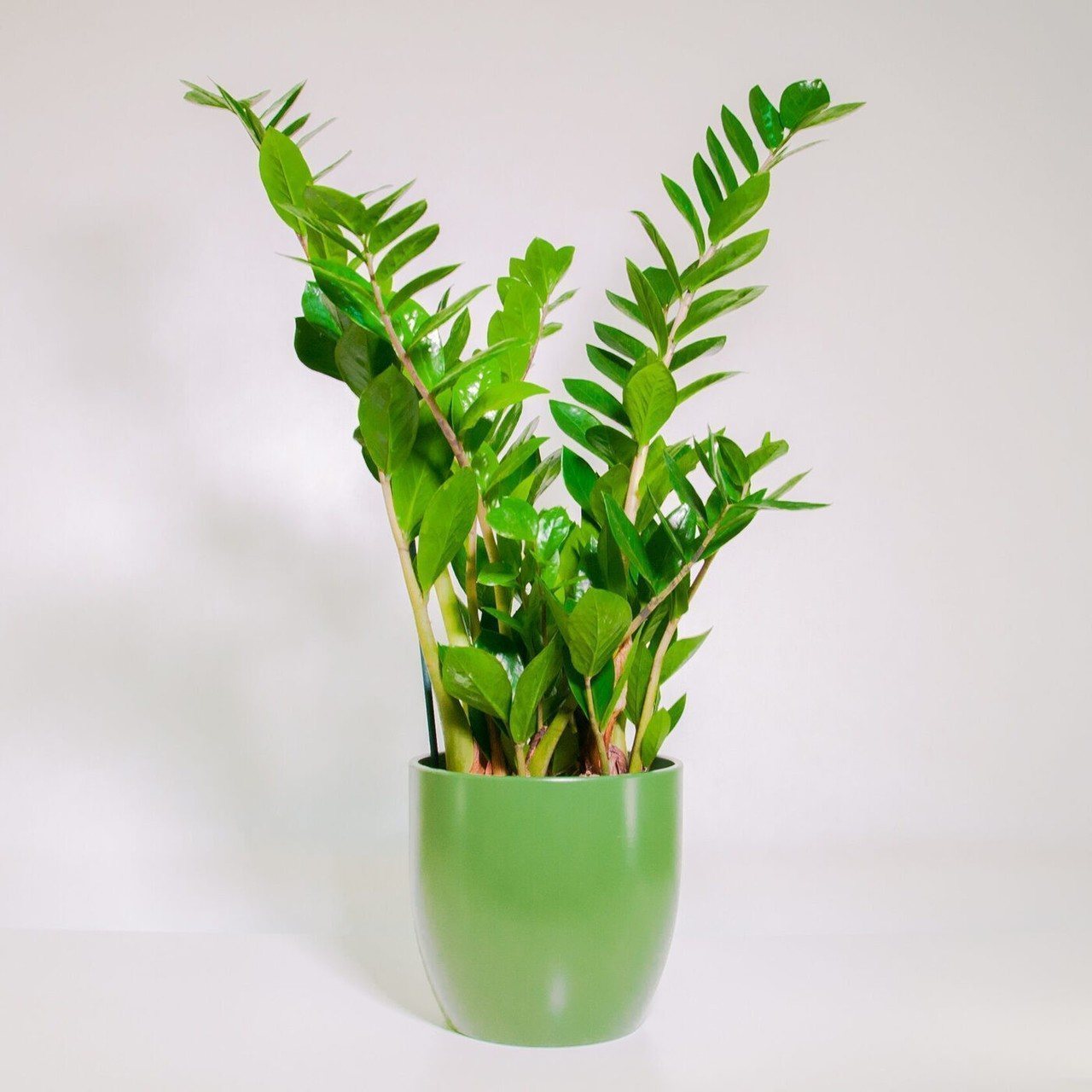





Seeds
Diseases
Chlorosis
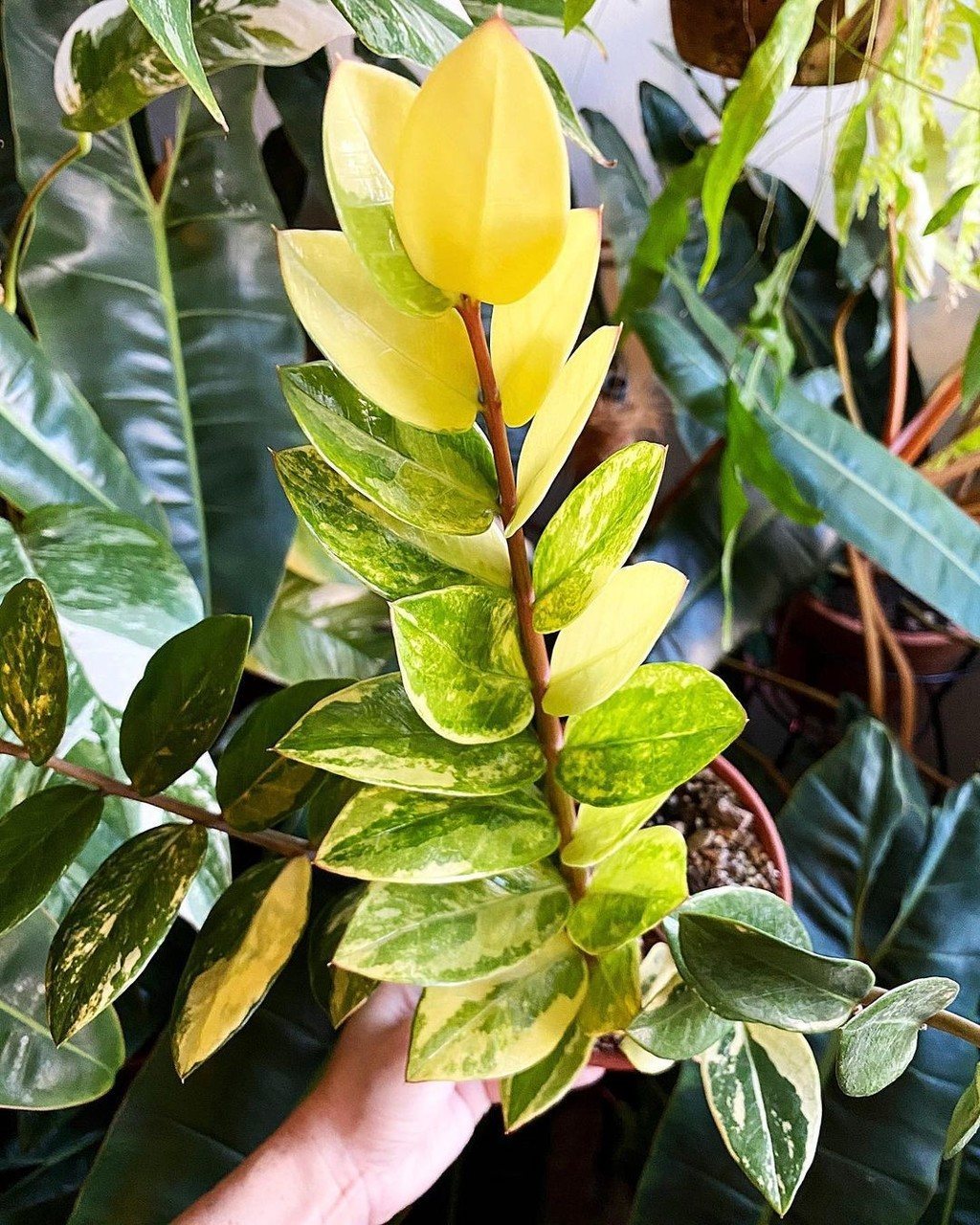
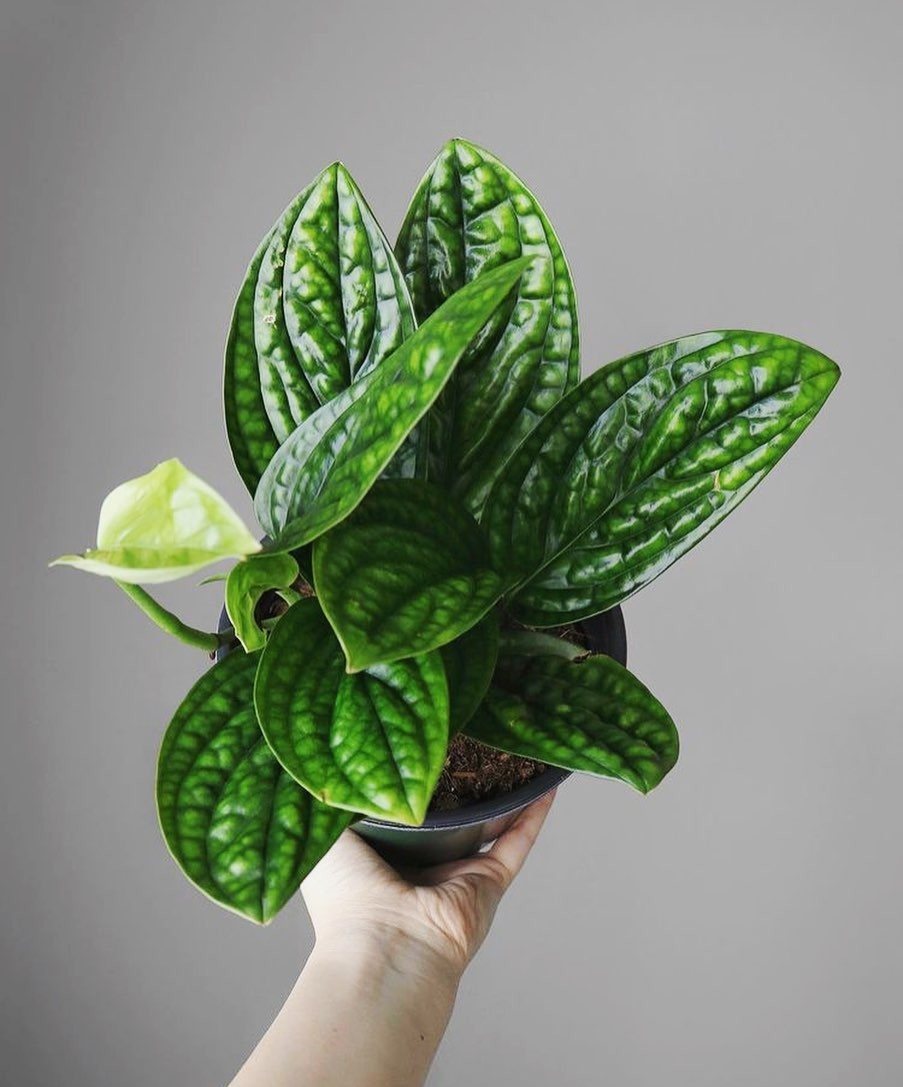
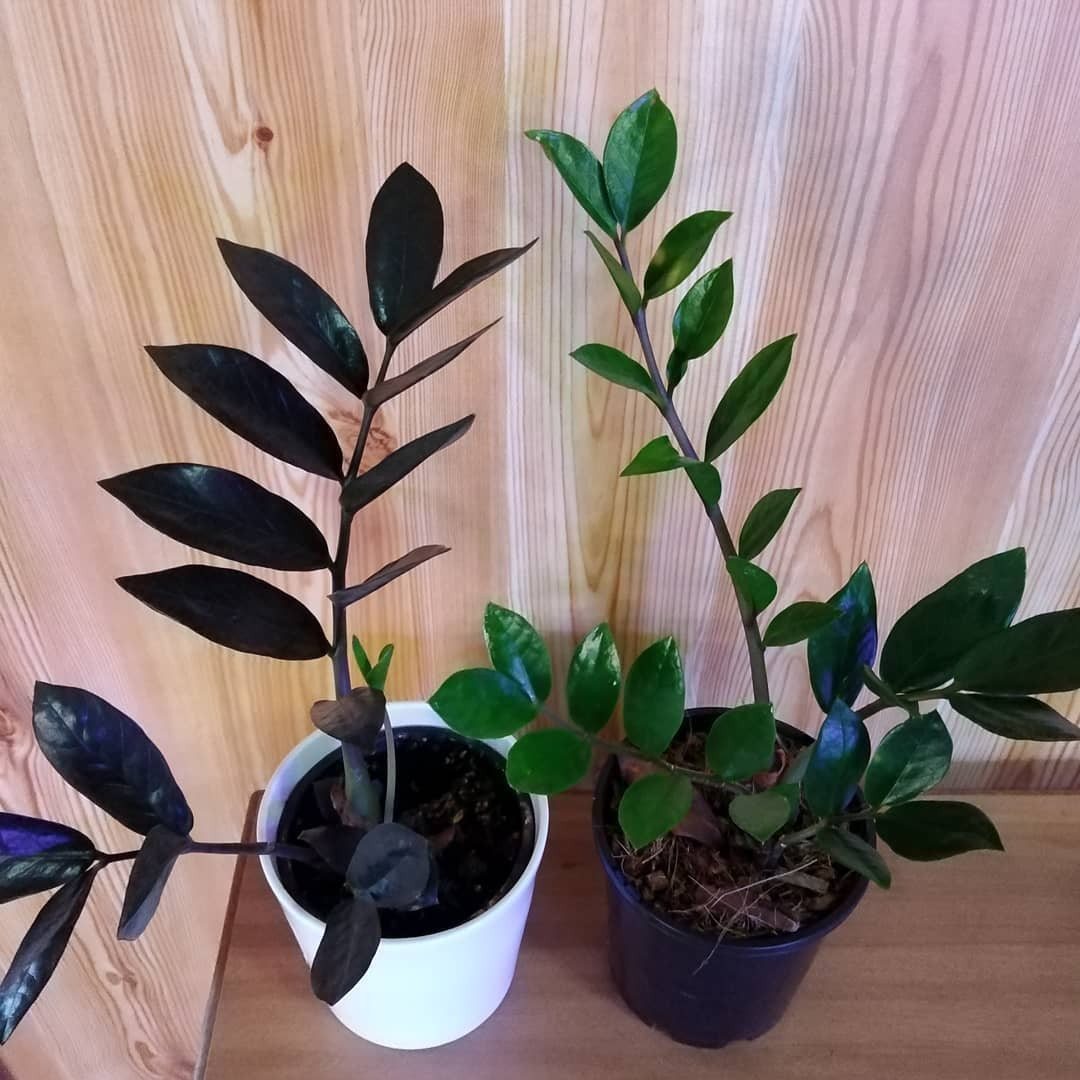
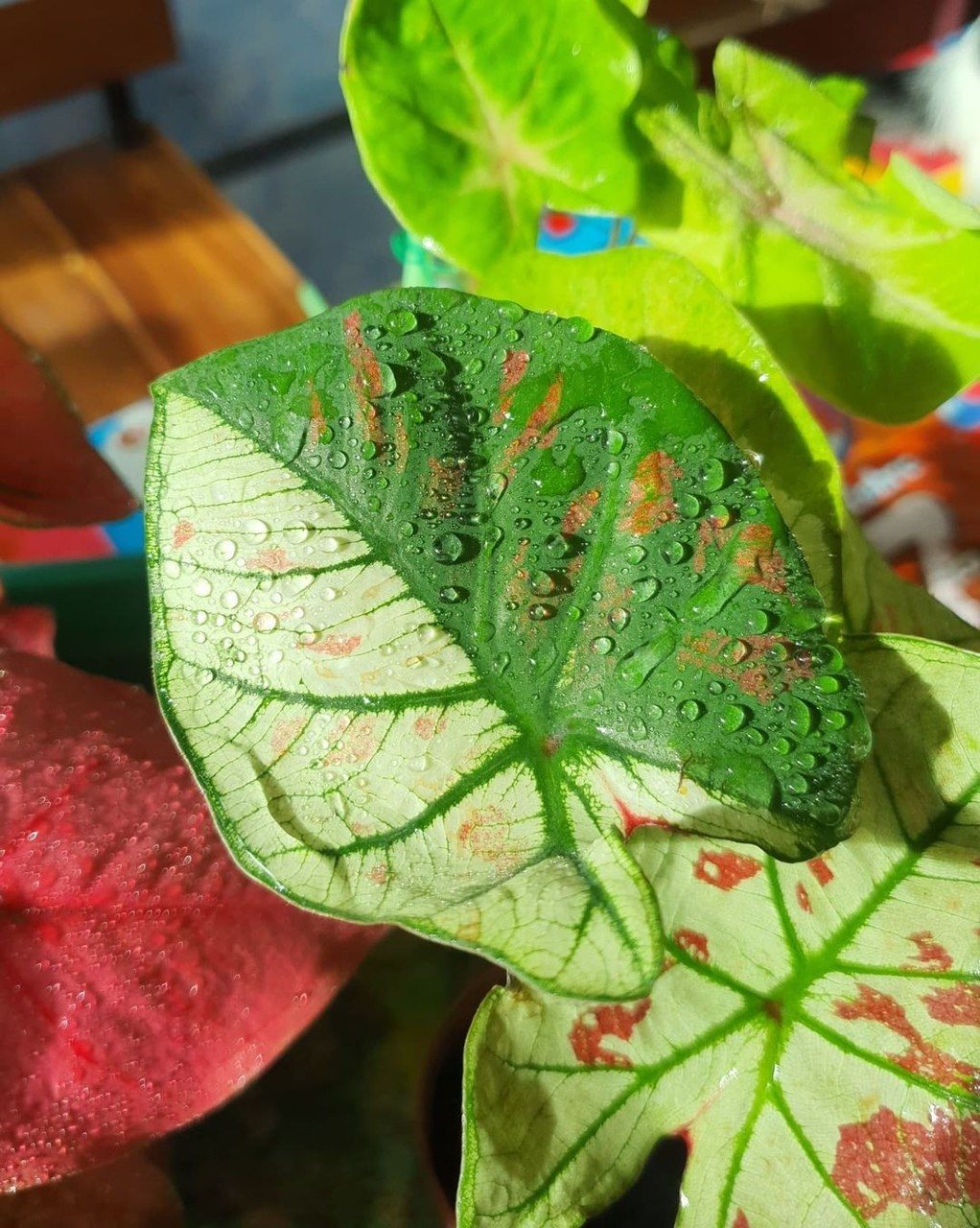
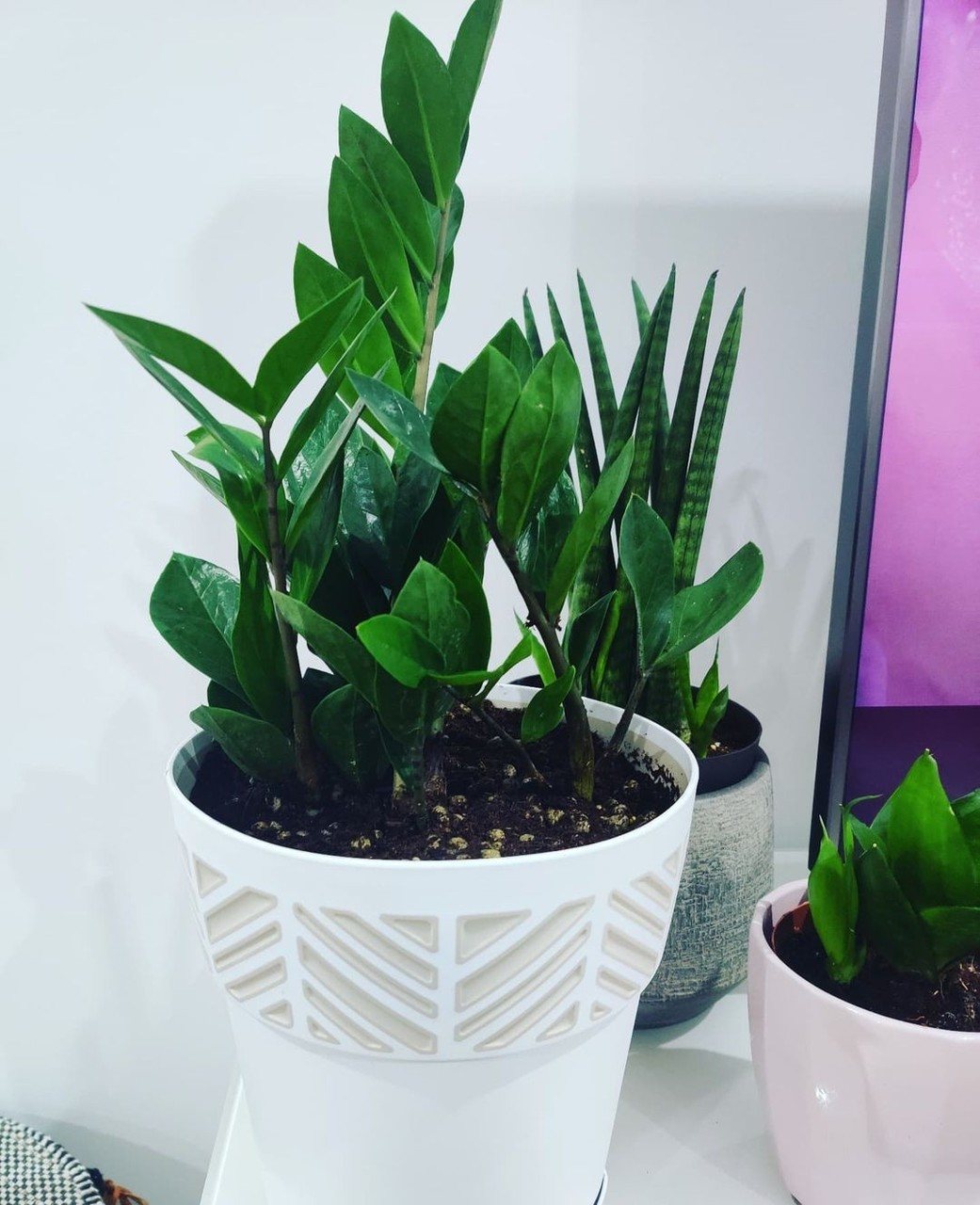
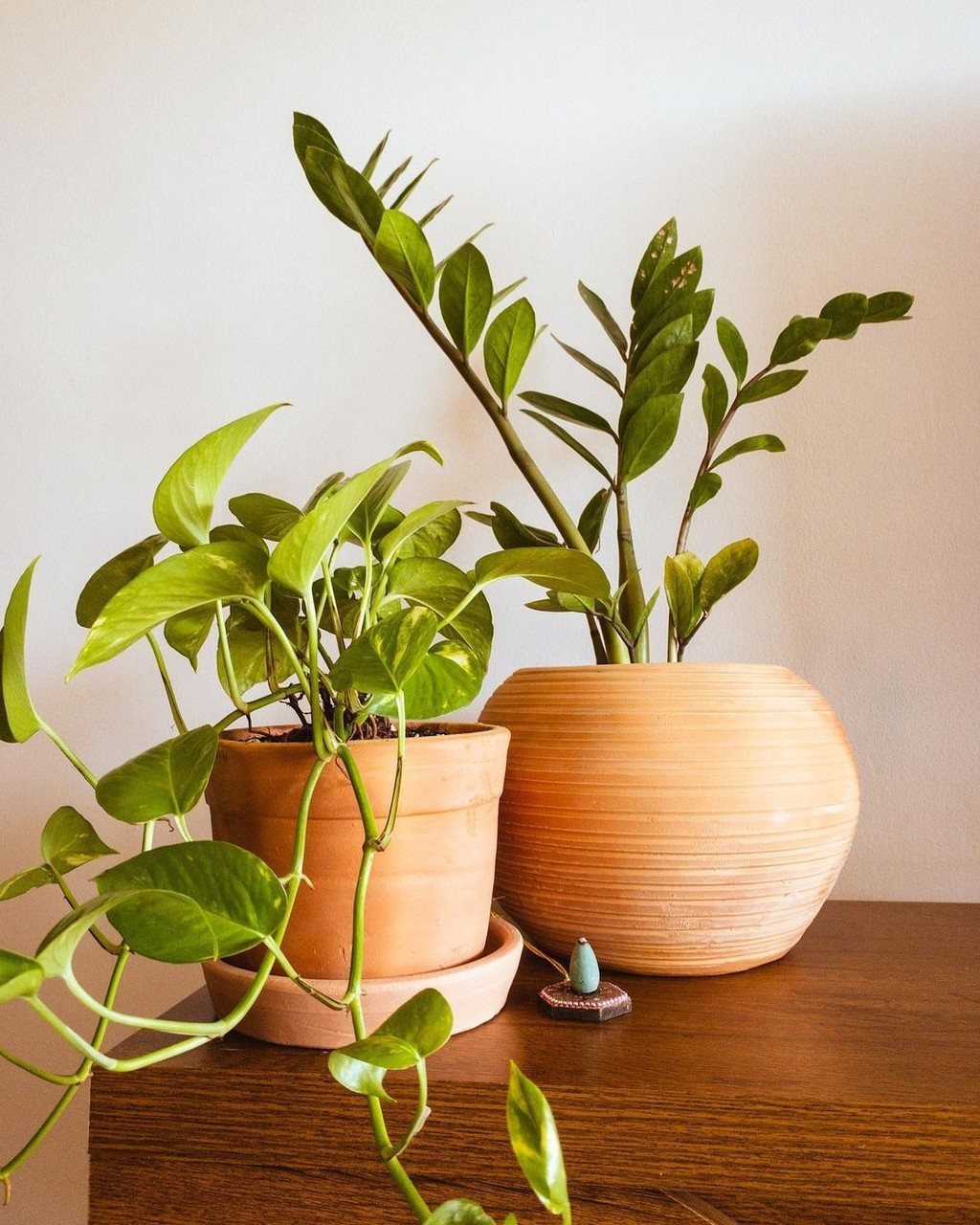
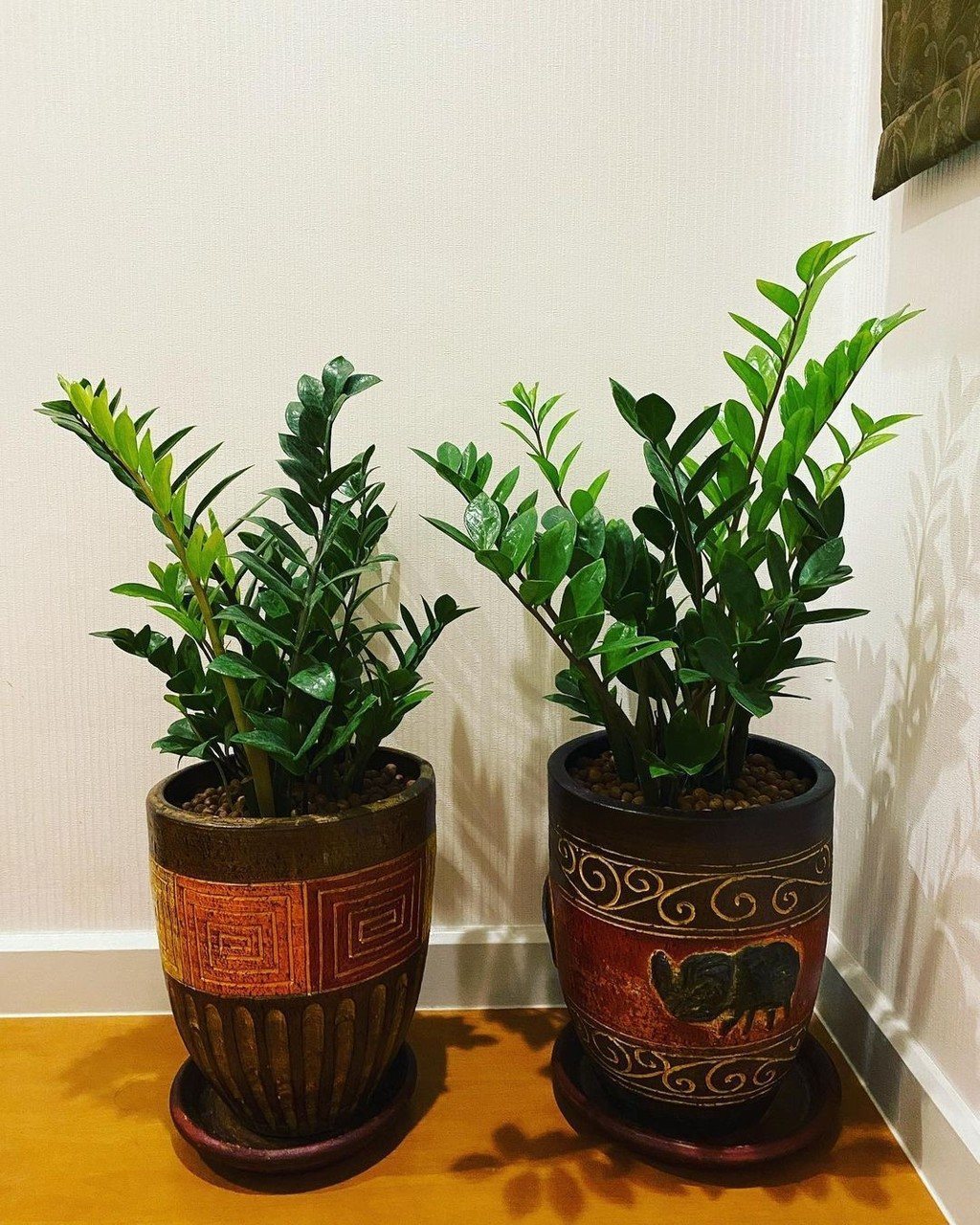
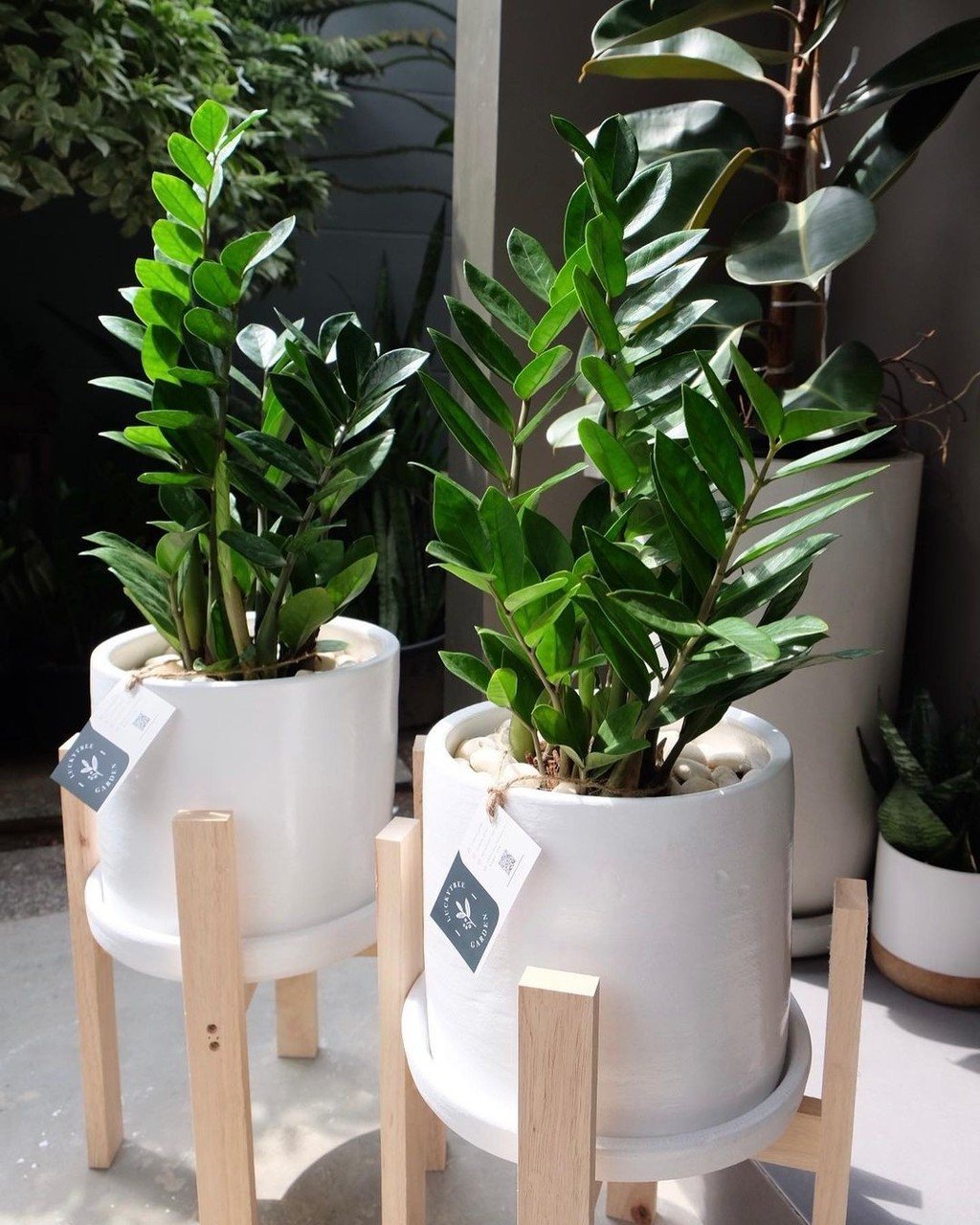
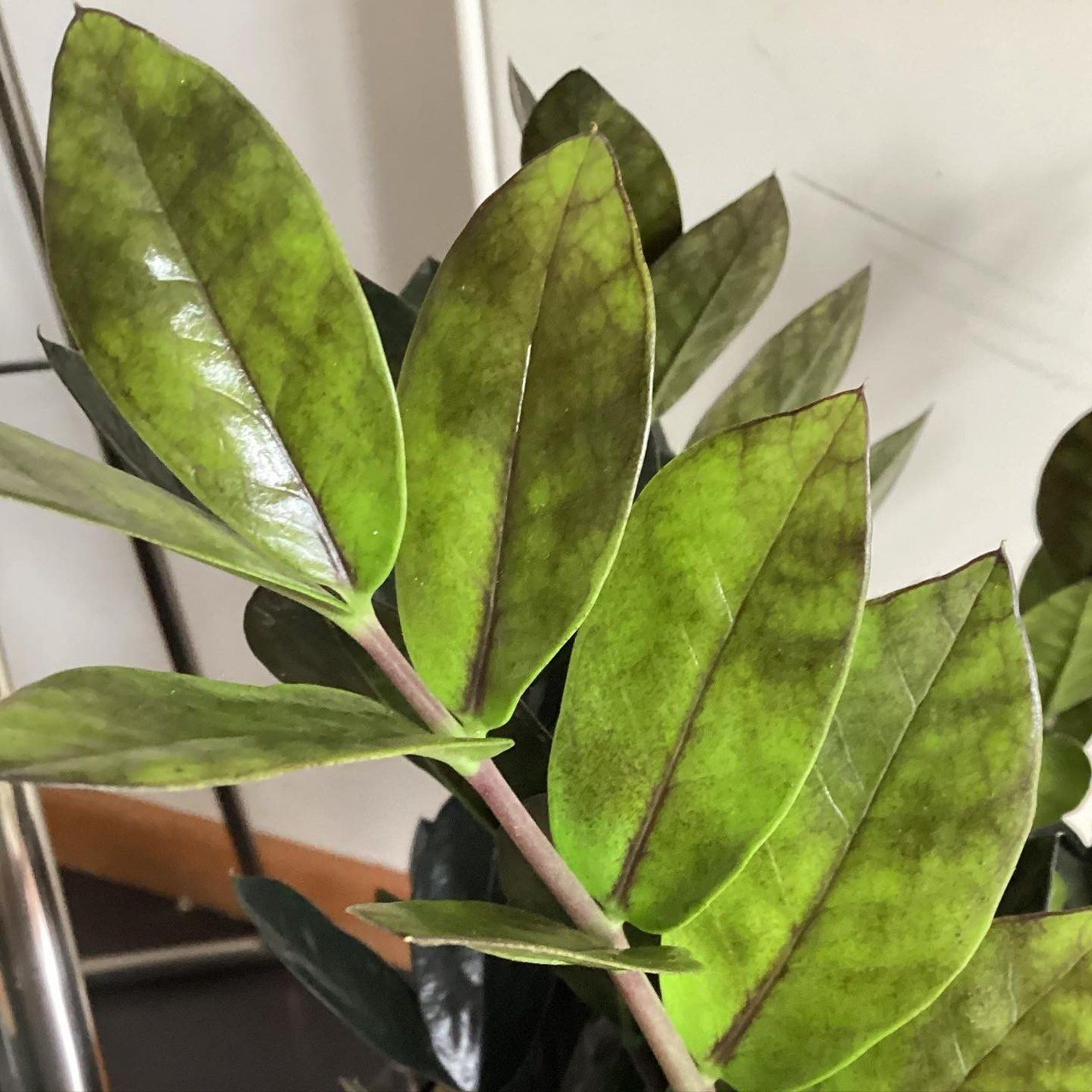
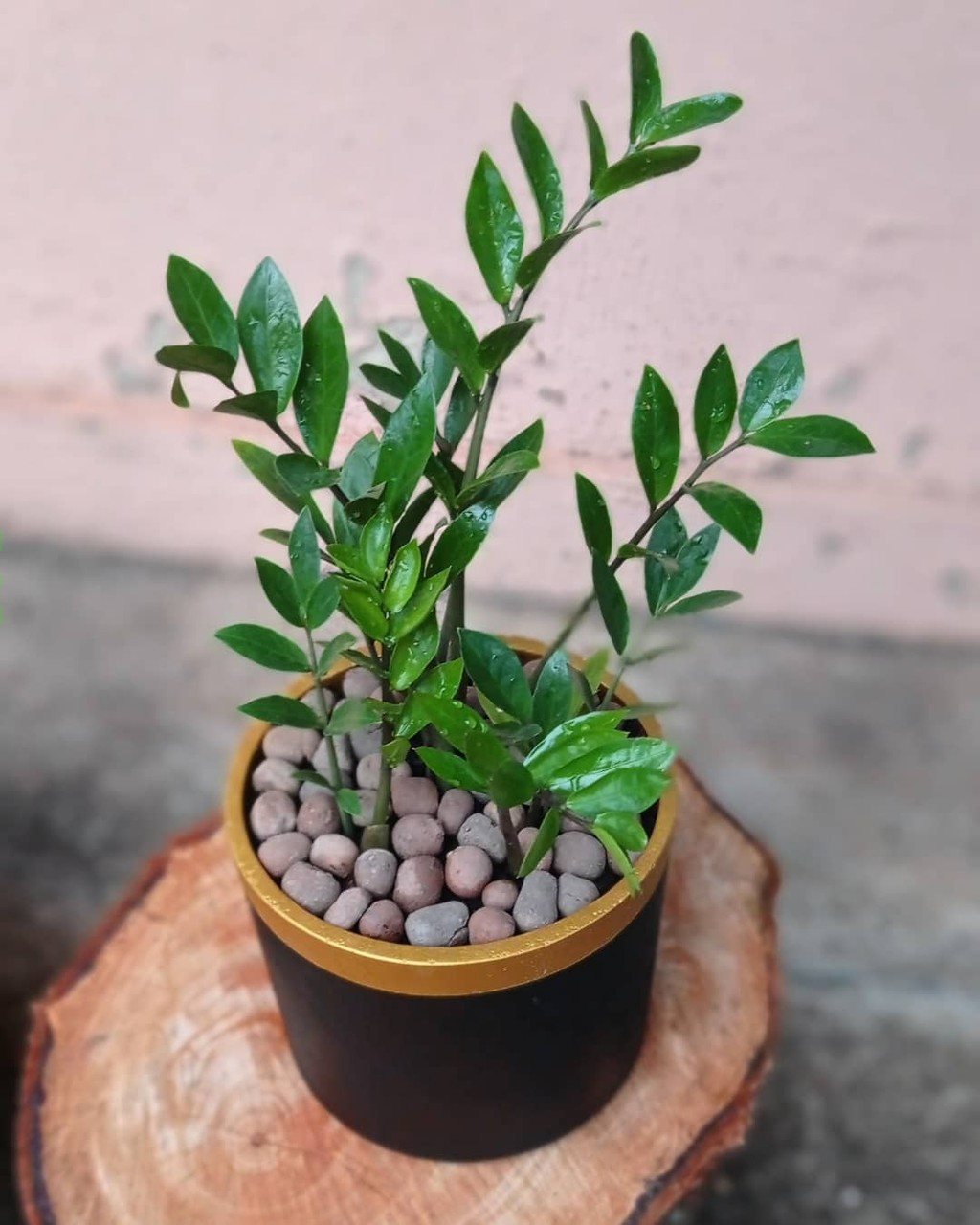










Anthracnose
Powdery mildew
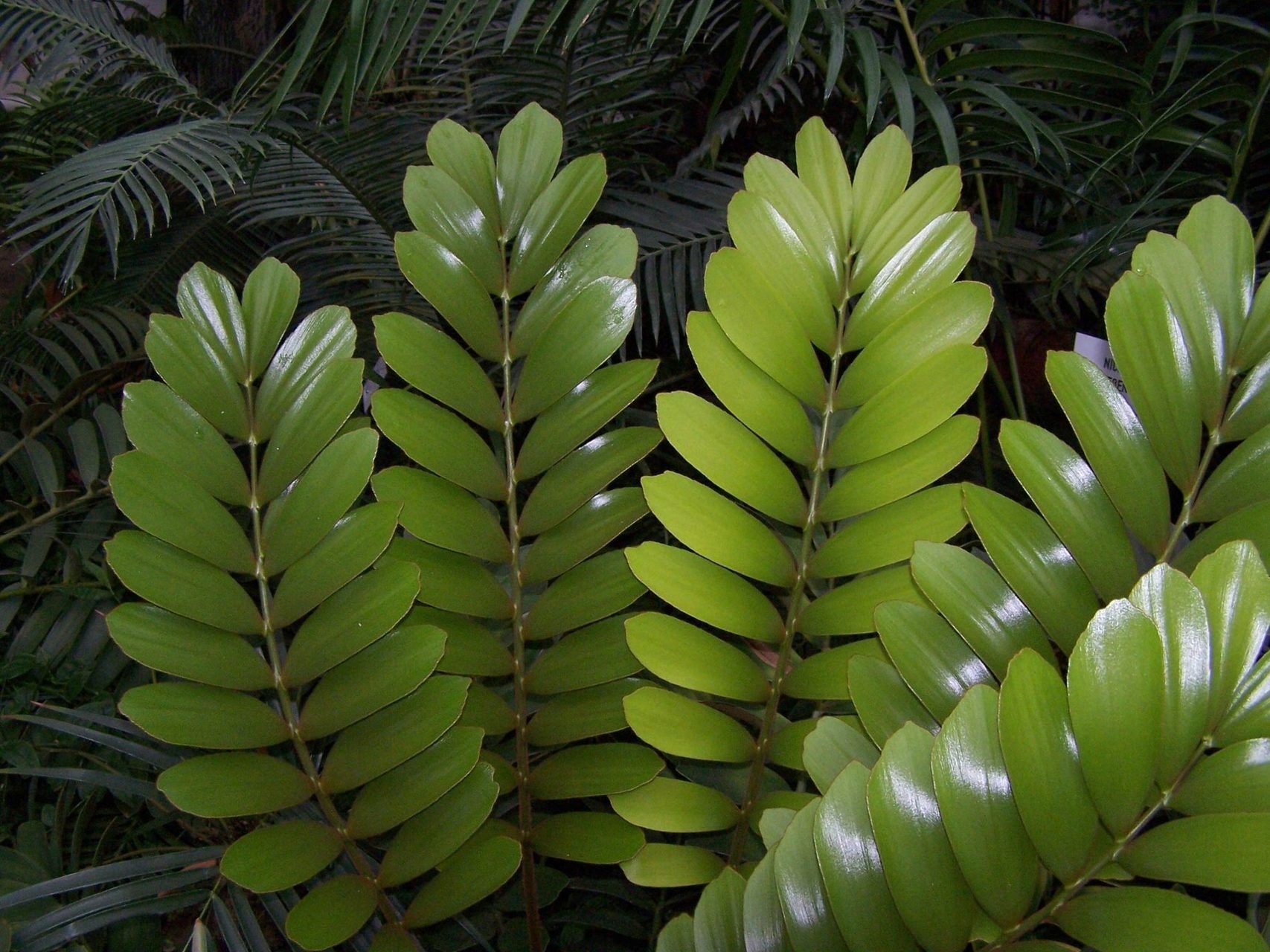
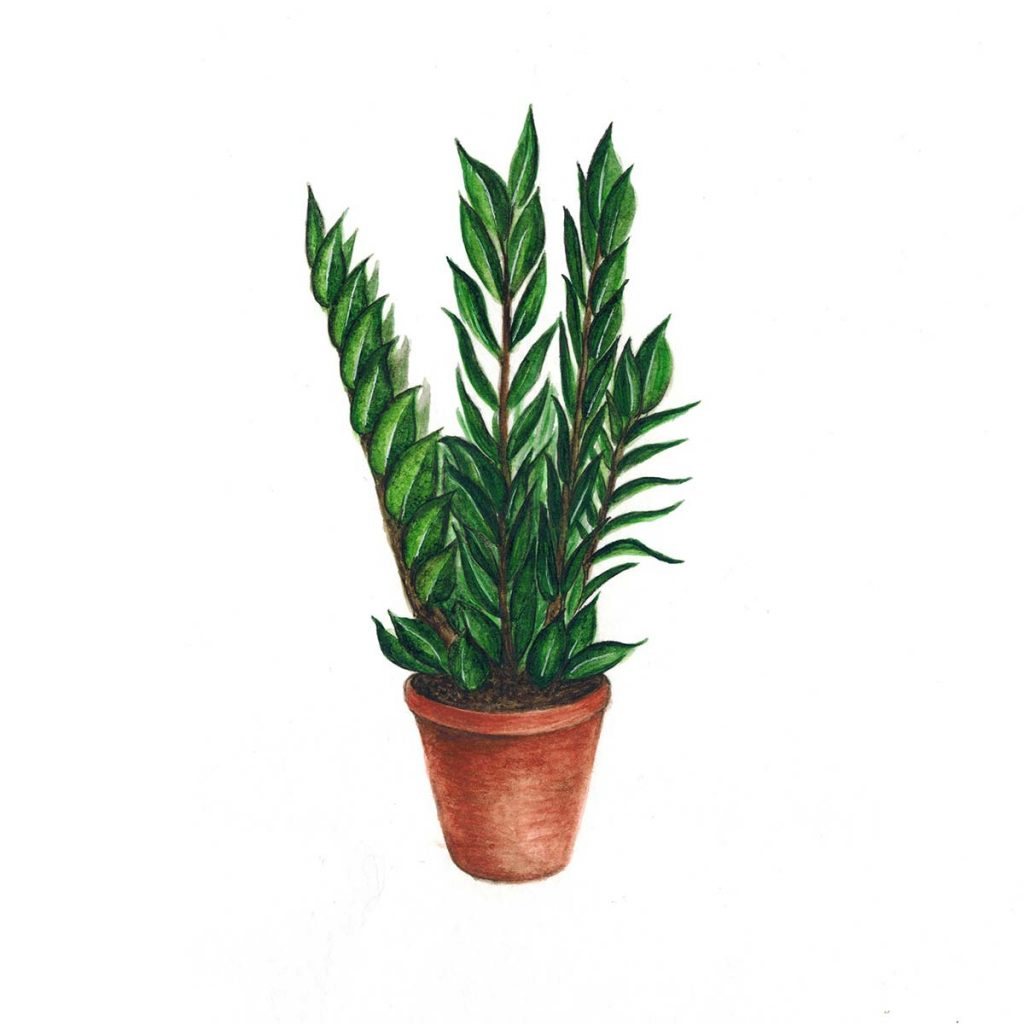

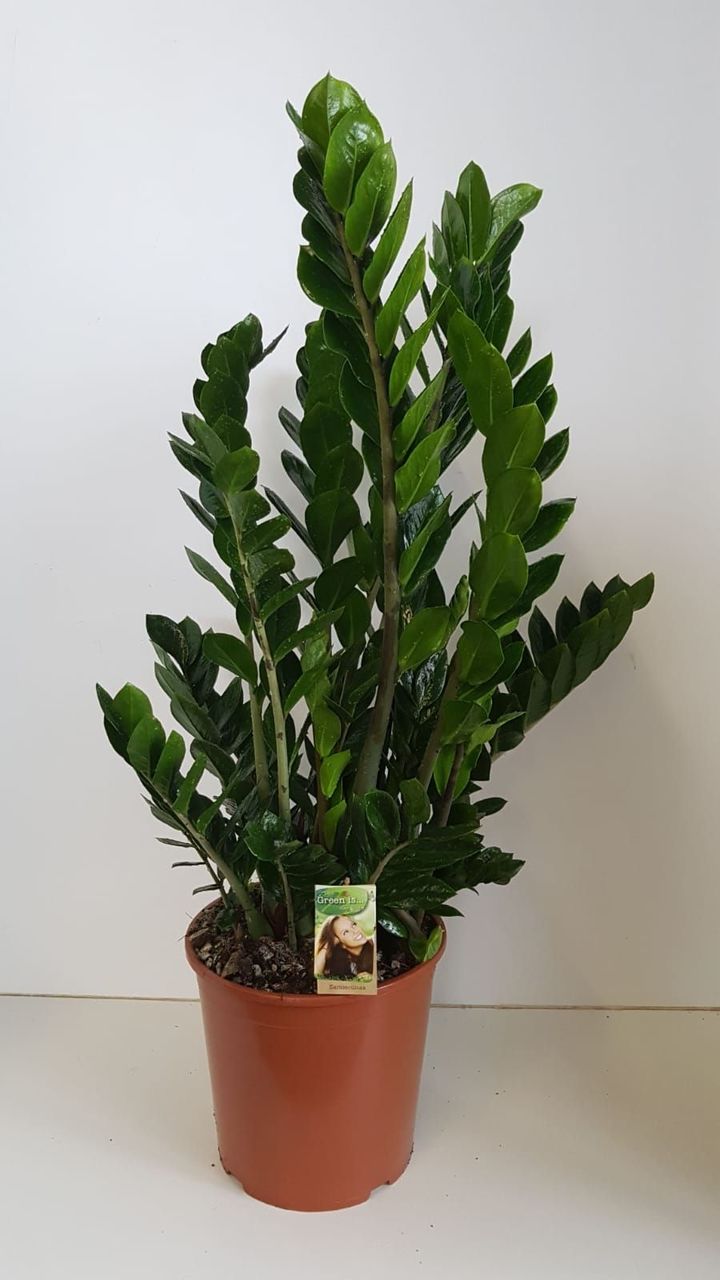
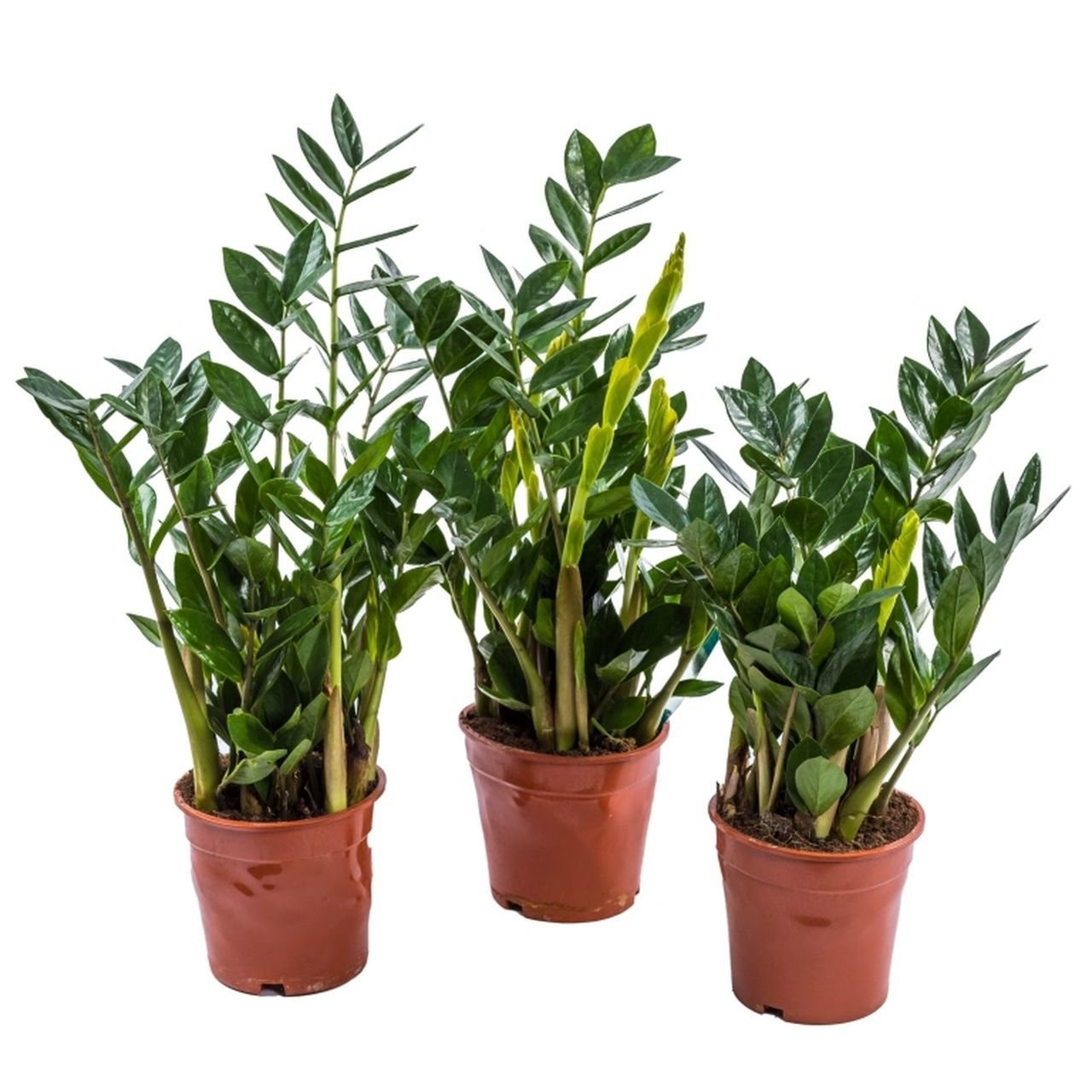
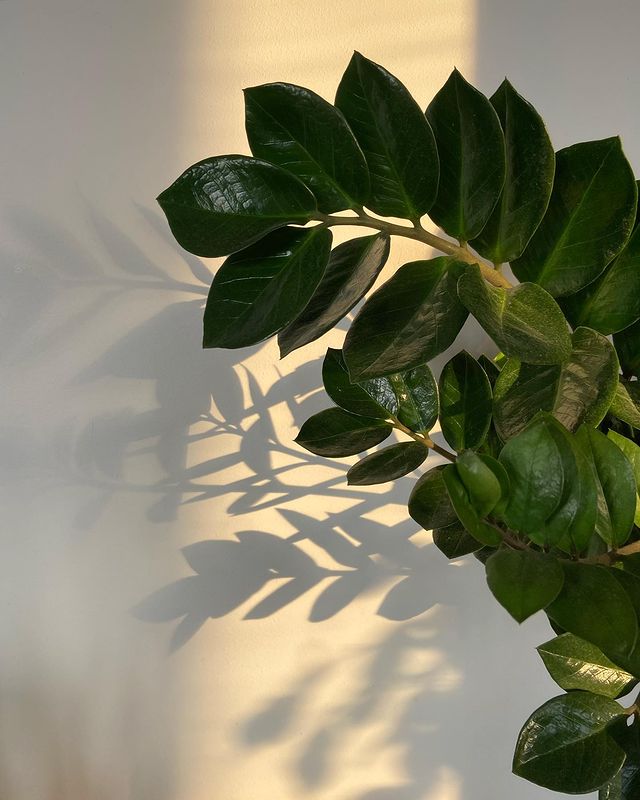
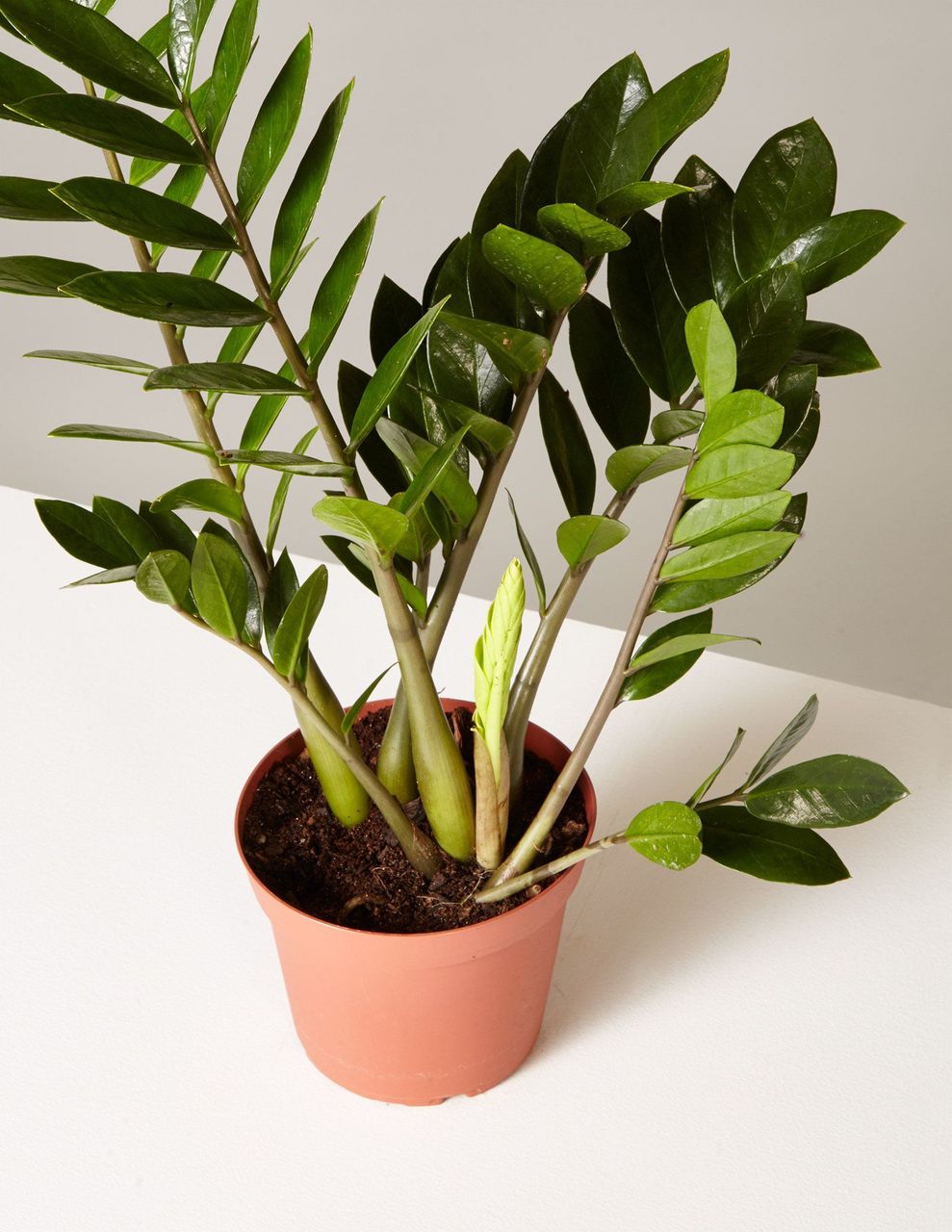
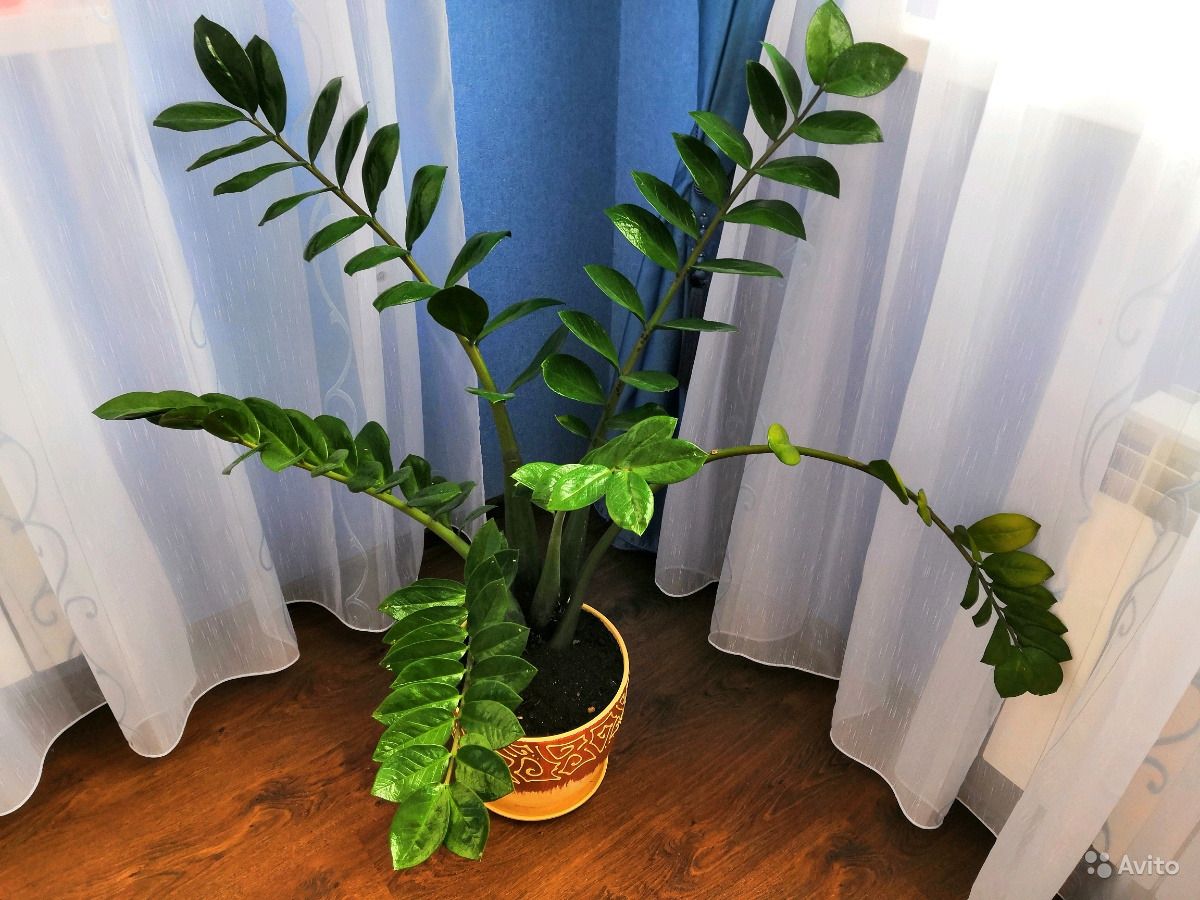
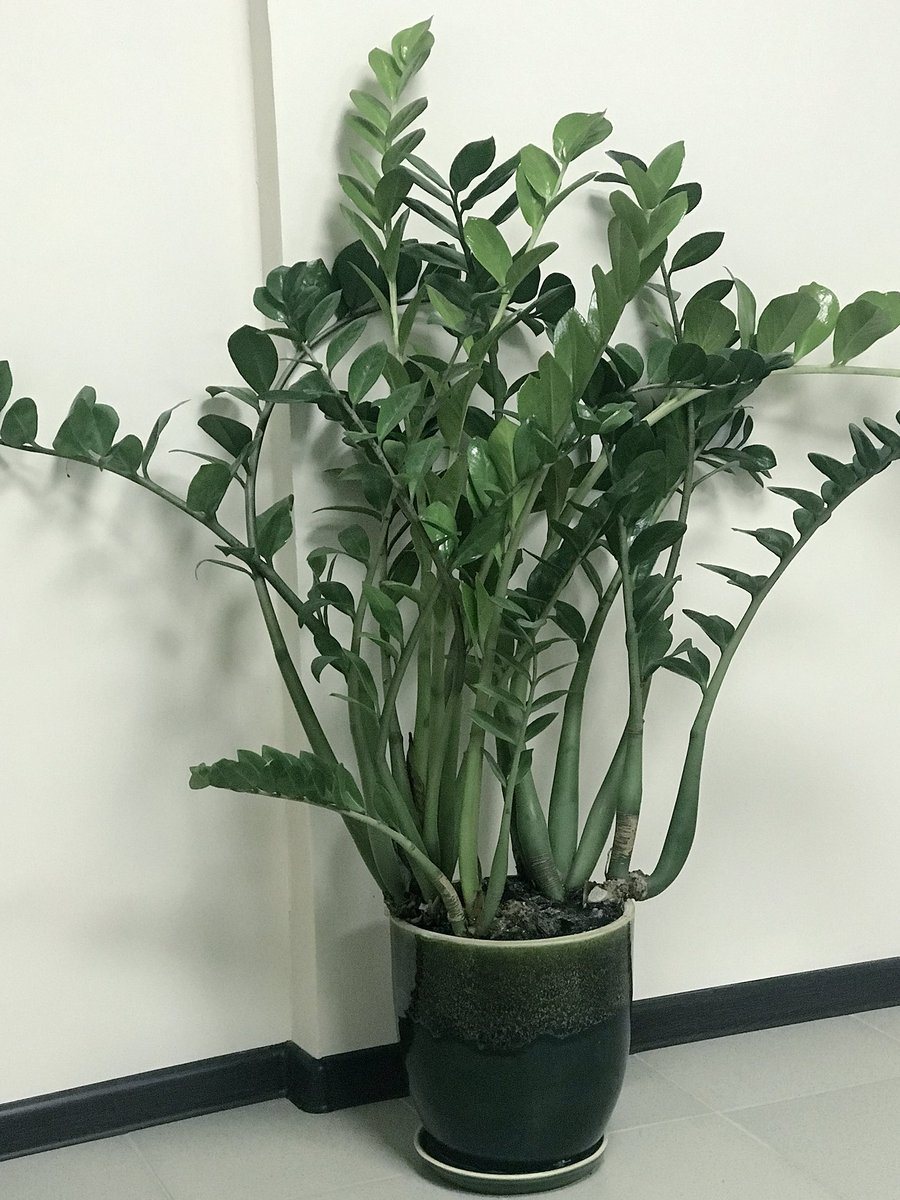
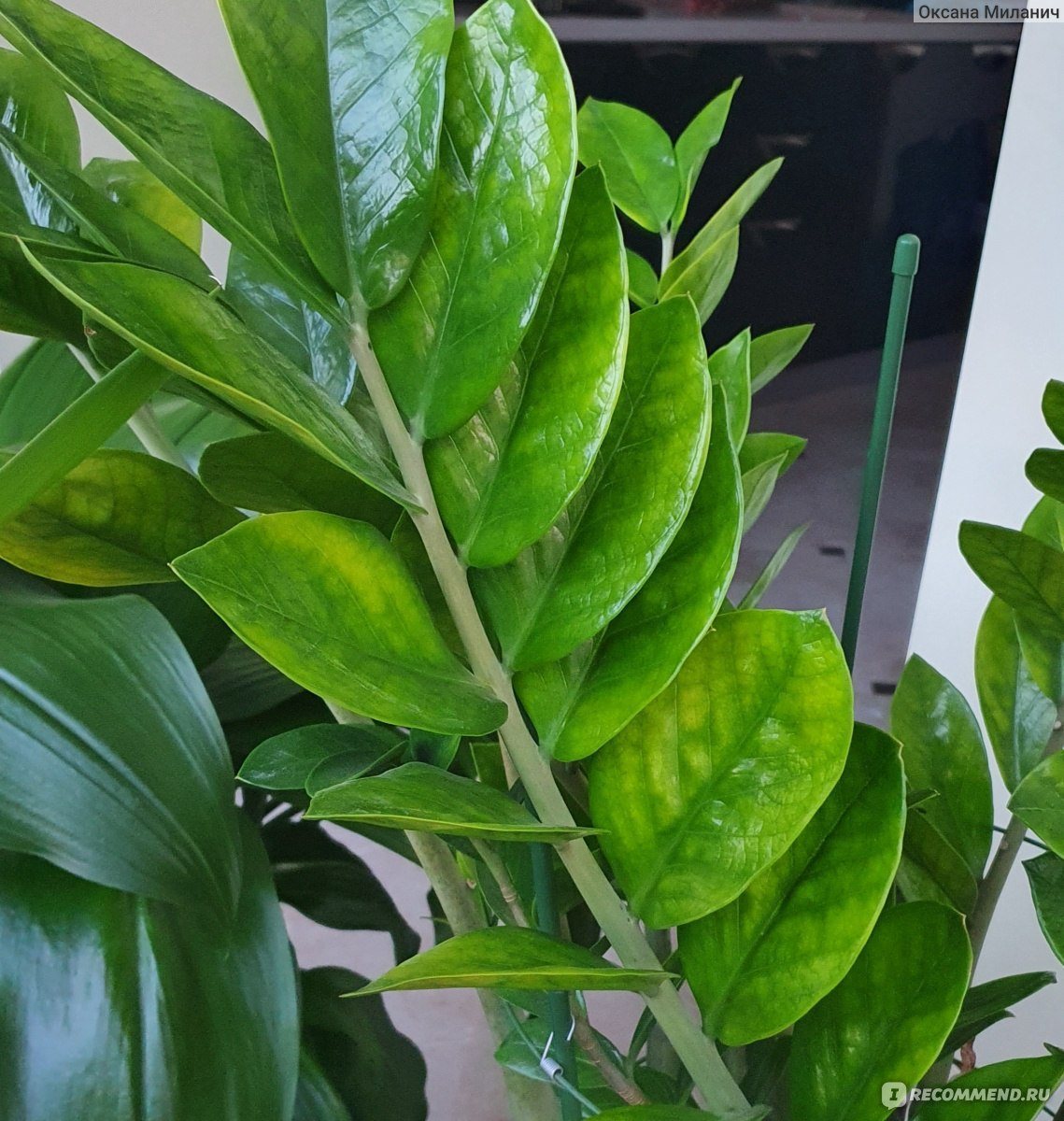










Sooty (black) fungi
Pests
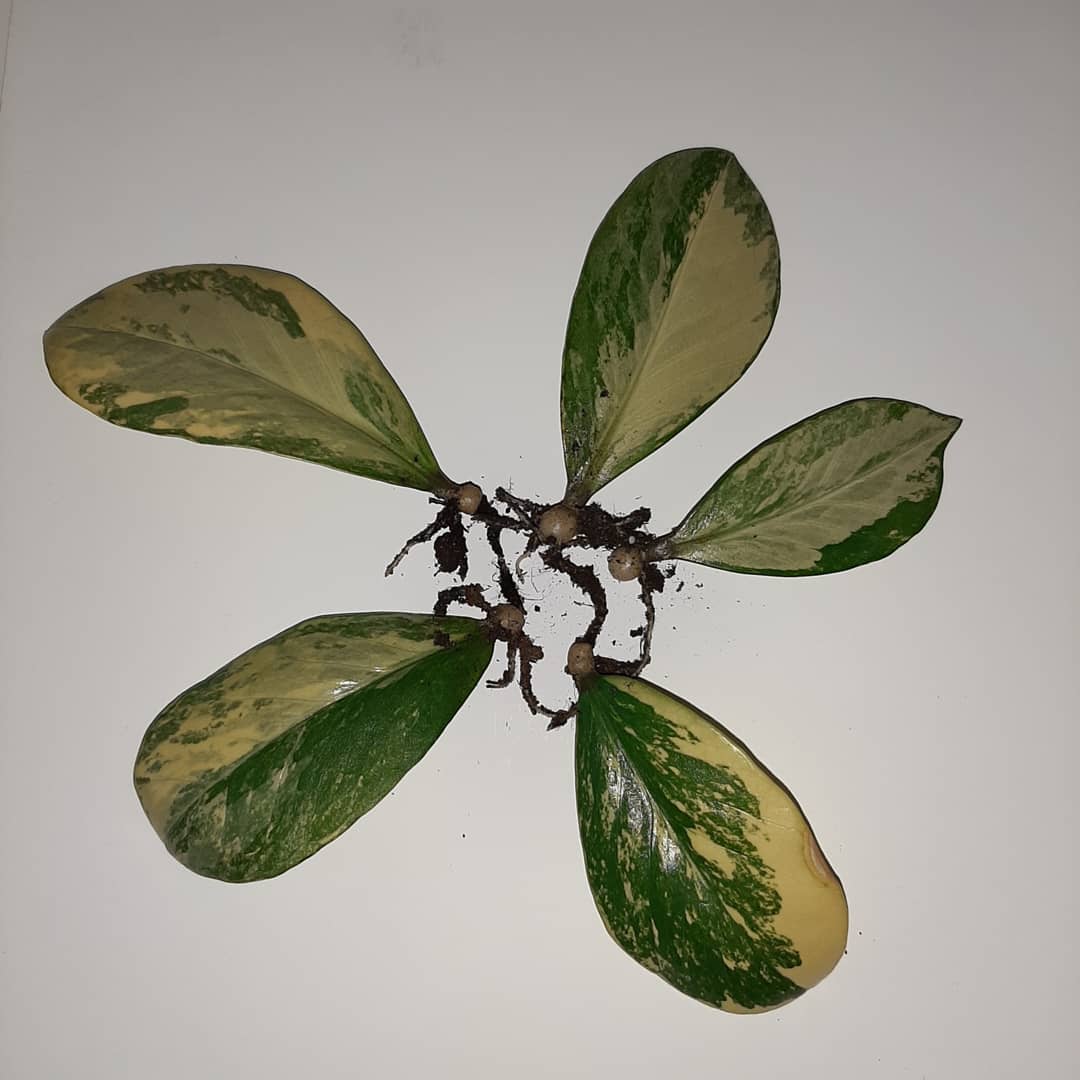
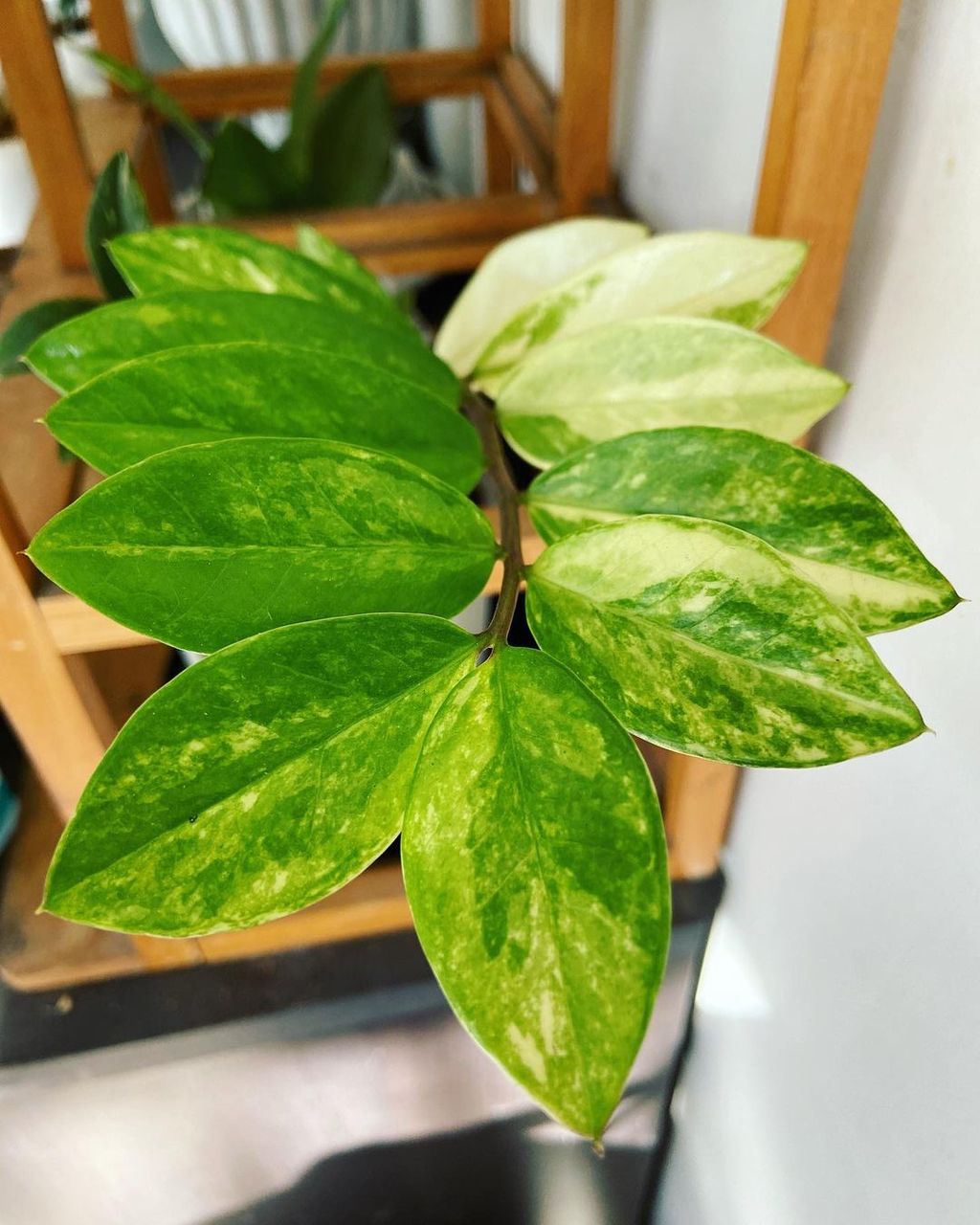
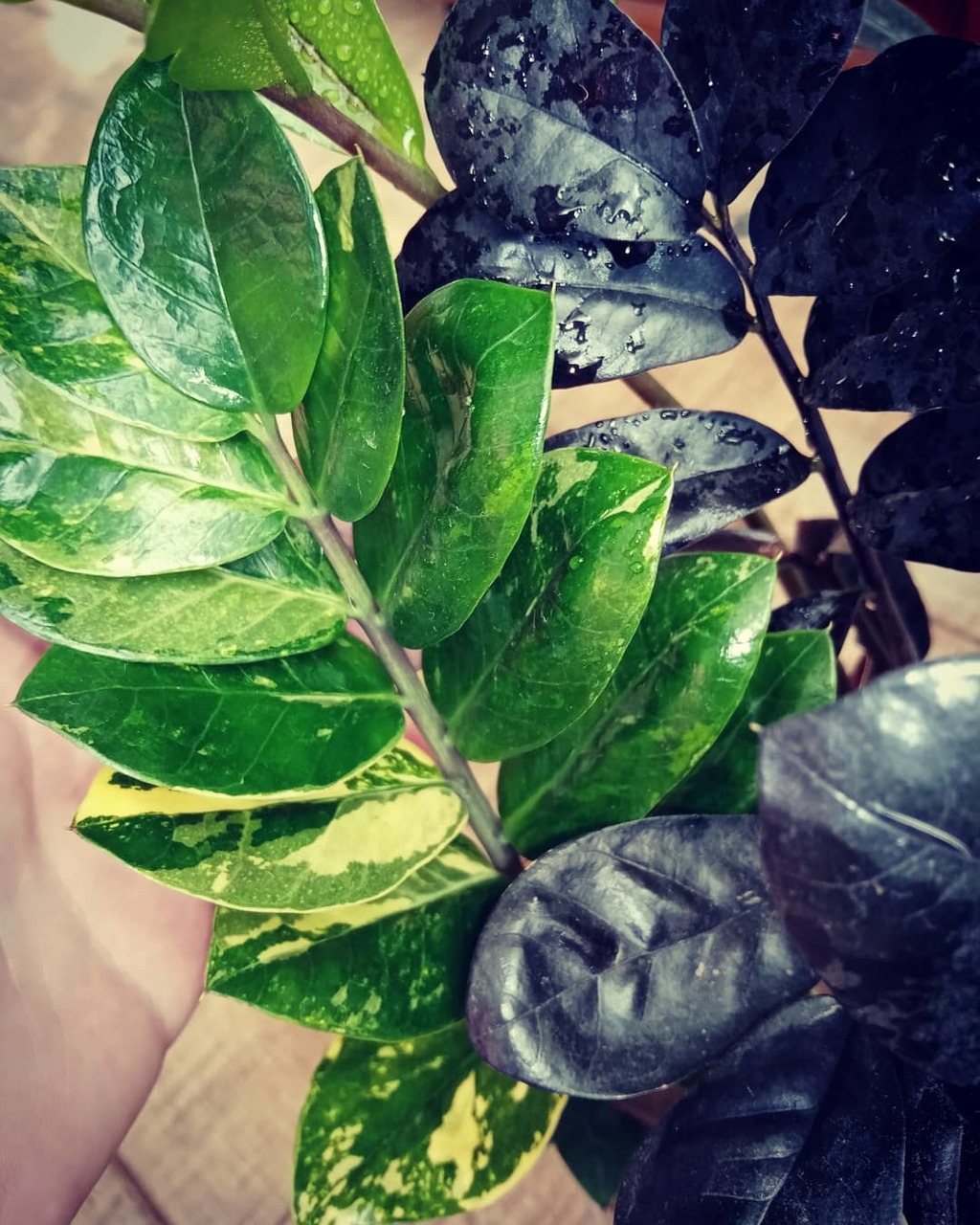
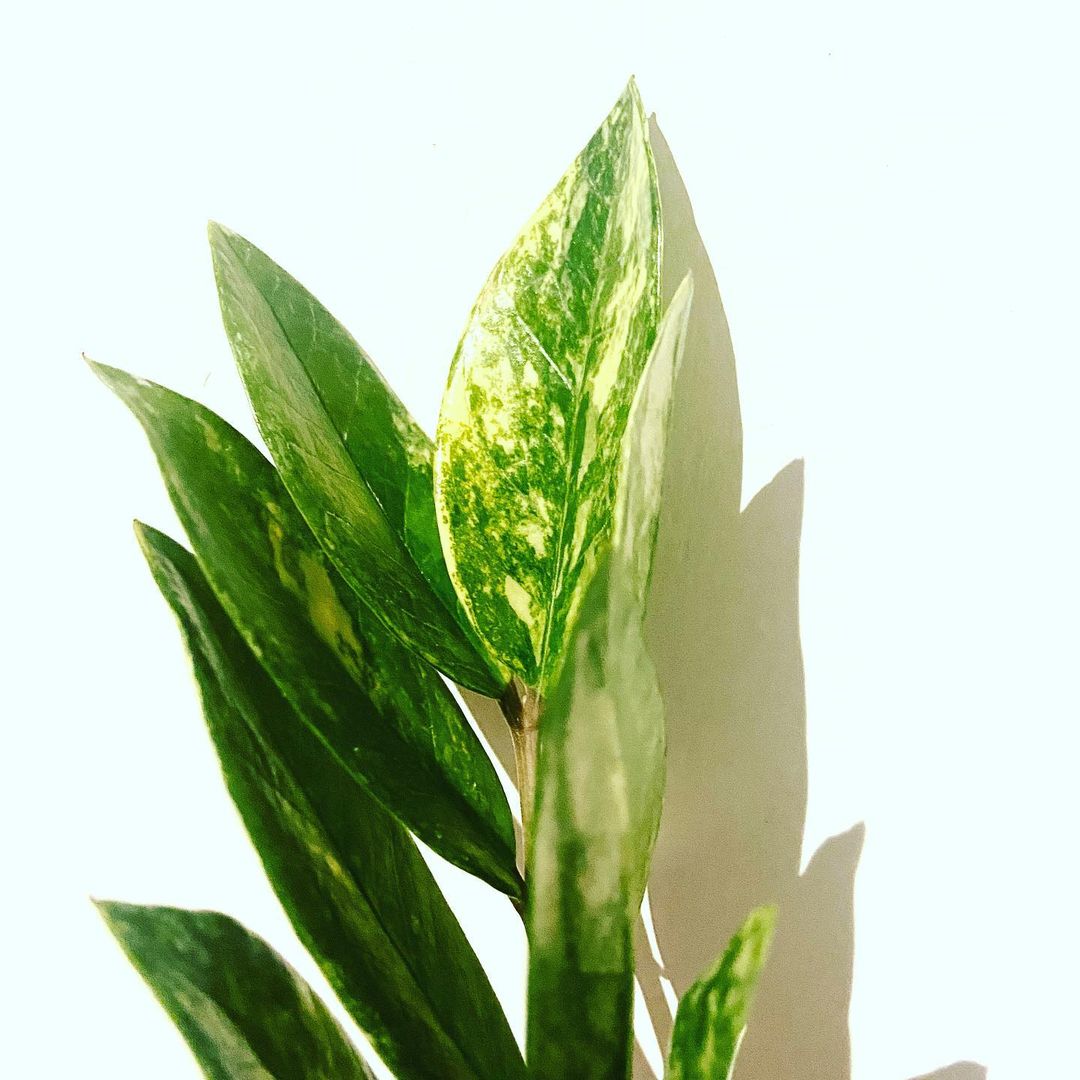
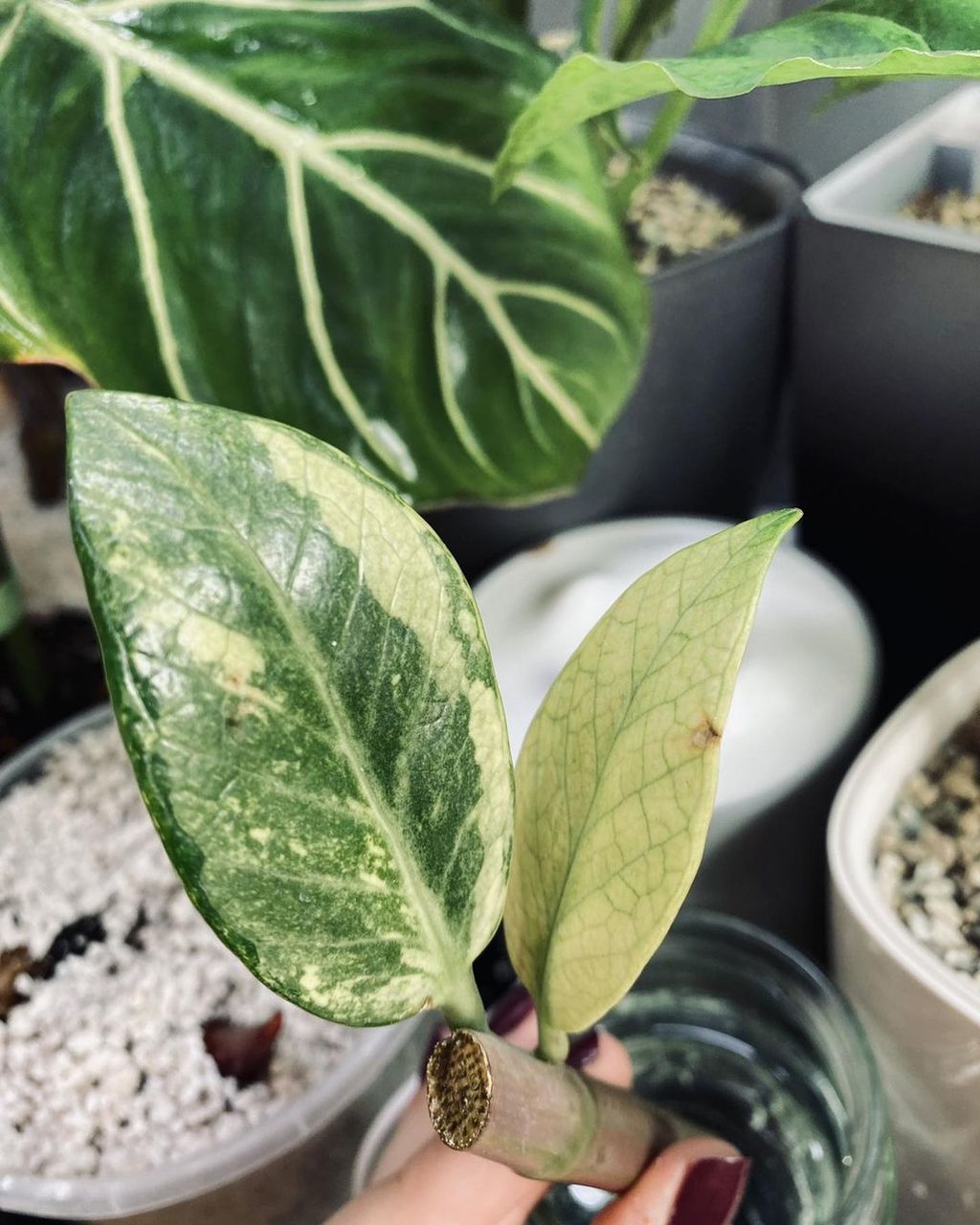
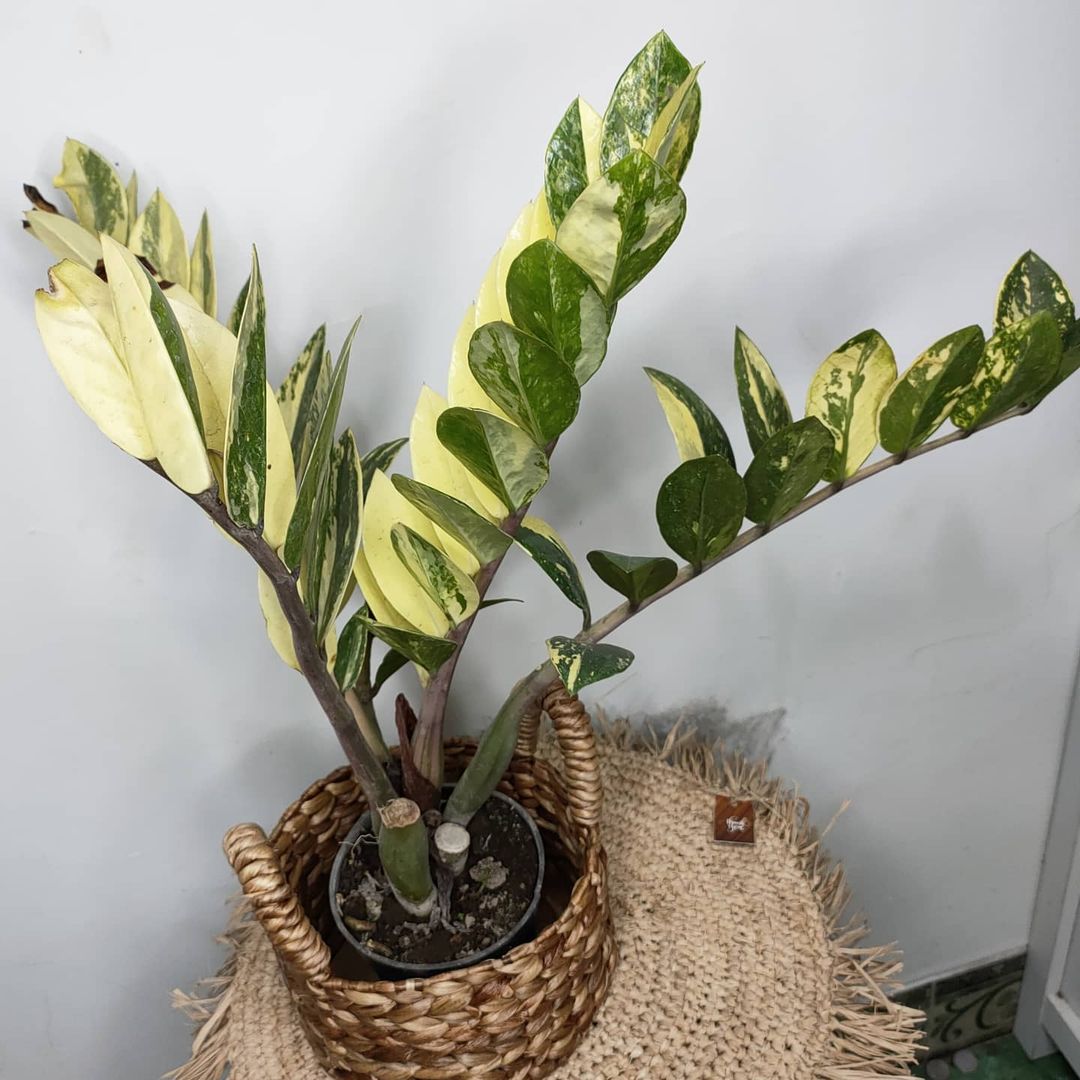
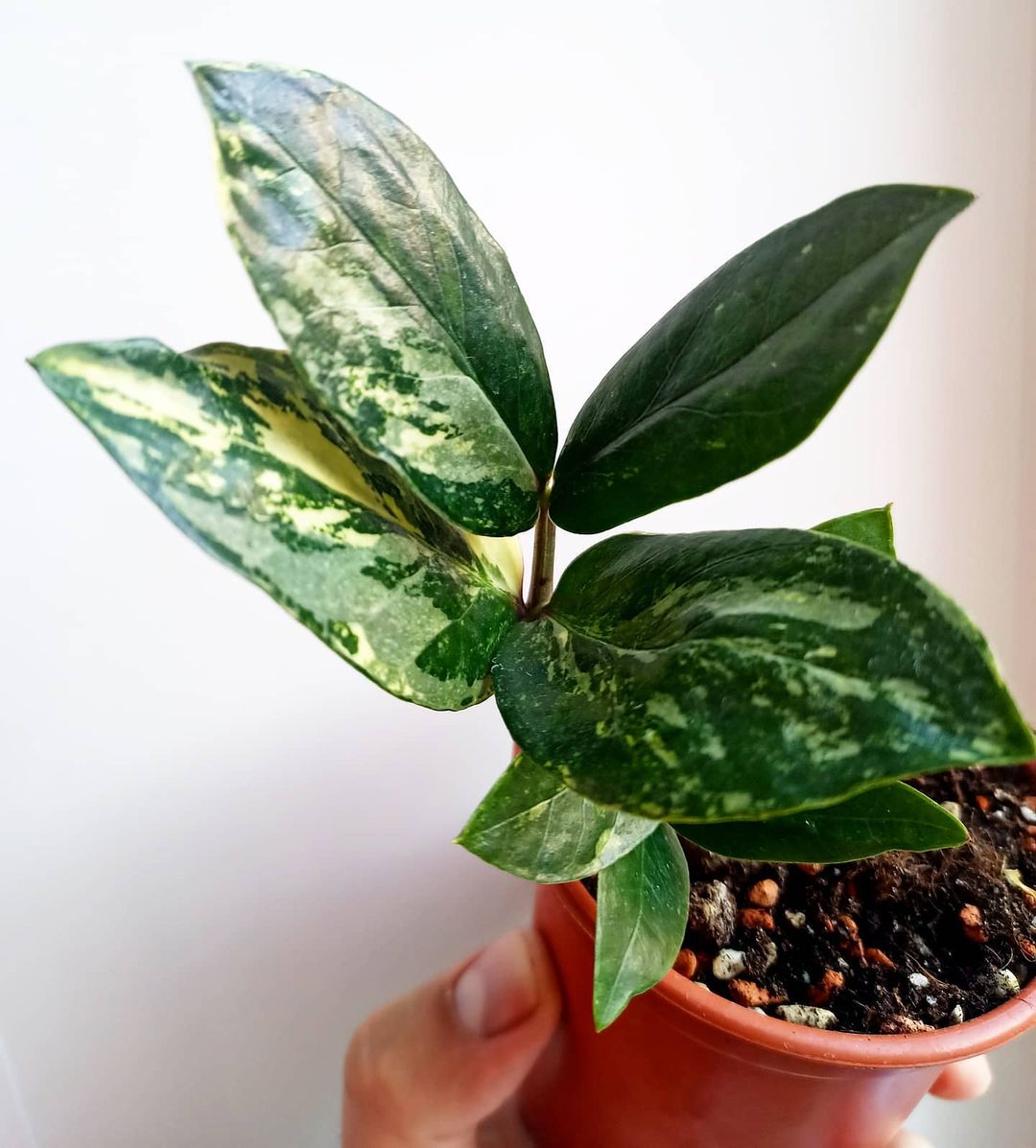
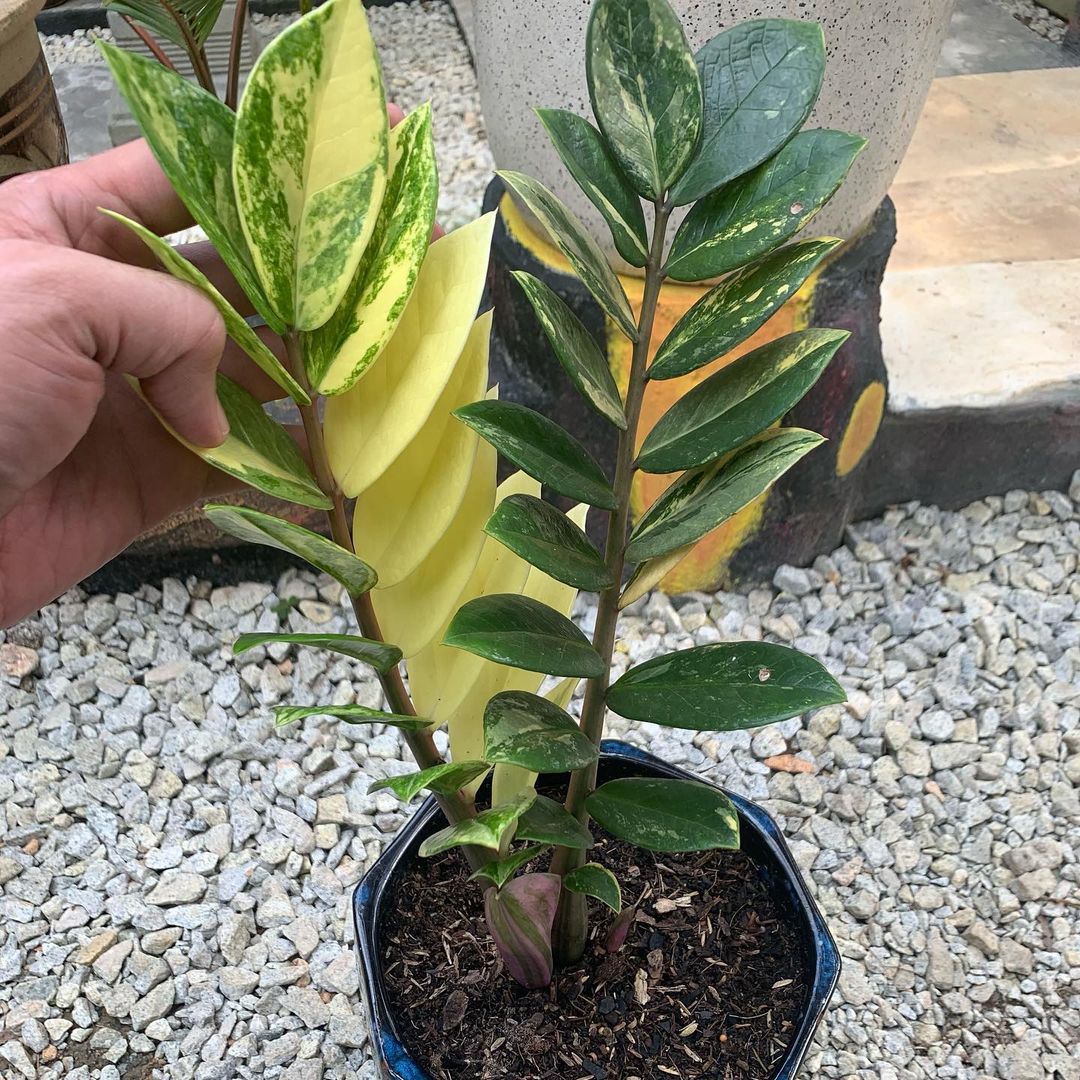
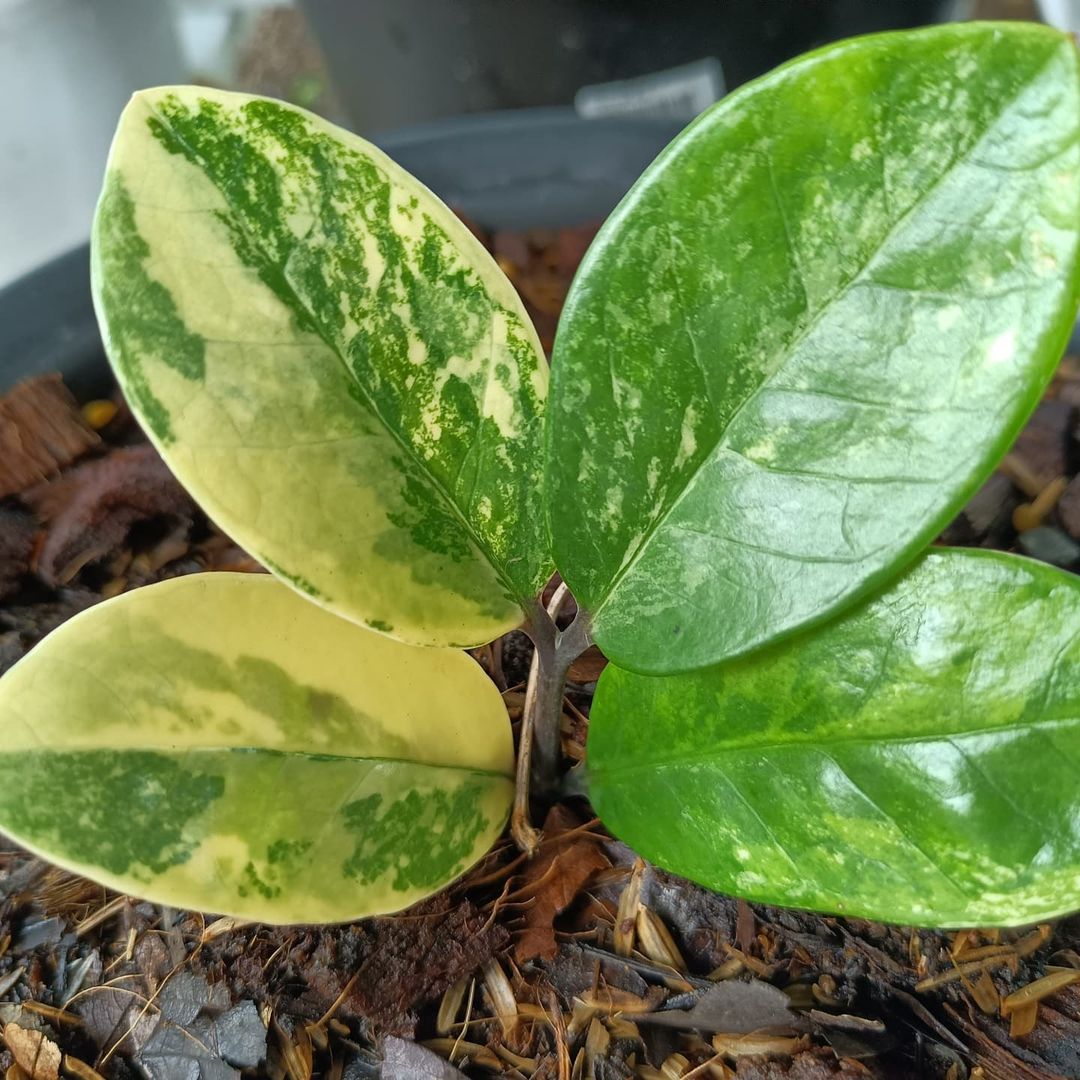
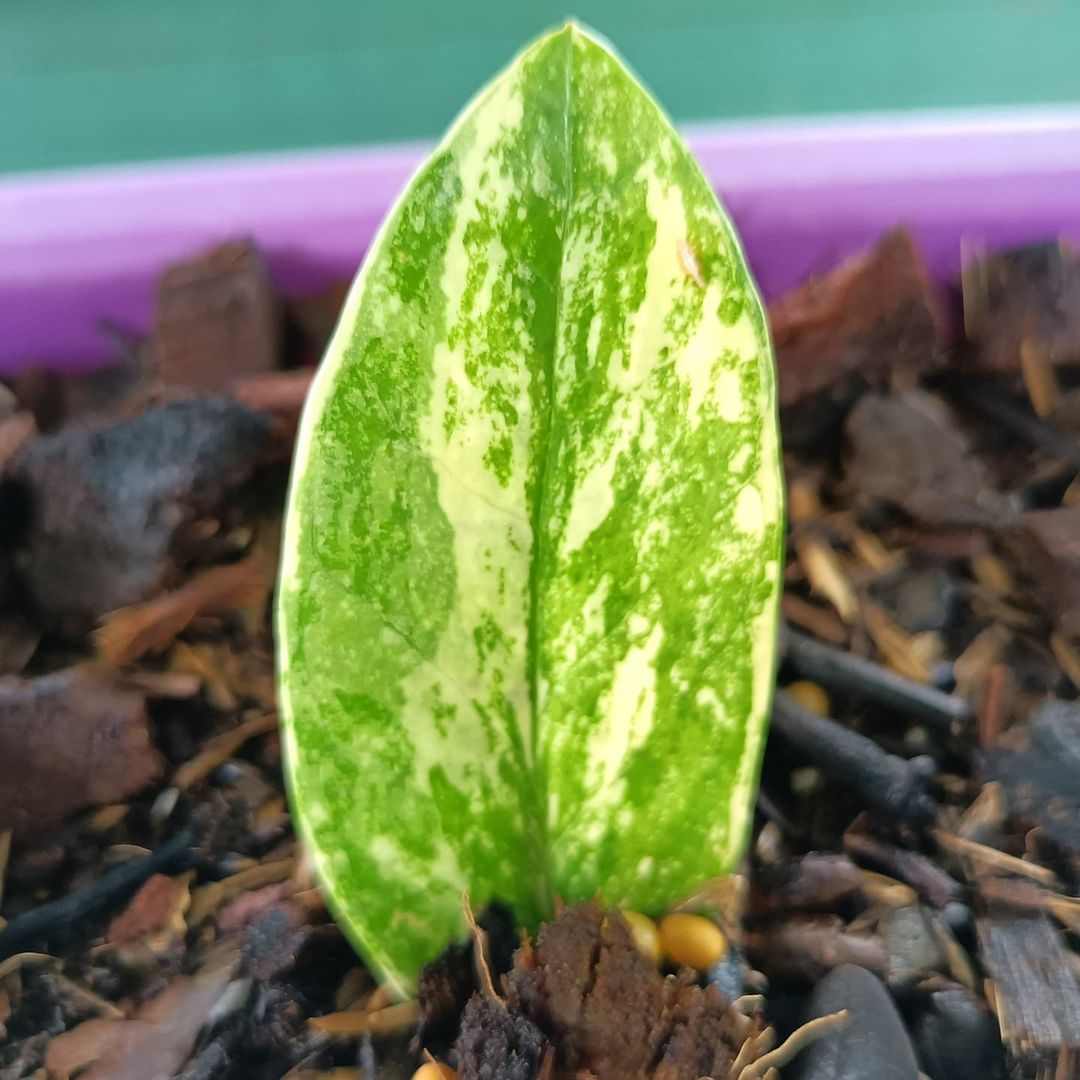










Aphid
Thrips
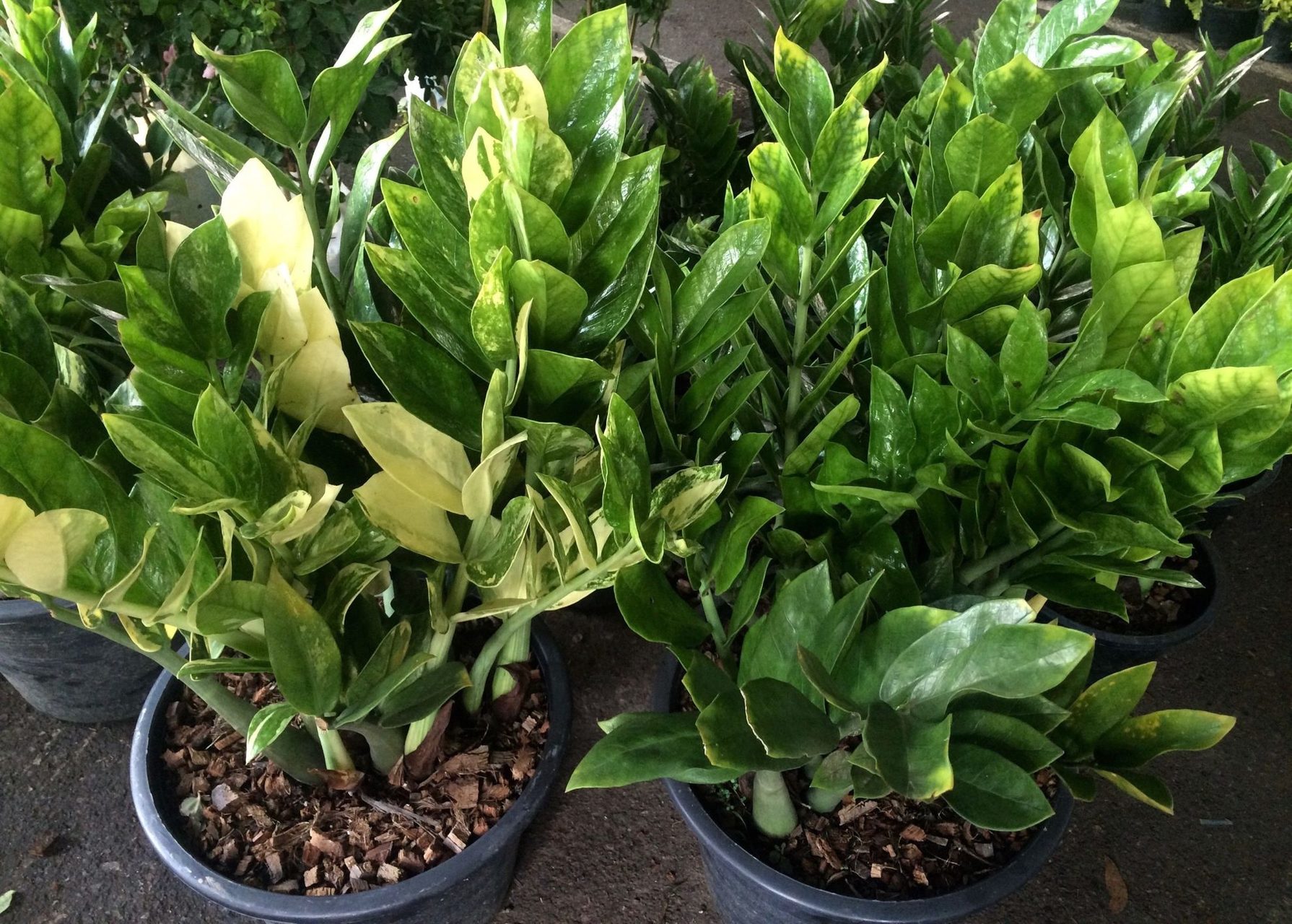
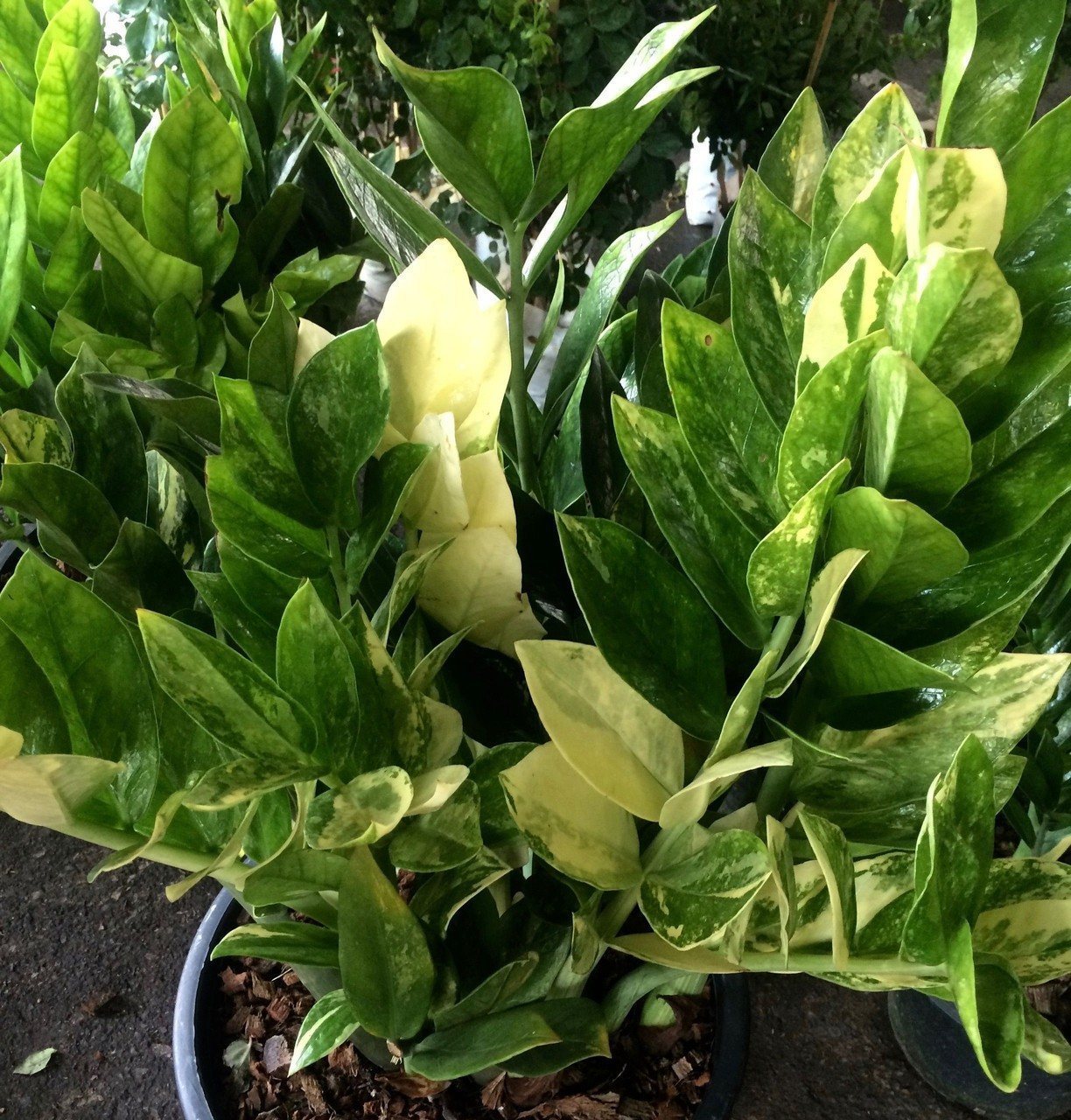
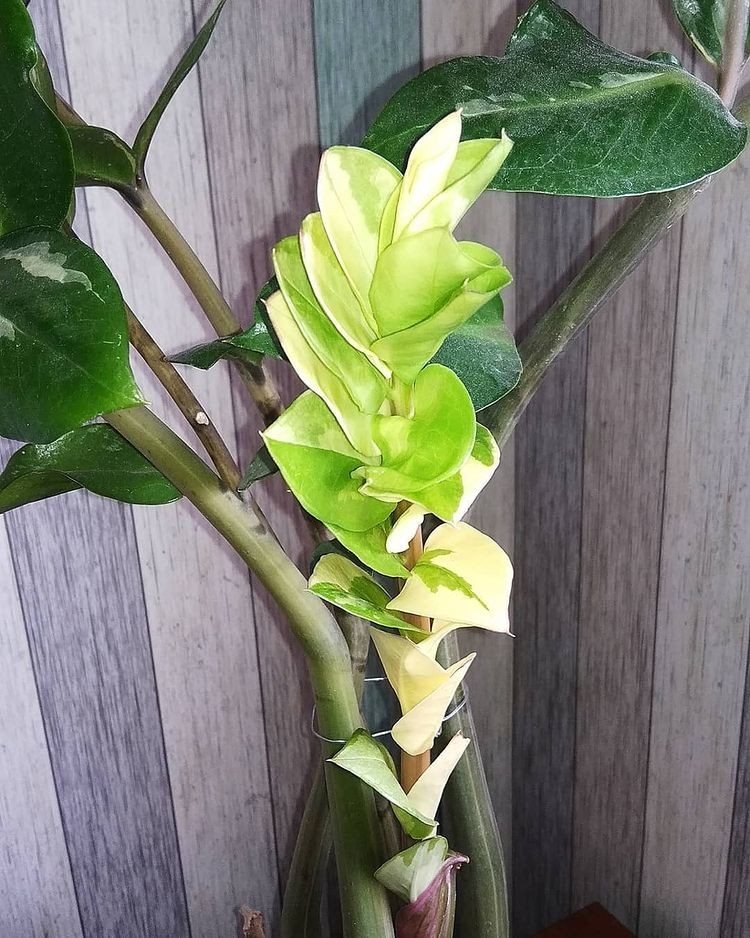
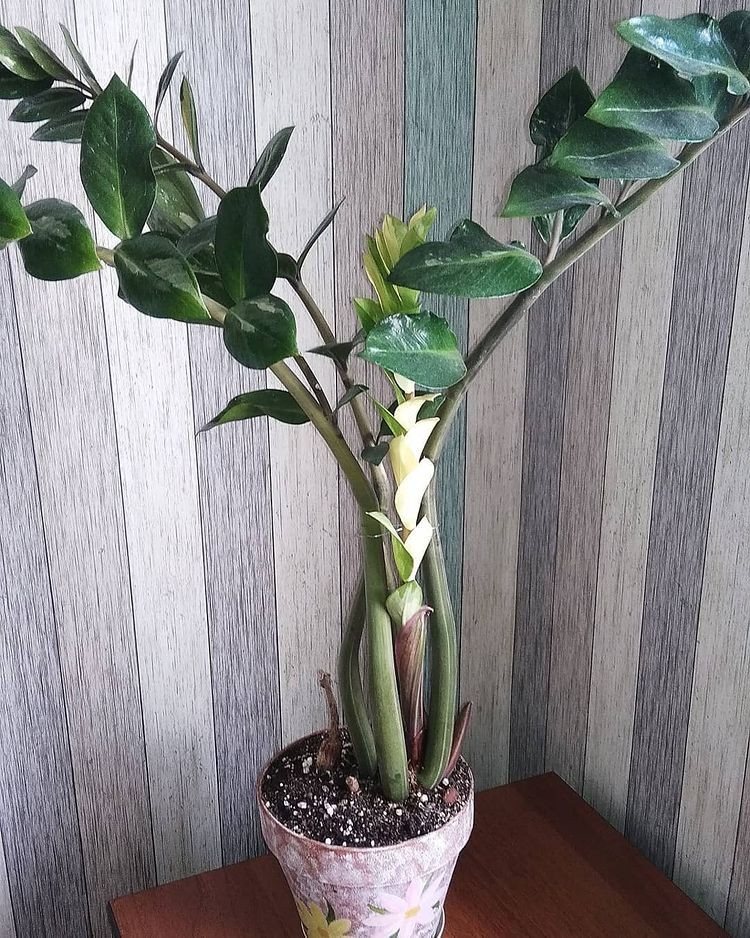

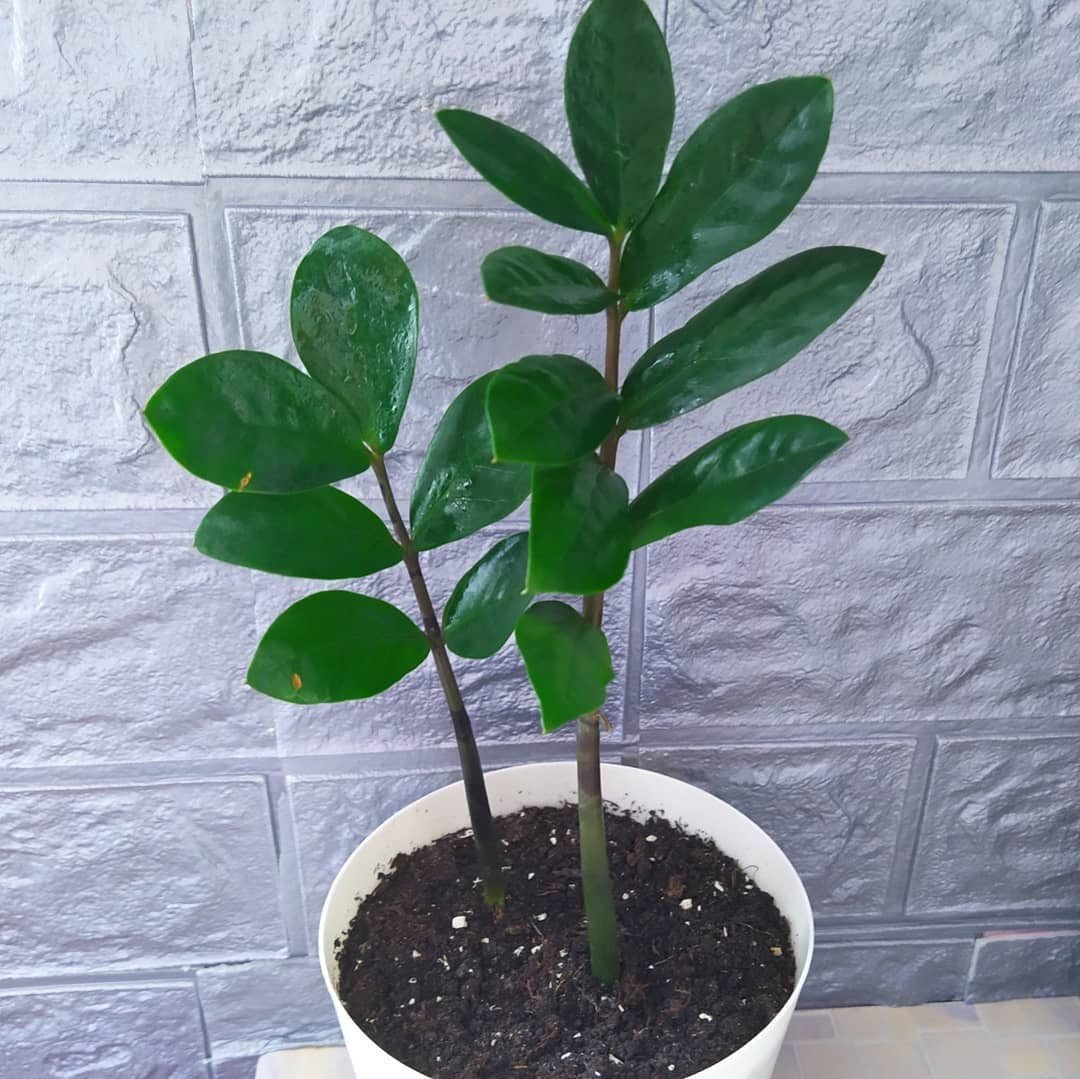
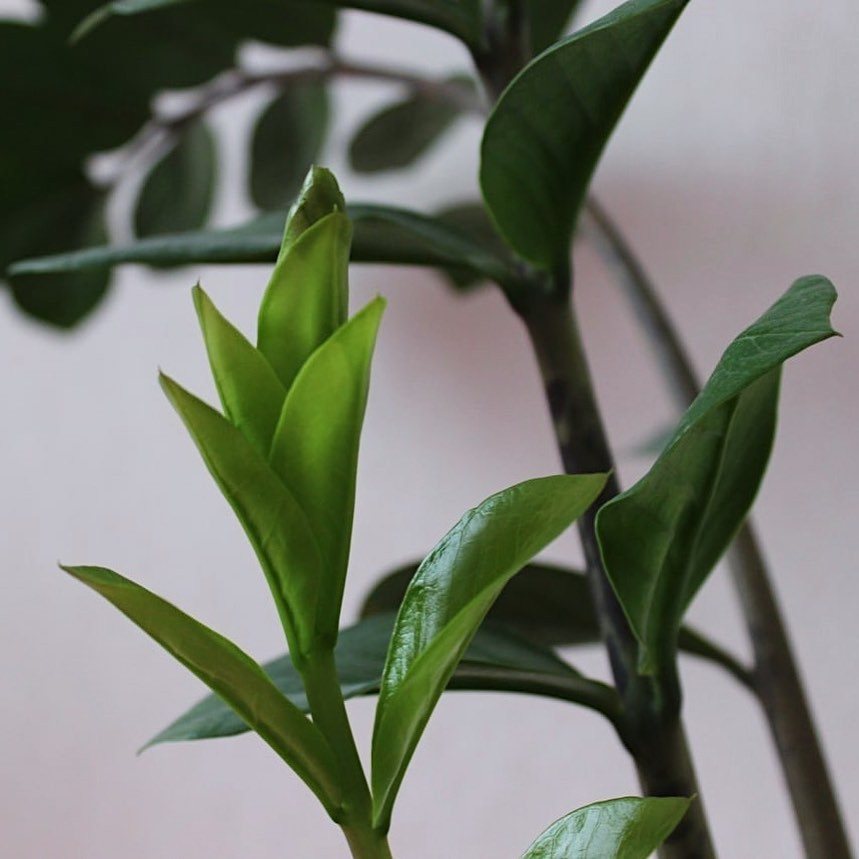

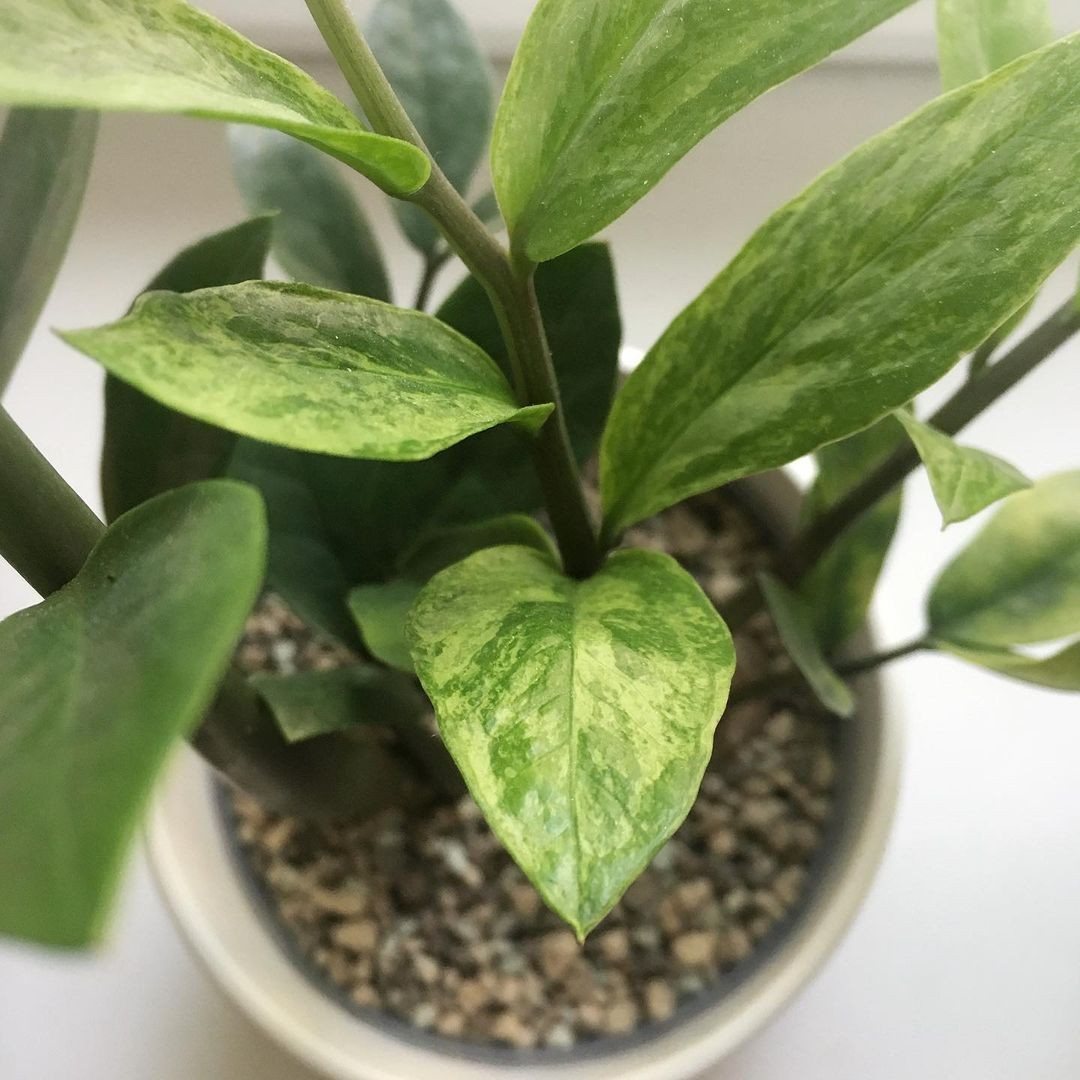











Shchitovka
Spider mite
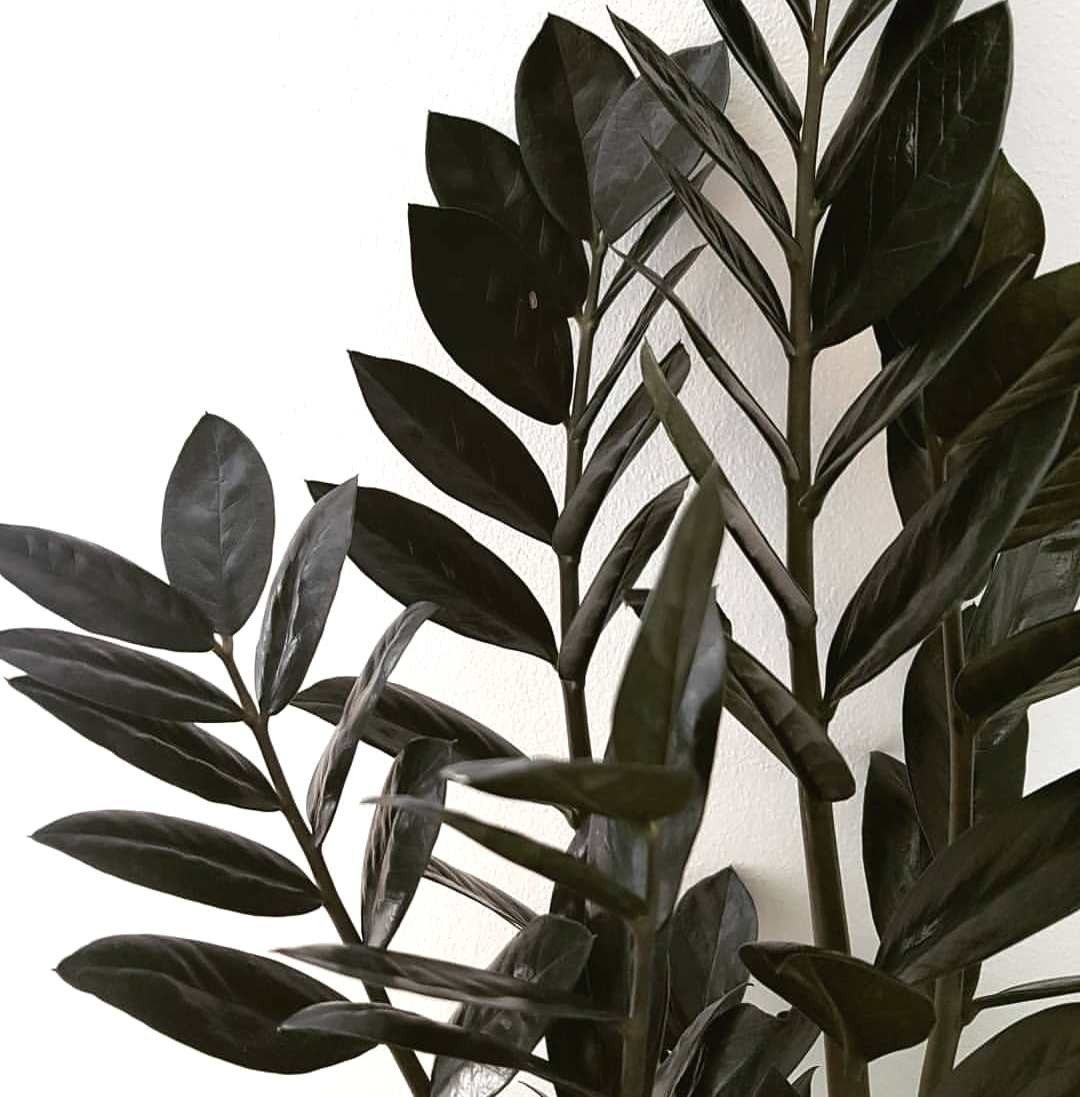
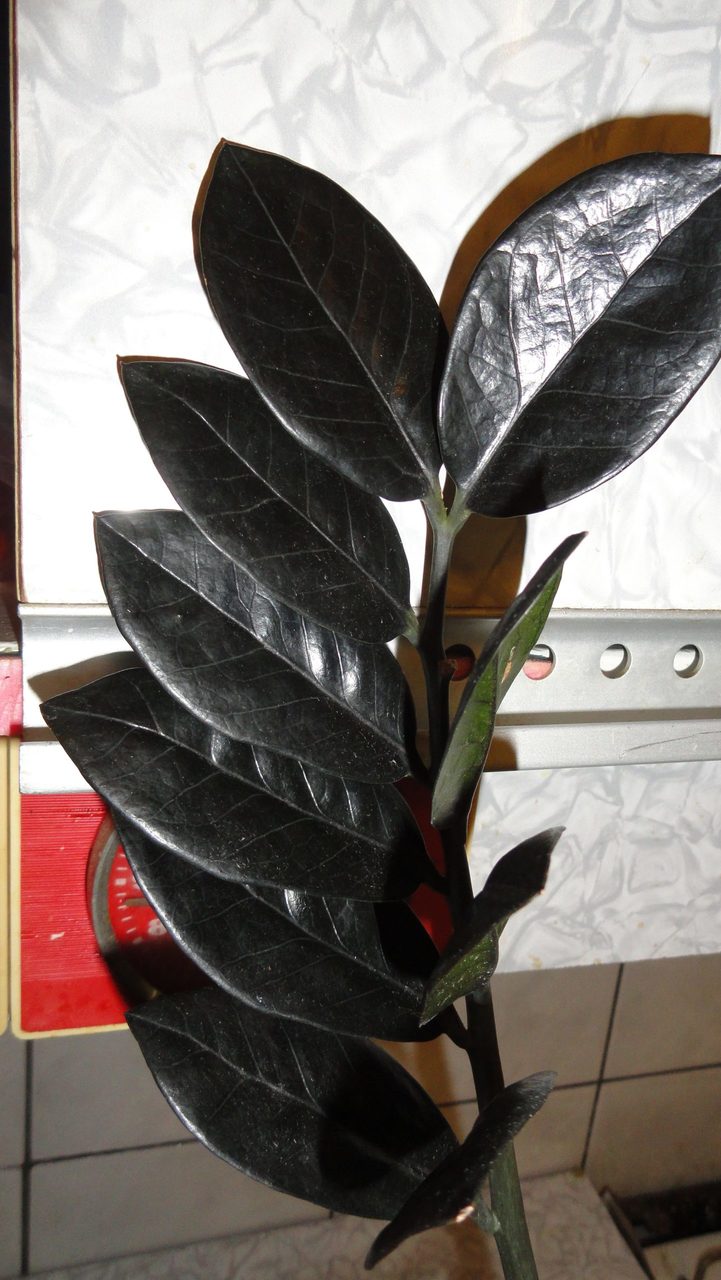
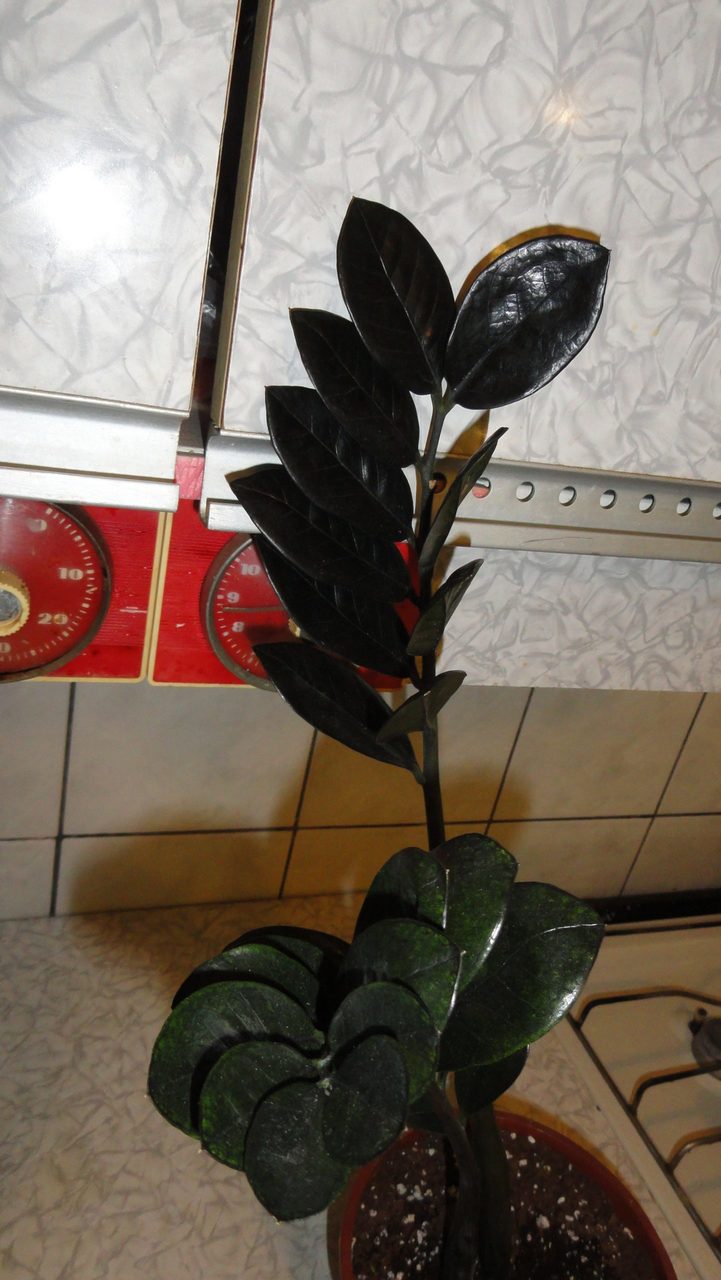
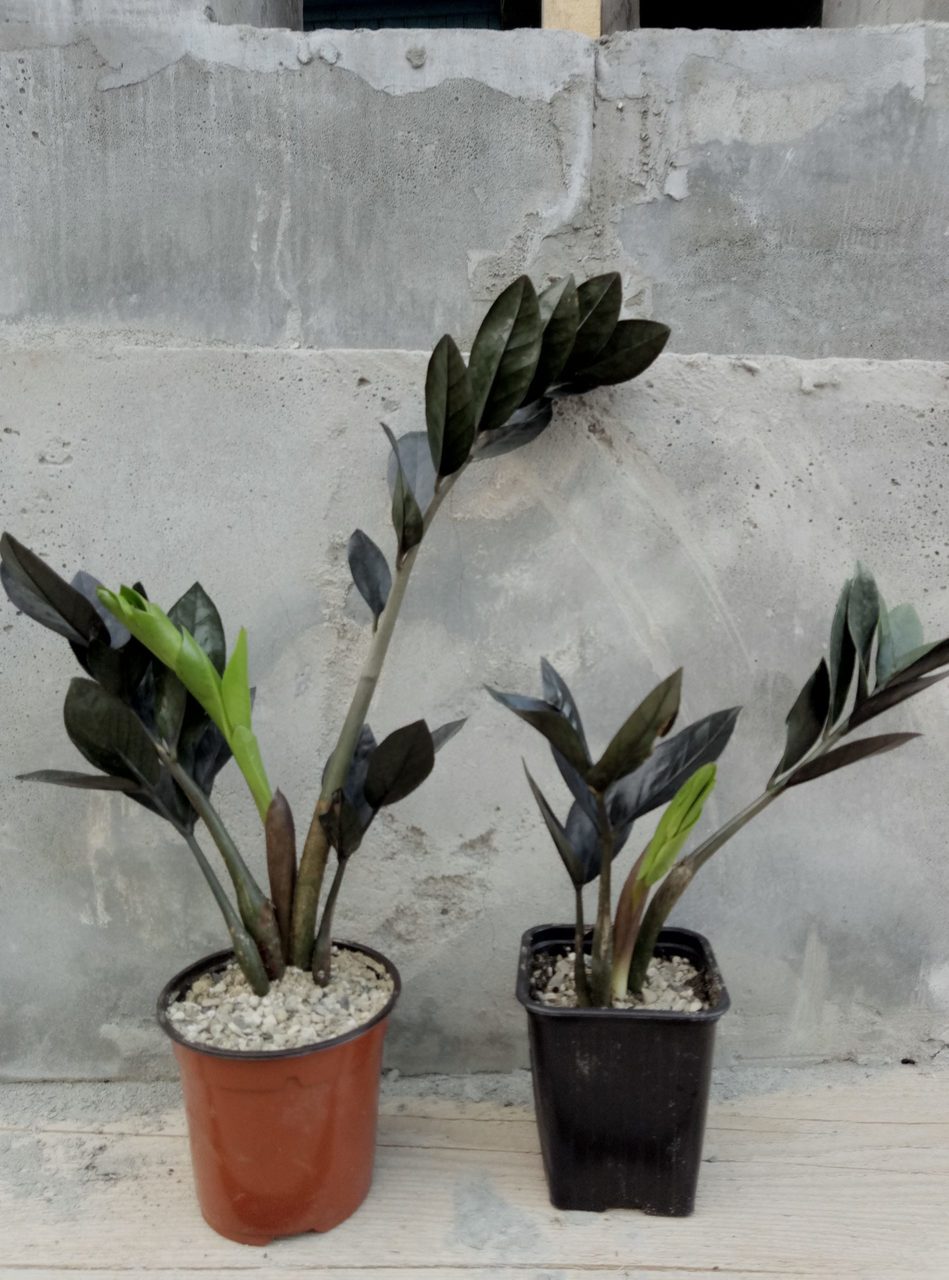
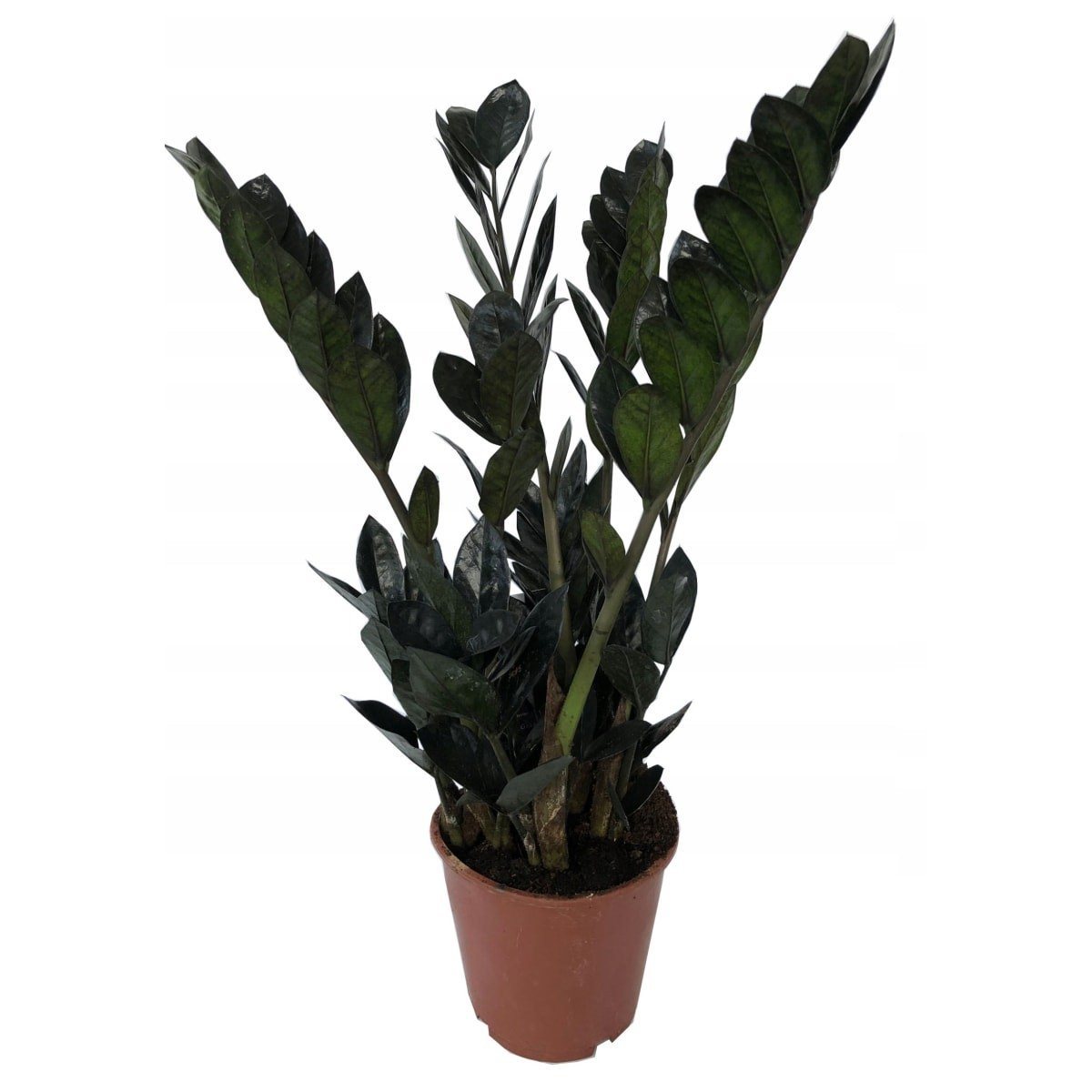

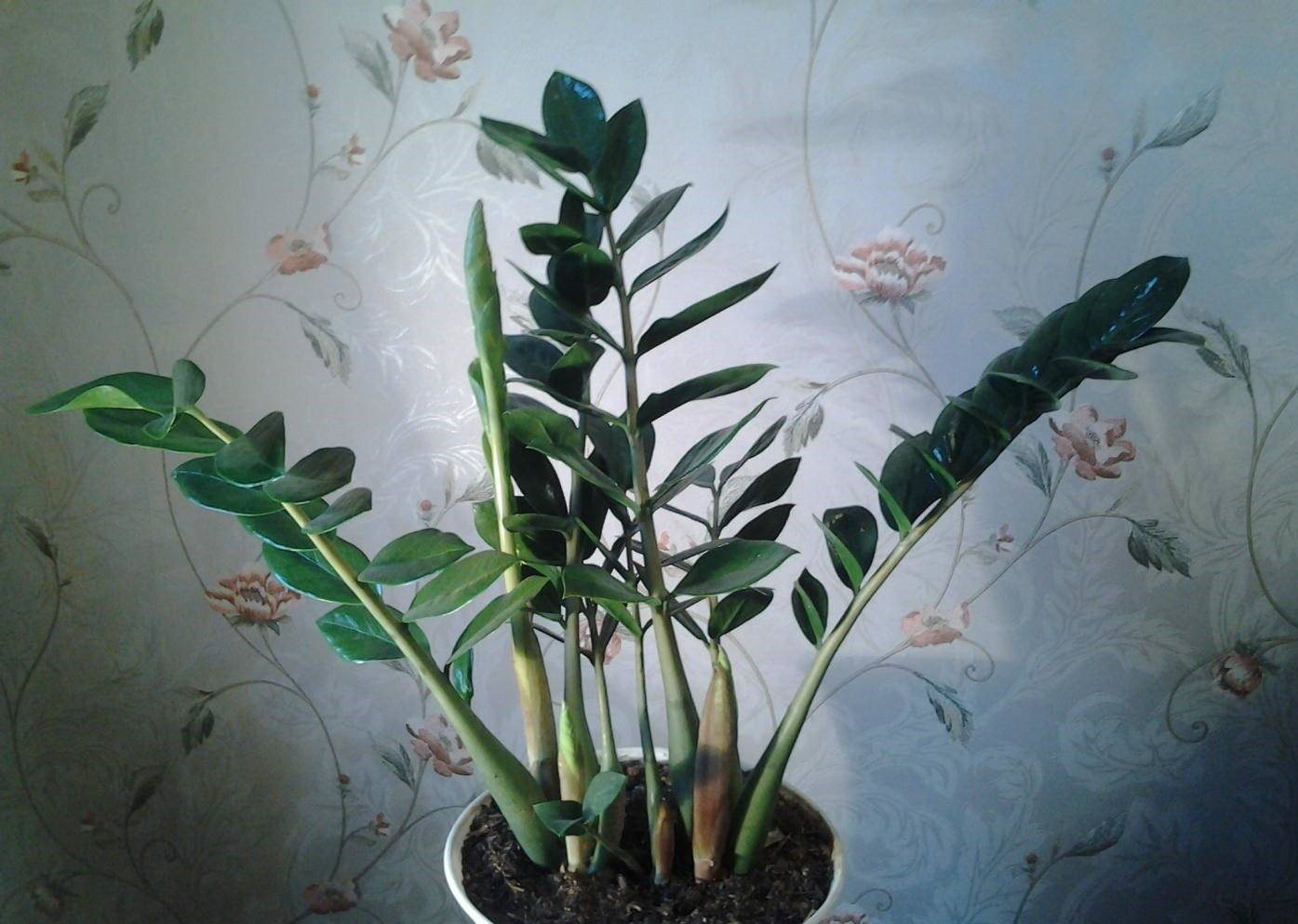
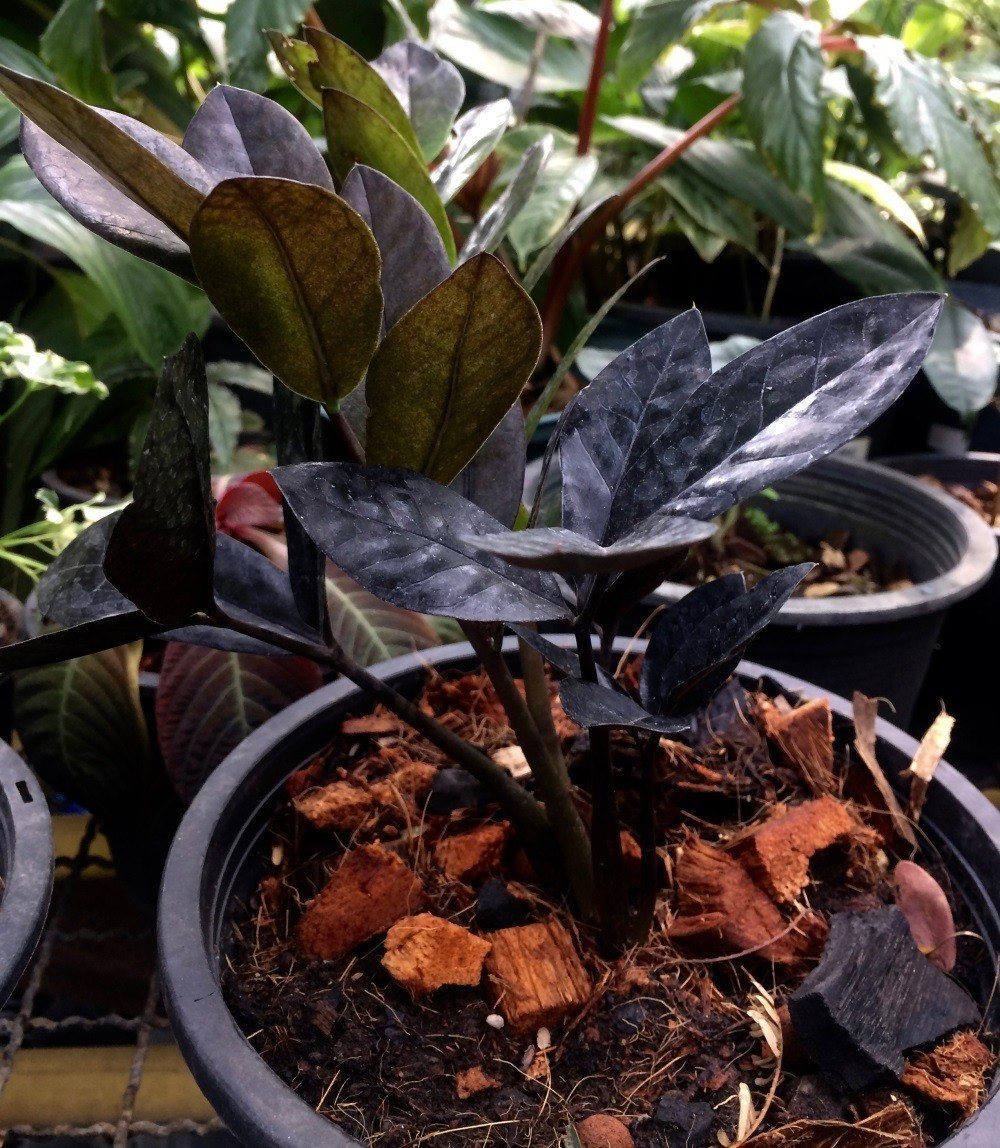
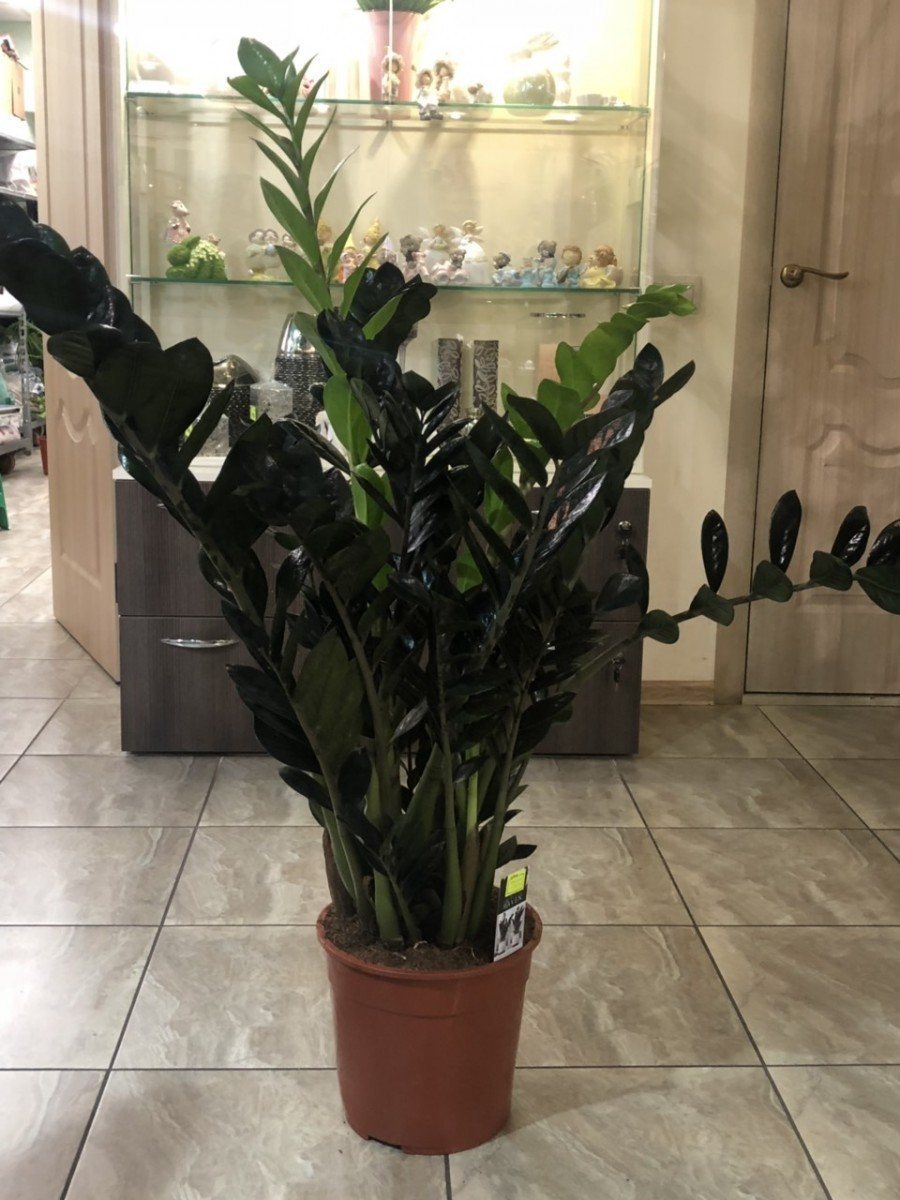
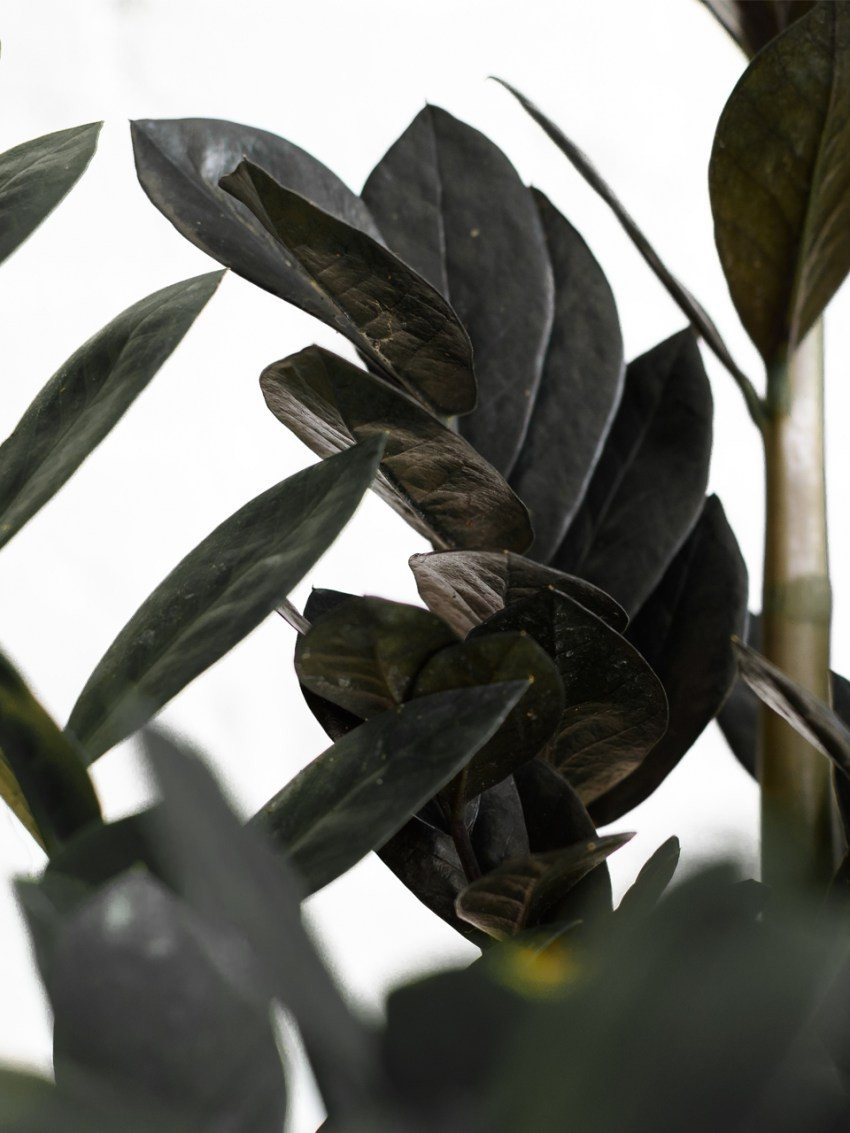










Mealybug
Fungus gnat and fools
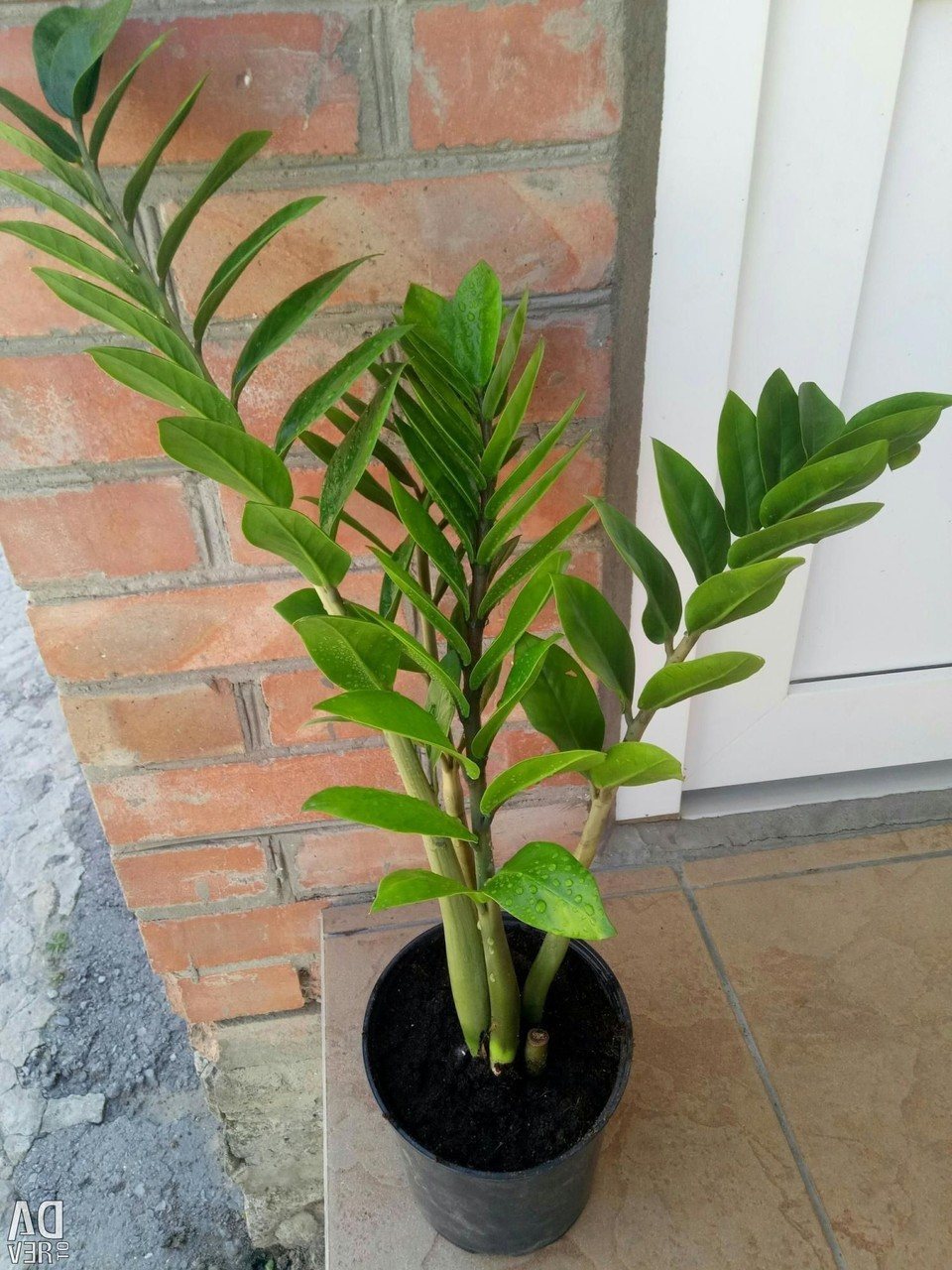
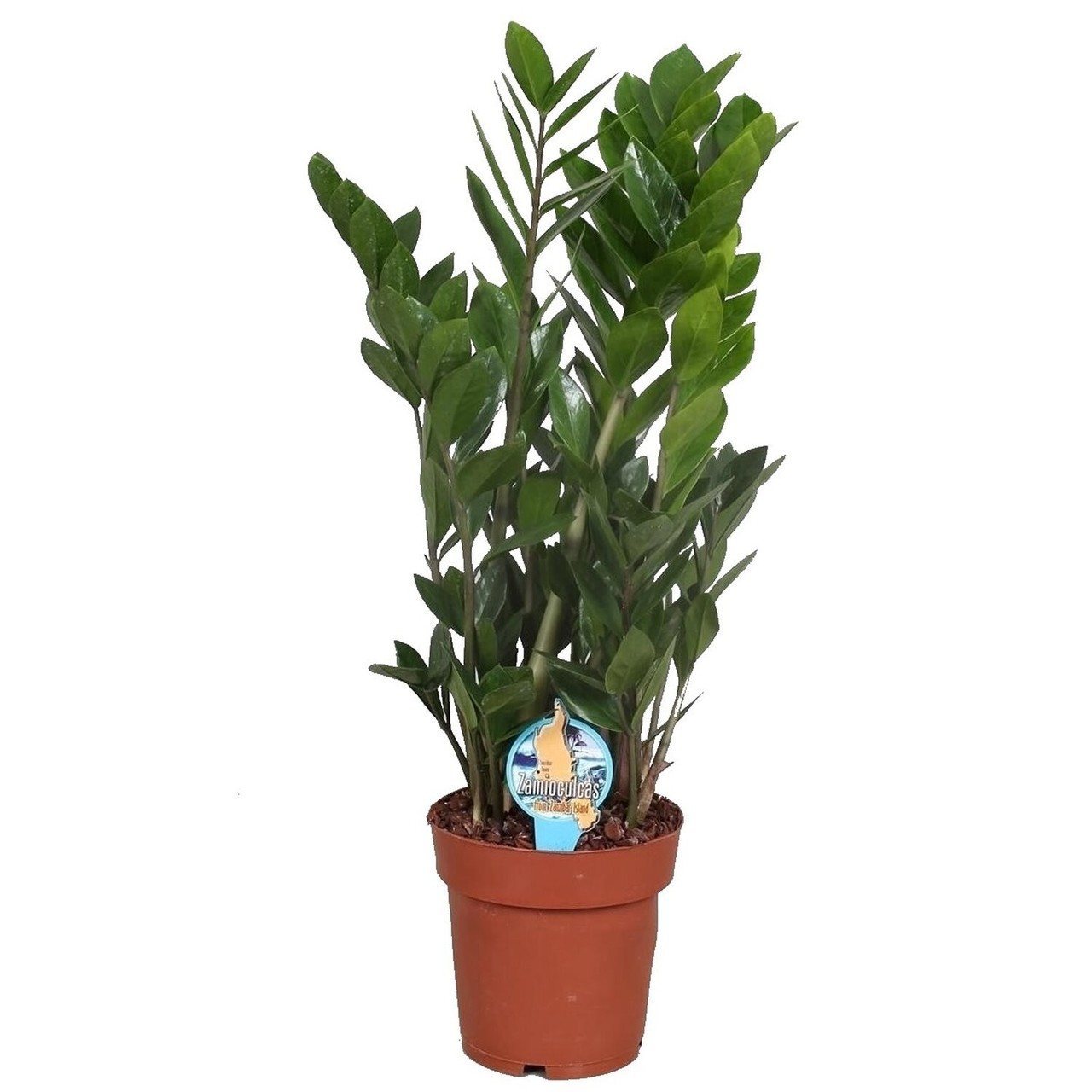
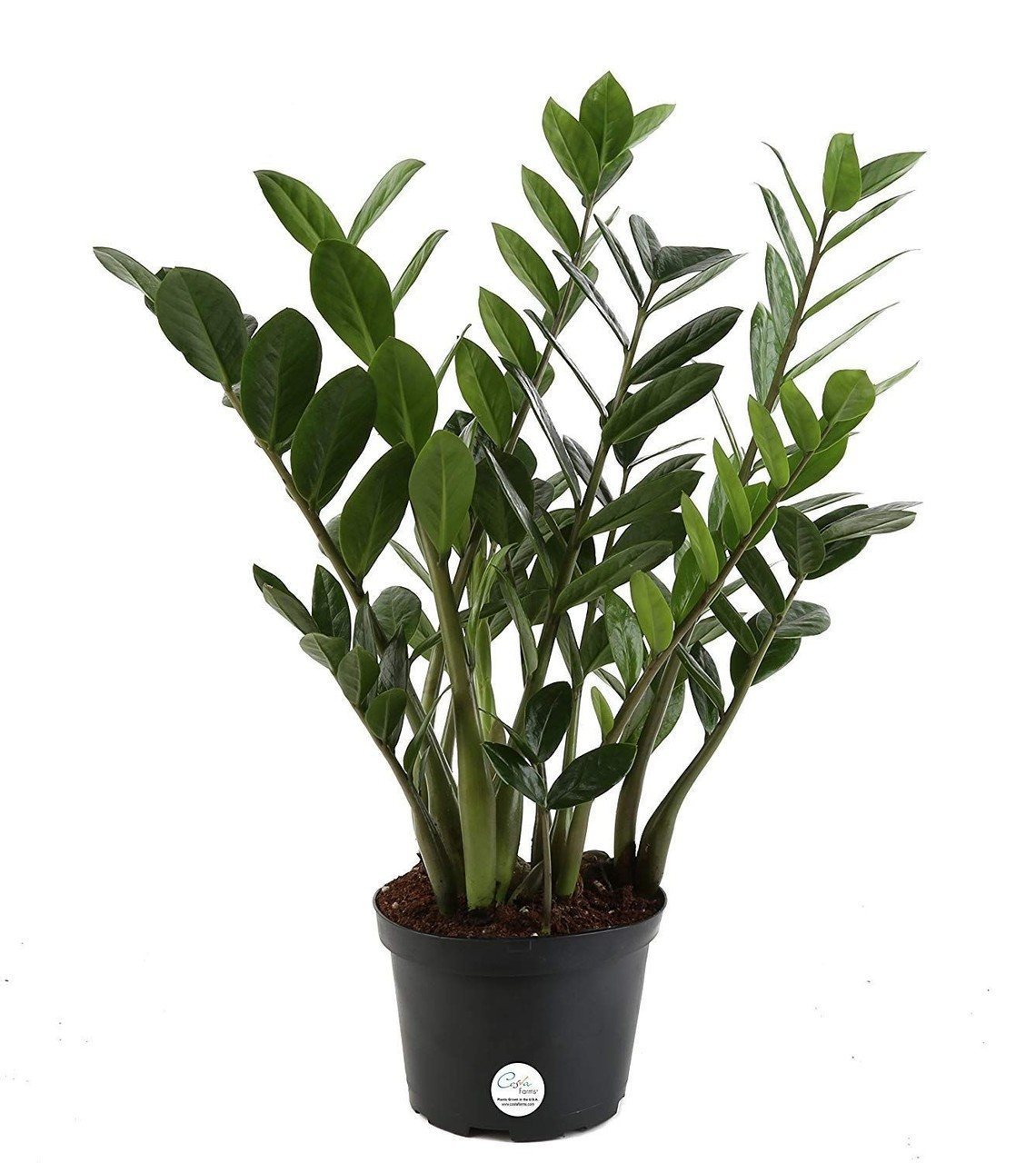
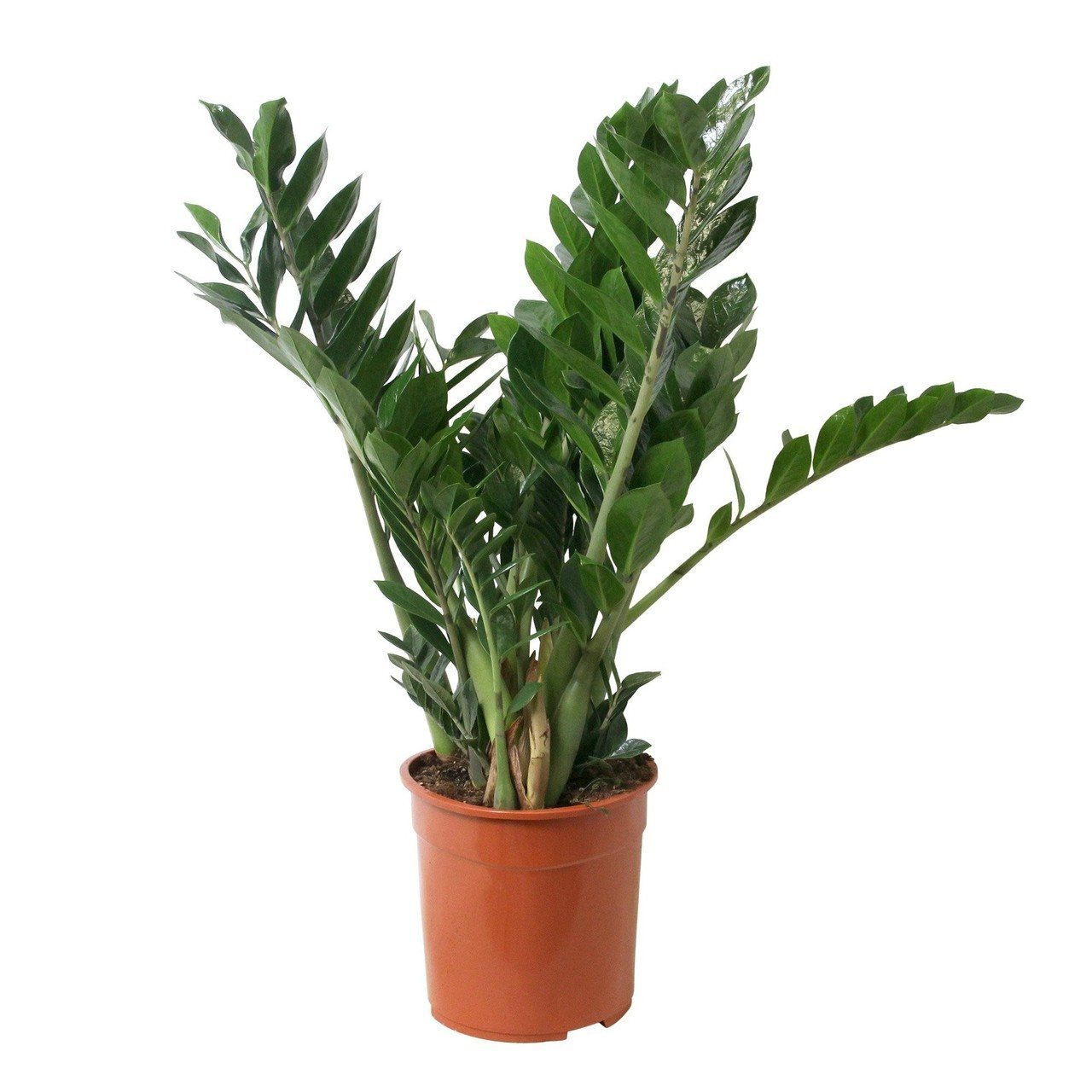
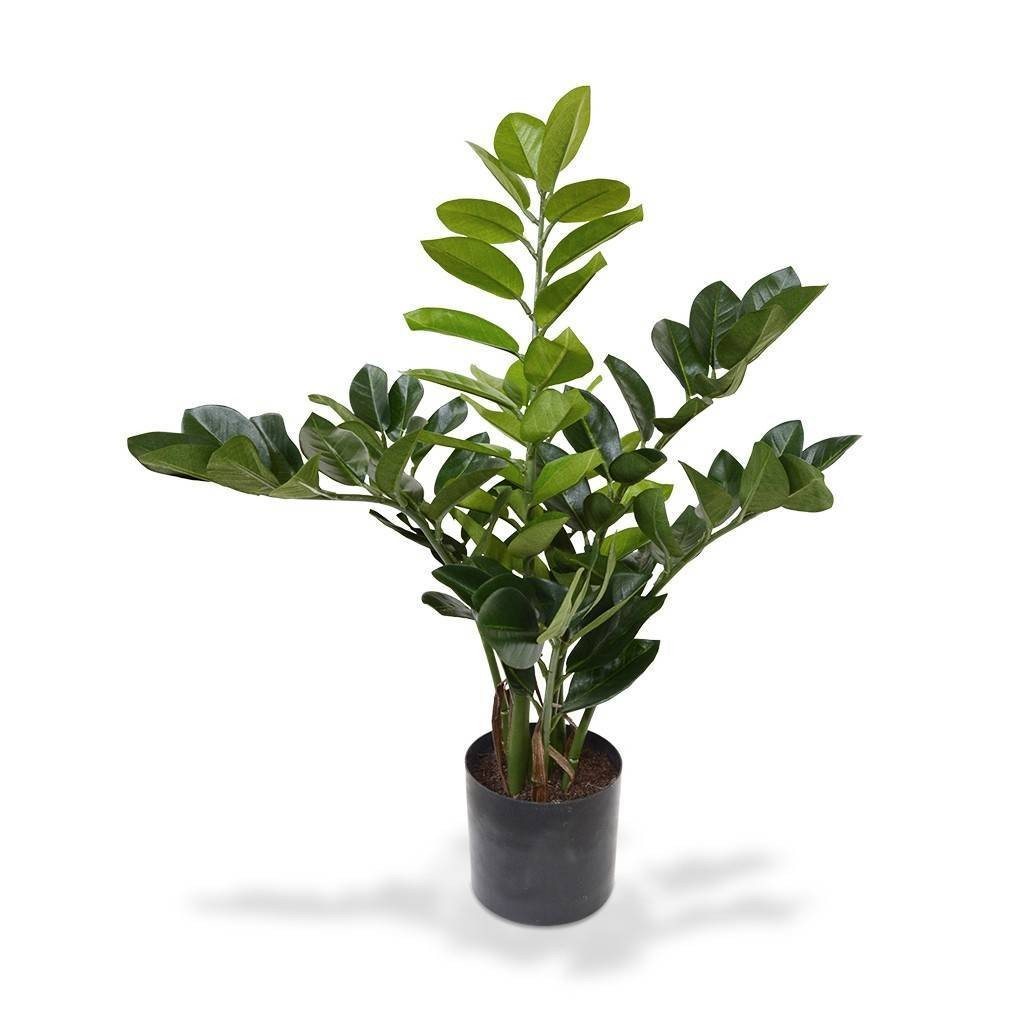
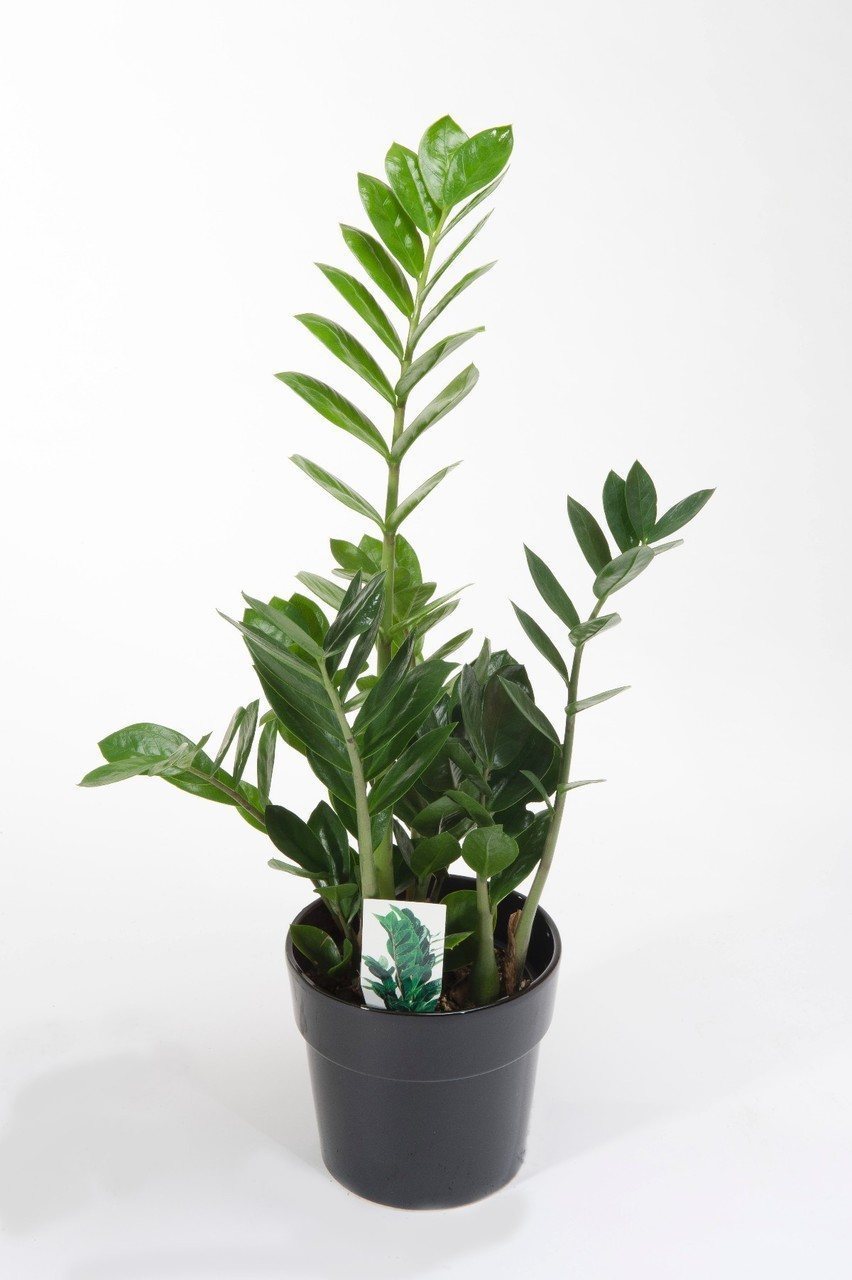
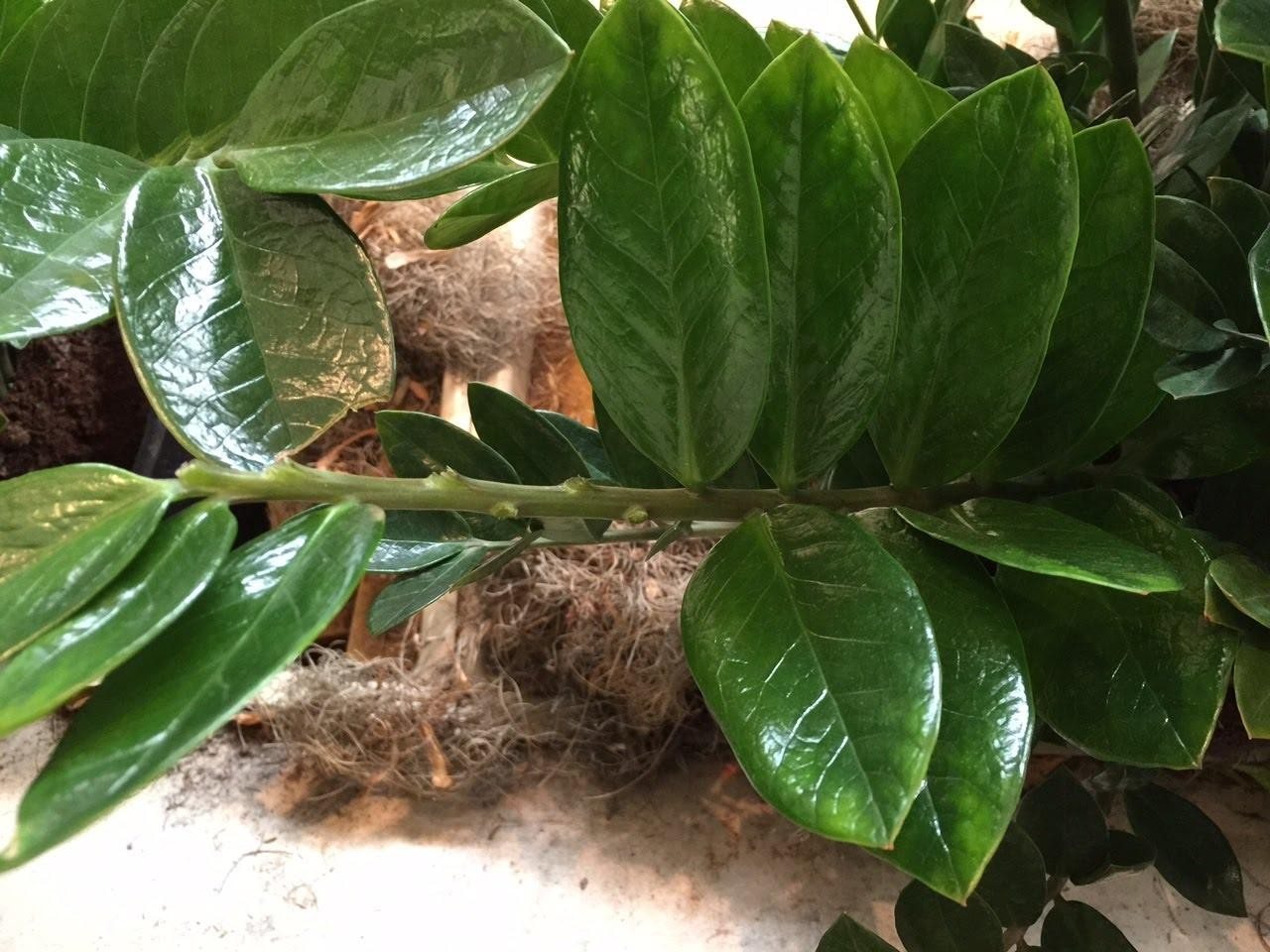
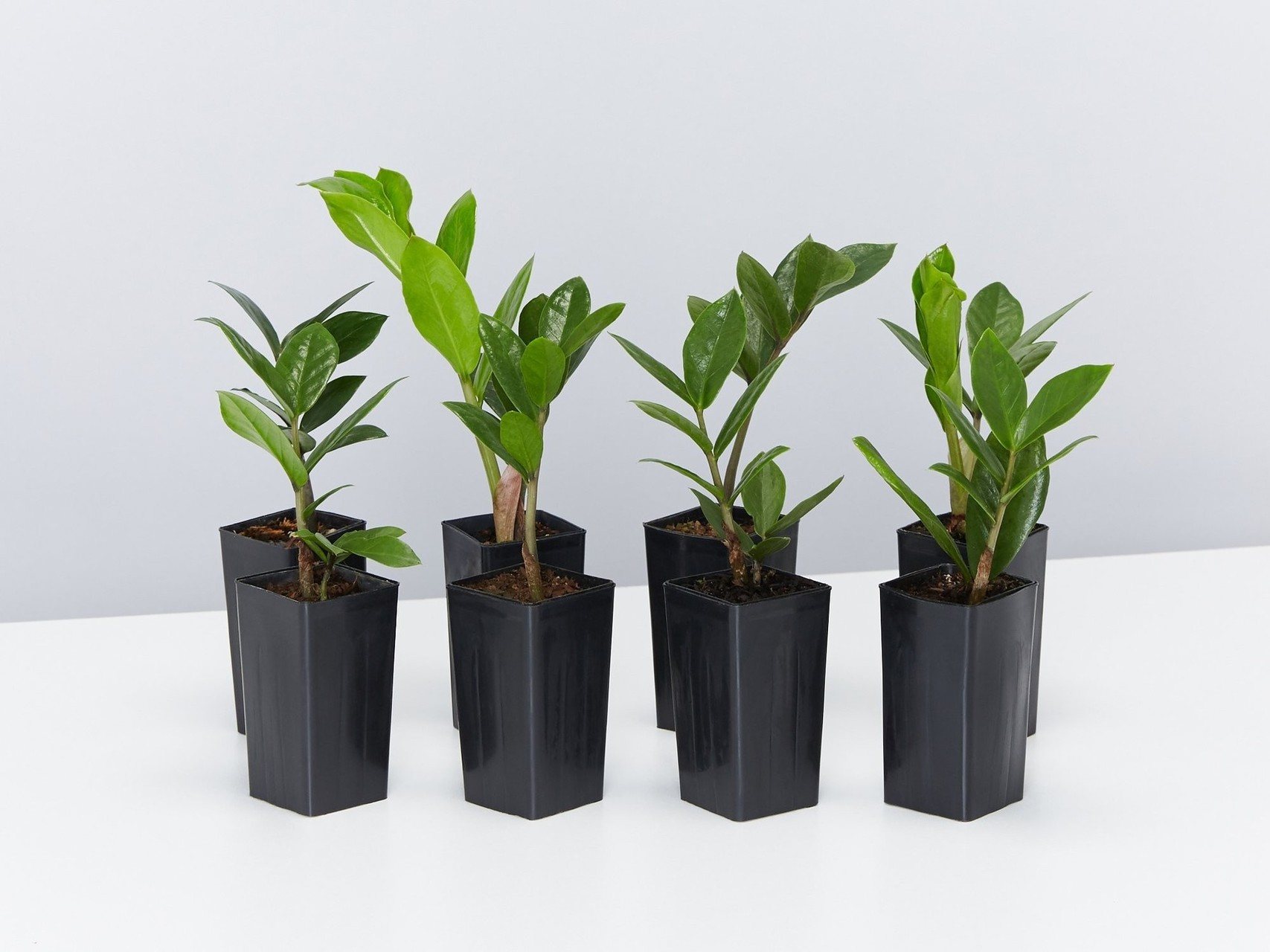

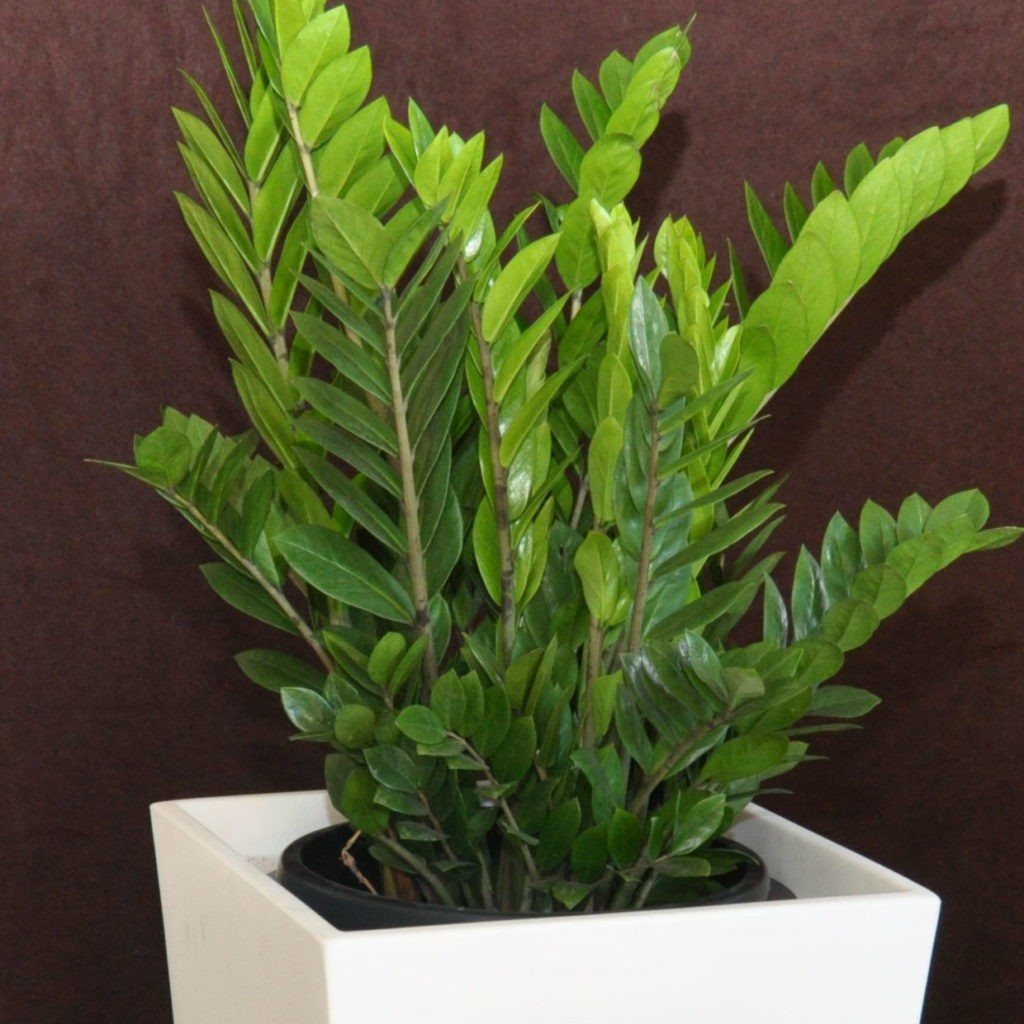










Problems during cultivation
With leaves
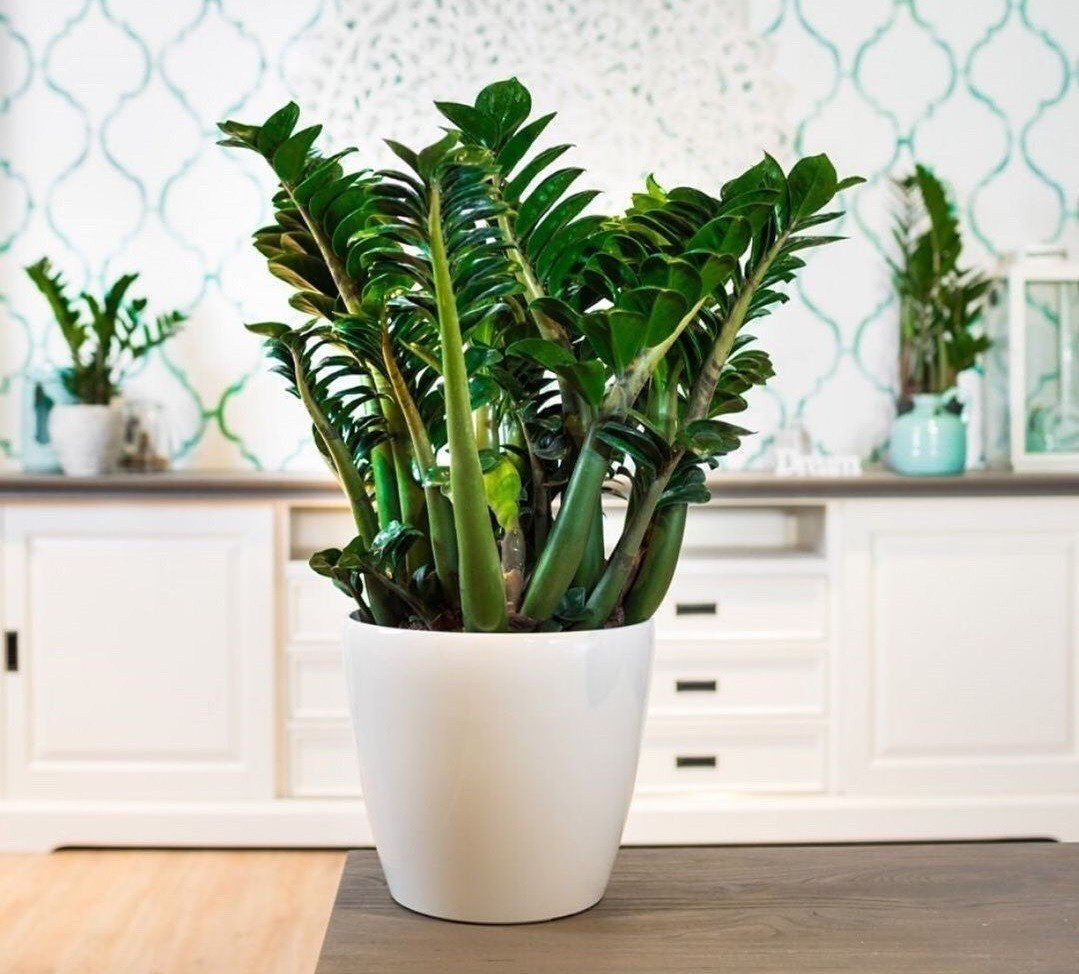
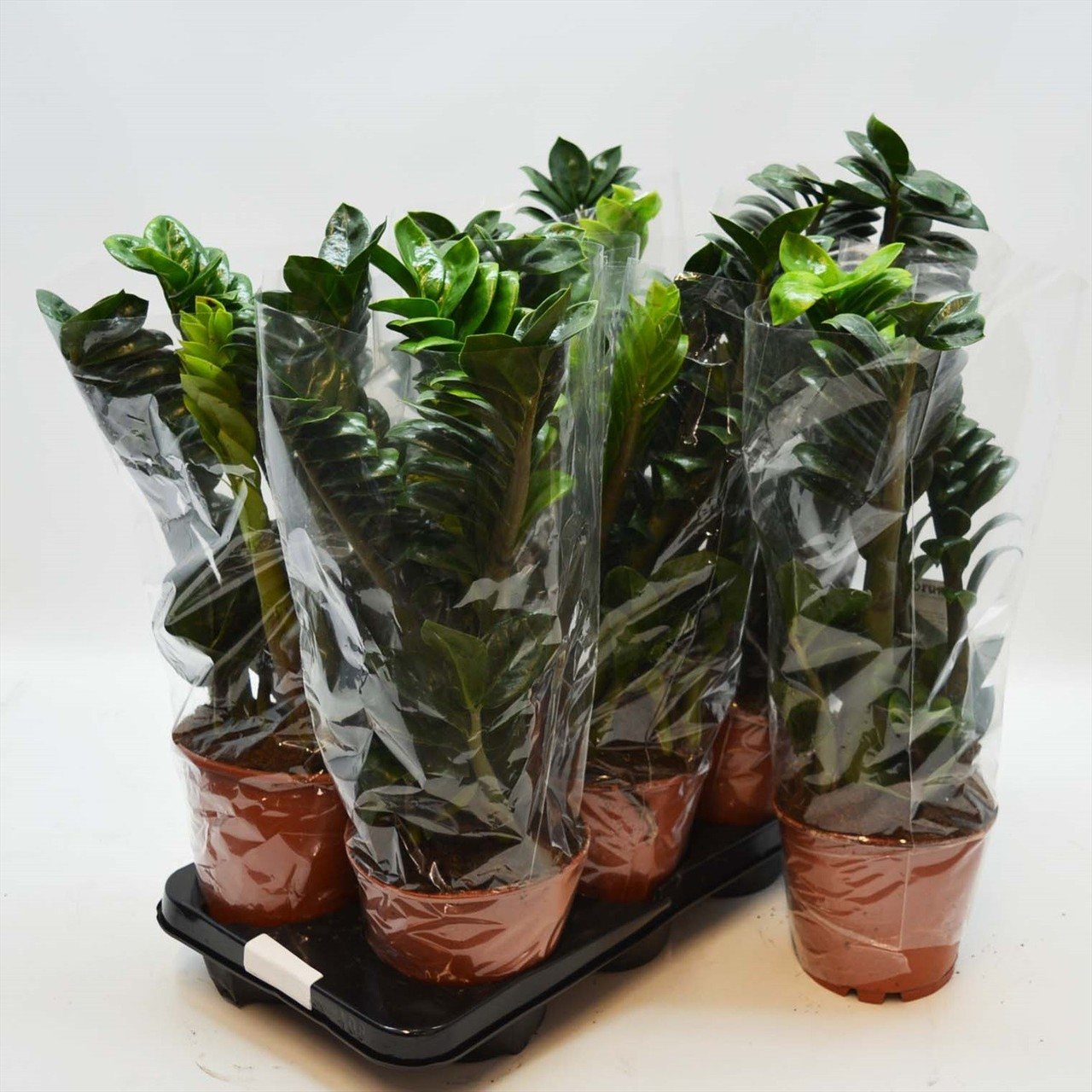
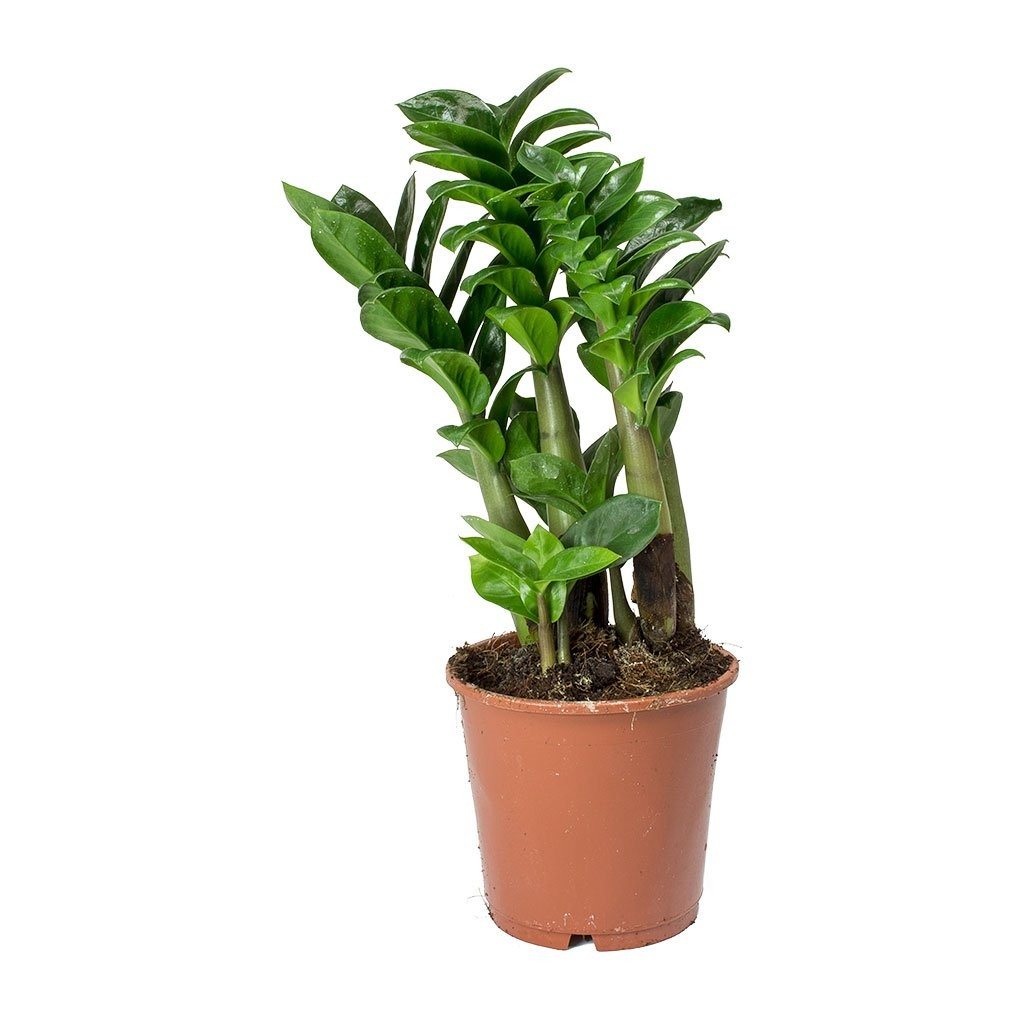
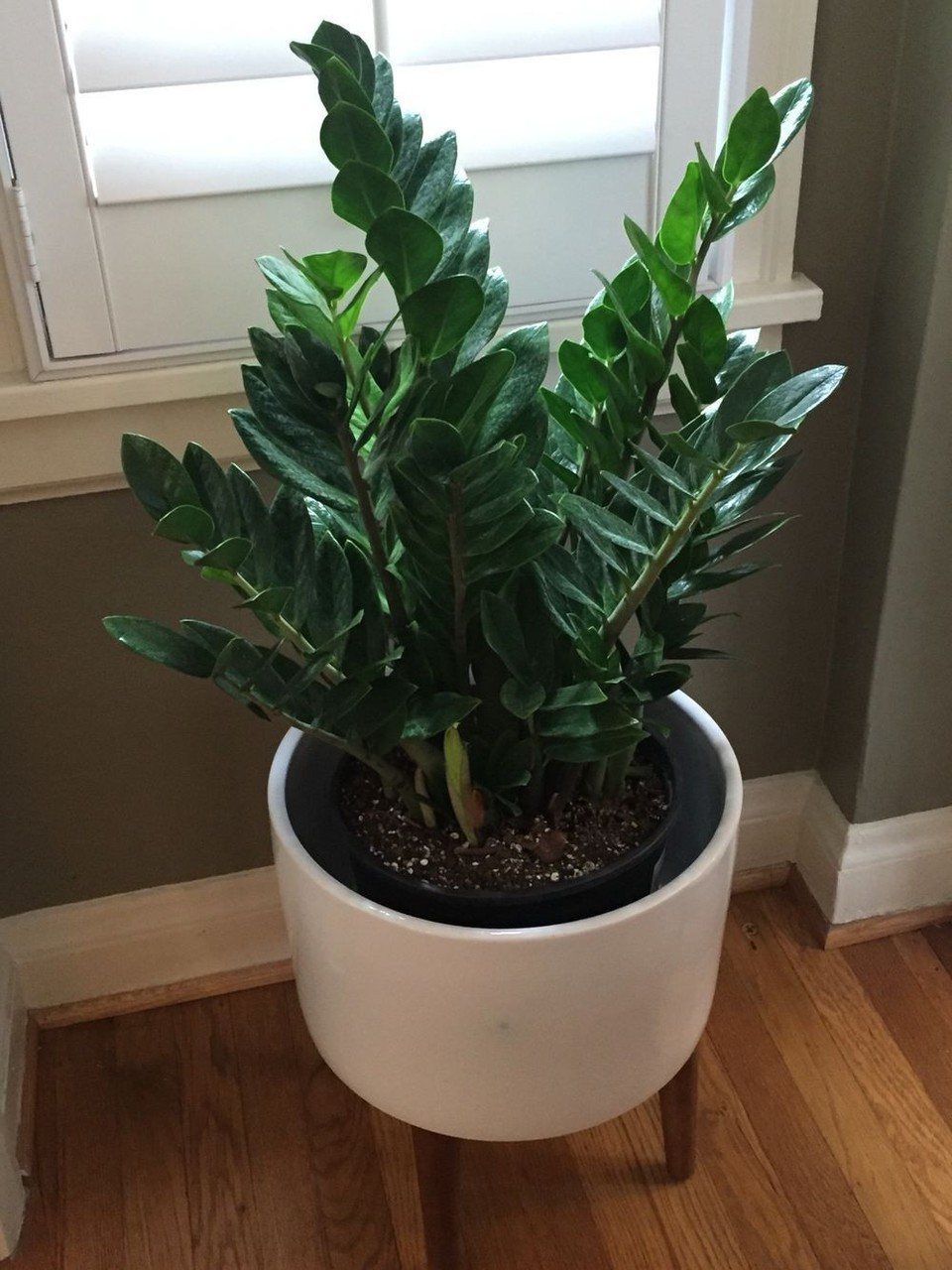
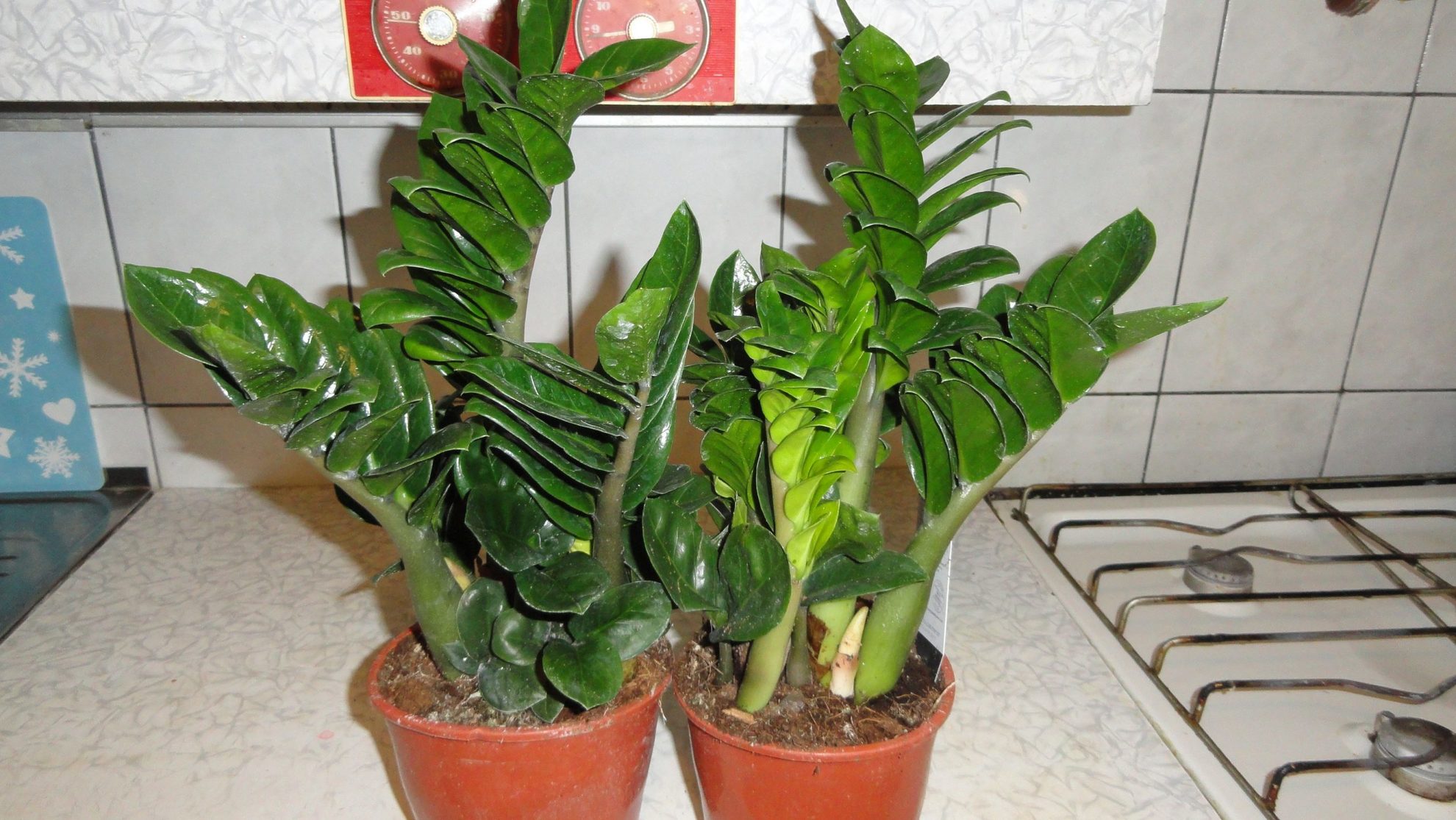
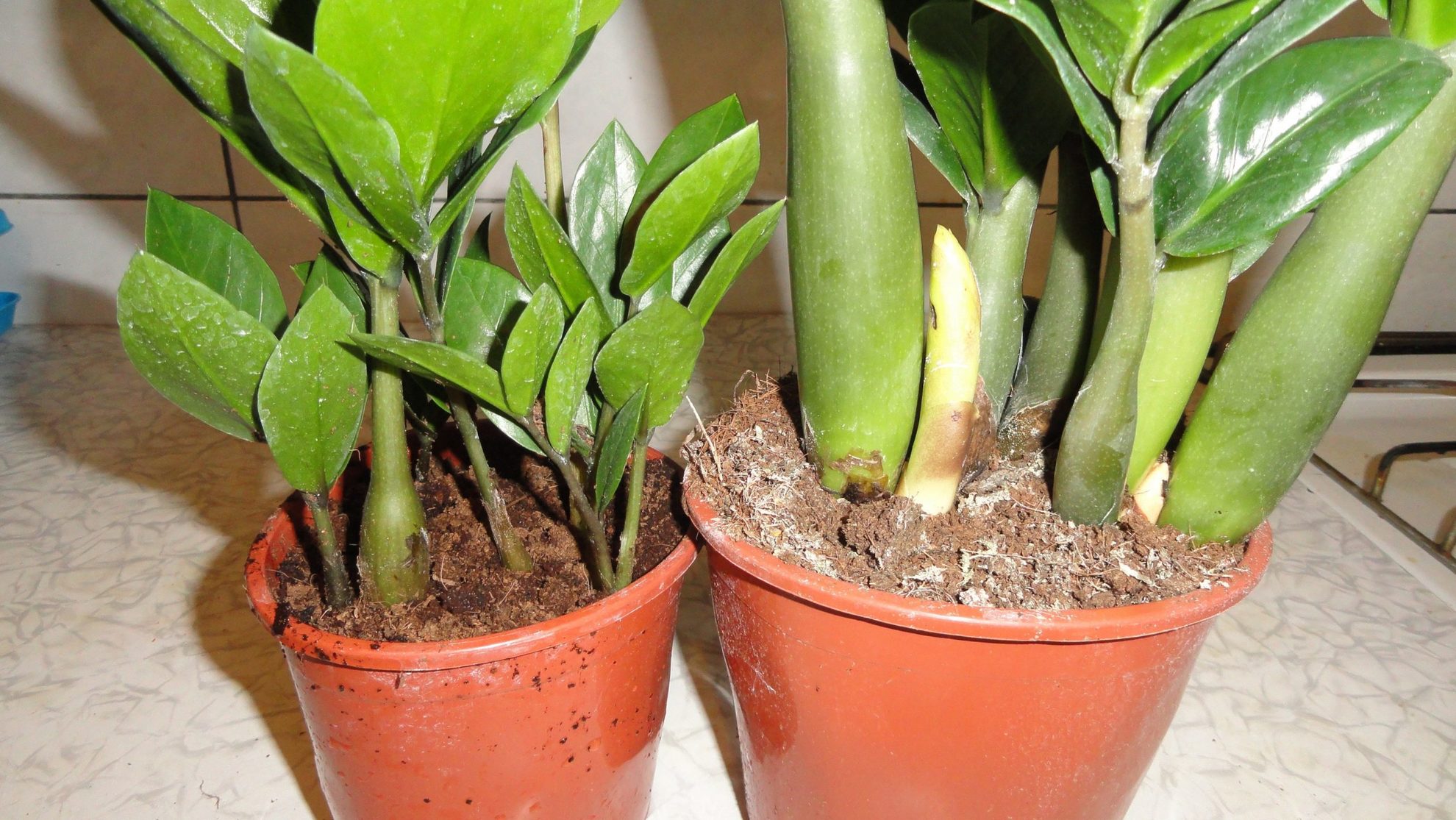
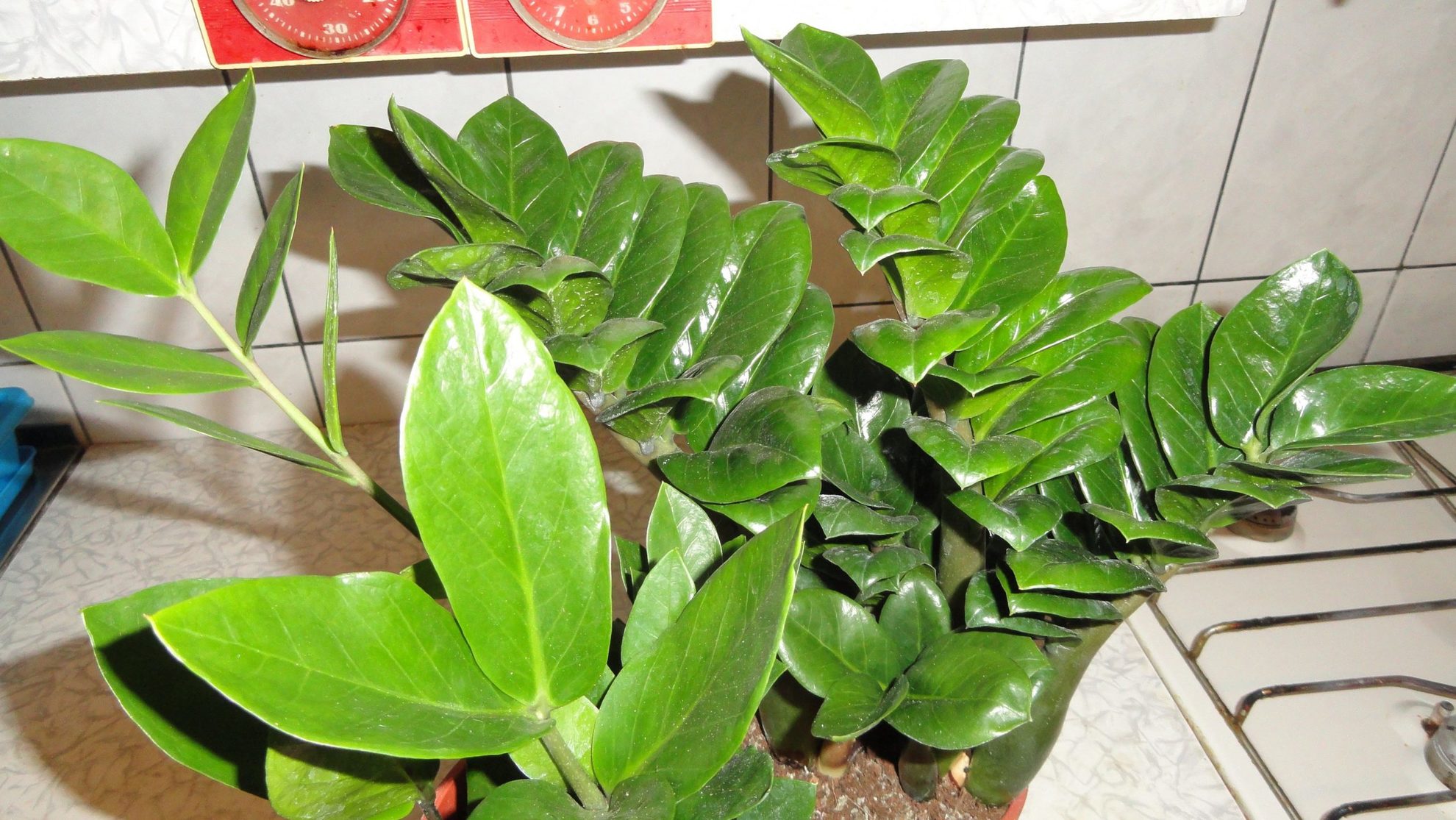
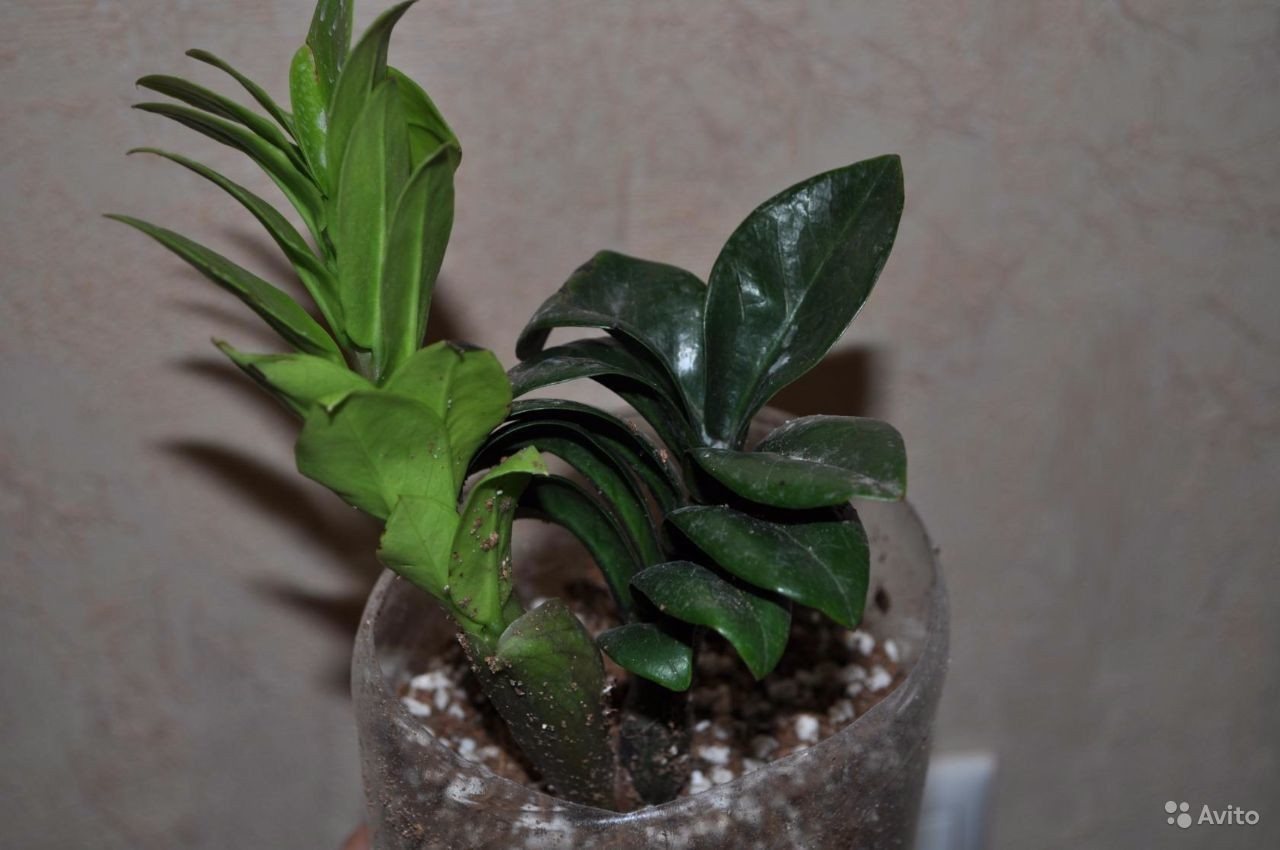
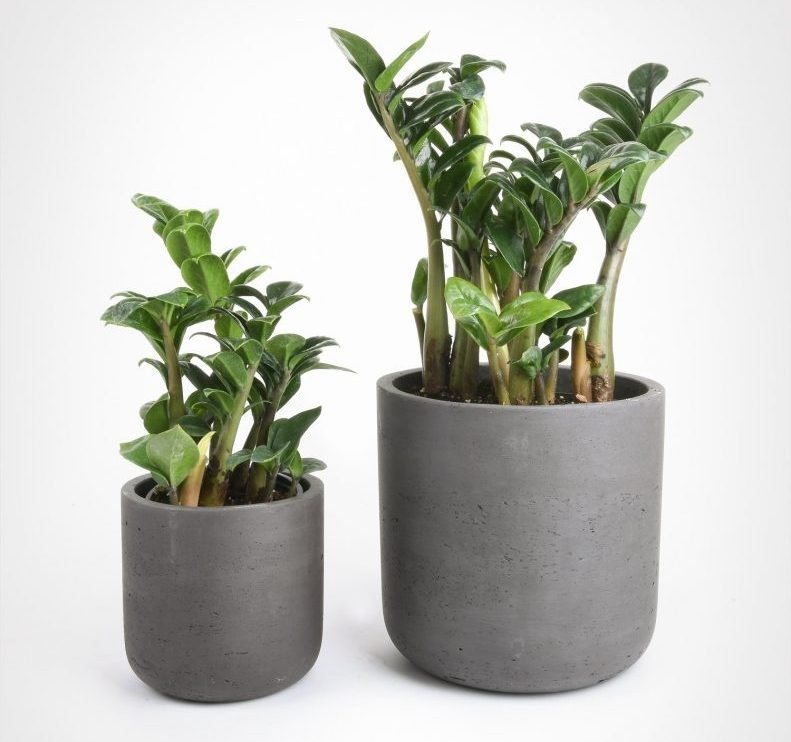
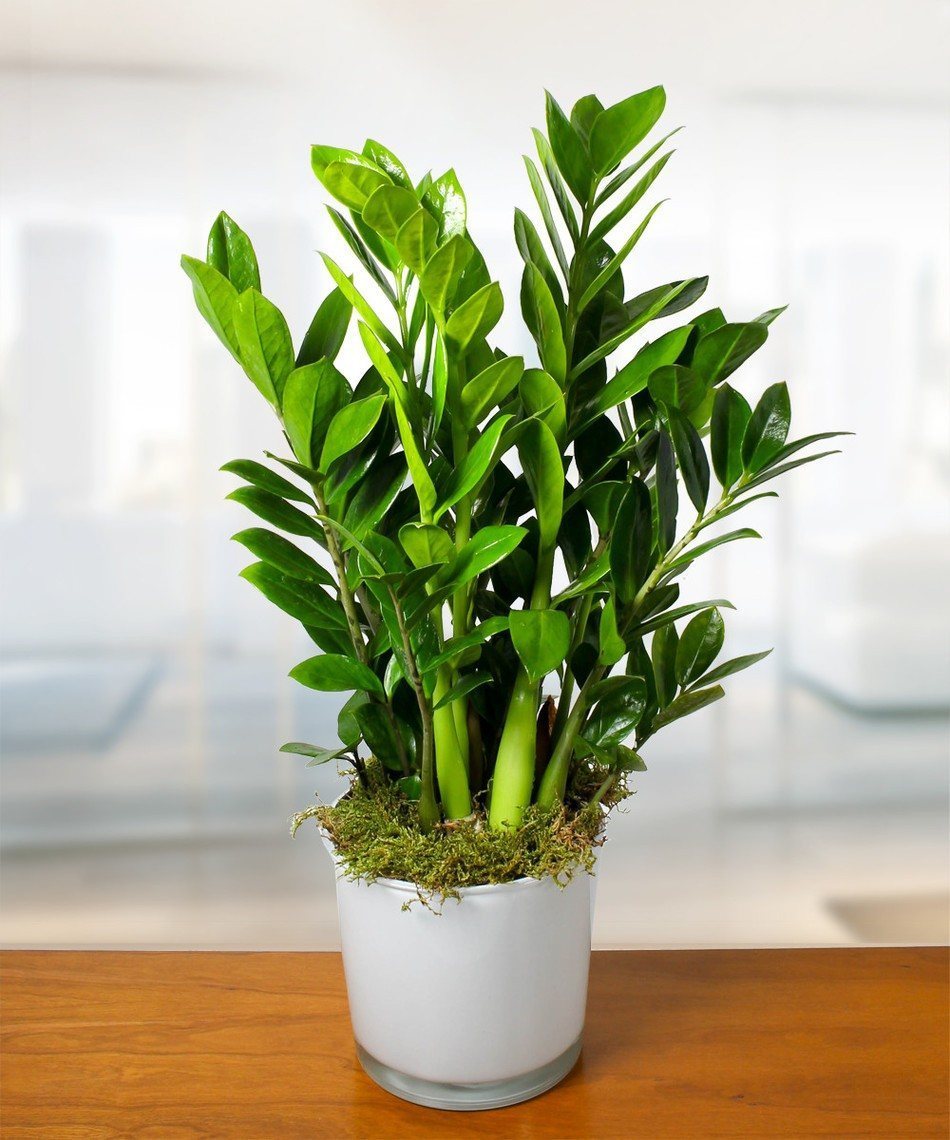










Drops of water appear
Turn yellow
Fall off
Curl up
They're getting brighter
Turn black
Stains
White plaque
With stem
Thin
Stains
Wrinkled
Rotten
With roots
Drying
Rotting
It's getting dark
The tuber has rotted
Does not produce new shoots for a long time
Doesn't grow well
Doesn't bloom
Signs
Zamioculcas in the interior
Reviews from flower growers
Show in full ▼
Botanical description
Zamioculcus is a succulent plant. Thanks to its ability to accumulate moisture, it survives in the hottest and most dry places on the globe.
In appearance, the plant resembles the zamia plant, which is the basis for its name. Zamia, native to Central and South America, belongs to the Zamiaceae family, but has a similar leaf shape.
The crown of Zamioculcas is formed by a system of erect, compound leaves of the pinnate type, reaching a length of 40 to 150 cm. Each compound leaf has from 8 to 12 glossy leaf plates attached to the supporting axis - the rachis. The leaf blades are on short petioles, arranged oppositely or in a checkerboard pattern. Both rachis and petioles are capable of accumulating moisture, which protects the plant during periods of drought. They are light green, covered with dark spots reminiscent of ink.
Dark green, oblong feathery leaves are the main decoration of the succulent. They are glossy, dense and seem to be covered on the outside with a waxy coating. Zamioculcas is an evergreen plant, but during extreme heat, it tends to shed some of its leaves to avoid excessive evaporation of moisture.
- The underground part of Zamioculcas deserves special attention.This is a large underground tuber (modified trunk), similar to a dark potato. This is where the bulk of moisture and nutrients are accumulated. A powerful root system extends down from the tuber. It is so strong that, as it develops, it can break the walls of a pot that has become too small in size. That is why the plant requires annual transplants into a larger container.
- Already have a Zamioculcas?
Yes.
No, I'm just looking closely.
No and not planned, I just wanted to see it.
Voted:
The plant is distinguished by very slow growth (it adds no more than 10 cm per year), its average lifespan is short and is no more than 10 years. Flower growers are advised to take care of crop propagation in advance.
The succulent blooms very rarely (flowering period is early spring or autumn). Only adult specimens of Zamioculcas bloom, and only if they receive proper care. The flower is an inconspicuous spadix containing a row of small white flowers with a pleasant scent. In the spadix, covered with a light green bract, female and male flowers alternate, between which there are asexual flowers (sterility zone). This system was created by nature to prevent the possibility of self-pollination.
In apartment conditions, it is very difficult to achieve the formation of ovaries, but in nature the plant bears fruit. The fruits look like a small green cone, which turns brown when ripe. It is difficult to achieve ripening of seeds, and it does not make sense: the crop is propagated by cuttings, by dividing a bush or tuber, or by a compound leaf.
Varieties
The genus Zamioculcas is considered monotypic because it includes only one natural botanical species.Its typical representative, growing in the wild, is called Zamioculcas zamifolia. From the time Zamioculcas began to be used as an indoor crop, breeding work began to develop new varieties. So in 2007, Zamioculcas Zamicro (Zamikro) was bred. In appearance, it resembles the classic type, differing only in its shorter shoot height and smaller, oblong leaves. A little later, other varieties were developed:
Variety Super Nova
differs from the classic type in the more saturated bright green color of the leaves. The plant can reach one and a half meters in height. The petioles have a special height and power. The decorative properties of this variety are very high.
Lucky White
– a variegated variety of Zamioculcas. It is distinguished by its small size (reaches a height of more than 30-40 cm). The leaves have a marble color, which greatly decorates the plant: against a dark green background there are cream and light yellow veins. Flower growers call Lucky White a capricious variety that requires careful care and attention for good growth.
Variety Beetle (Bug)
– dwarf, the shoots of plants of this variety do not exceed 30 cm in height. This is a densely leafy variety, and the leafy part begins at the very base of the complex leaves. The leaf blades sitting opposite each other are dark emerald green and have a glossy sheen.
Black Raven
- - a hybrid variety up to 75 cm high. The plant surprises with its colors: its leaves have such a deep emerald color that they give the impression of black. At the same time, young leaf blades are colored light green, which makes them stand out from the general background.Zamioculcas Black Crow is distinguished by extremely rare flowering.
- Variety Lucky
- It is characterized by rapid growth, reaching a height of 55-60 cm. Another name is round-leaved, in accordance with the almost perfectly round shape of the bright green leaves. The leaves of the plant are raised upward, which serves as an additional decoration of the variety.
Let's take a closer look at the decorative varieties of Zamioculcas.
Zamielifolia
- Zamioculcas Zamiifolia was first described in 1828 by the American botanist Conrad Lodges, who collected tropical crops. In his description of the exotic plant with fleshy leaves, he gave the name “cladium zamifolia.” Another biologist, Heinrich Wilhelm Schott, published a different description, calling the plant "Zamioculcas lodigessa". And only in 1908 the succulent received the name by which it is still known - “Zamioculcas zamifilia”. Its author is the director of the Berlin Botanical Garden, Adolf Engler. At different times, other natural variations of the plant were discovered. They all have different growing areas and are somewhat different in appearance.
- Lanceolate
The lanceolate subspecies of Zamioculcas is so named for its elongated (lanceolate) shape of brightly colored leaves. The height of the plant can reach a meter. In 2007, a dwarf form of the plant was bred, the height of the shoots reaching 30–60 cm. The plant is highly decorative and is considered an excellent option for decorating the interior of a home.
Variegated
The homeland of the variegated Zamioculcas is the island of Madagascar. The plant is a giant species and reaches a height of one and a half meters. The symmetrically located fox feathers are moderately elongated and pointed at the tips.Another name for this species is variegated, named so in accordance with the color of the leaf blades: white veins and stripes are placed on a dark green background (there is another variant of leaf color). To date, several varieties have been bred, including Long Liv, Short Liv, Big Liv (Long Liv has yellow streaks, and Big Liv leaves are deep yellow, with pale green petioles). Variegated is a rare species of Zamioculcas.
Motley
- Variegated Zamioculcas is distinguished by elongated leaves with veins and spots of bright yellow color. Variegation is caused by a mutation, as a result of which some leaf blades lose sensitivity to ultraviolet radiation. As a result, the process of photosynthesis is disrupted in them.
- Dark purple
- The dark purple species was first discovered in Asian countries, particularly in Korea. It is classified as compact, since its representatives reach only 25-30 cm. Young shoots have a light green or light green color. With age, they rapidly darken, often becoming almost black. The dark purple Zamioculcas is characterized by very slow growth.
- Buavena (Zanzibar Pearl)
Dwarf Zenzi
Zamioculcas Zenzi (Zenzi) is a dwarf species, reaching a height of no more than 70 cm. Zenzi's shoots are powerful, and the leaf plates are located very densely and are slightly bent downwards (as if twisted). Thanks to this feature, Zenzi is called curly. The plant is very compact, its leaves have a deep green color.
Common names of plants in Russia
The popularity of Zamioculcas is evidenced by a large number of names, including scientific, folk, and even erroneous ones. Thus, Zamioculcas is called an aroid palm, emphasizing its similarity to this type of tropical plants.
5 Carnivore Plants You Can Grow at Home
A large number of folk legends and beliefs are associated with Zamioculcas. People call it the “dollar tree”, “money tree”, “currency tree”, since many believe that the plant brings material wealth to its owners. These names are said to be due to the dark green color of the leaves, reminiscent of the color of American currency. That is why zamioculcas of different varieties often decorate bank offices, accounting departments, and administrative institutions.
There are also names that are diametrically exclusive of each other, such as “flower of celibacy” and “female happiness.” After all, many believe that a woman who is privileged to see such a rare phenomenon as the flowering of zamioculcas will definitely meet her lover. And others argue that a flower presented to a girl as a gift is a symbol of failure on the personal front.
There are other names for the flower, such as "Chinese New Year tree" and simply "ZZ" (an American abbreviation).
Ignorant people mistakenly apply the name “philodendron” to Zamioculcas. These outwardly similar plants are not relatives, although they belong to the same family - araceae. Philodendron is native to the tropical forests of South America. The life forms of Philodenron are different (lianas, epiphytes, subshrubs, terrestrials), Zamioculcas is a herbaceous semi-succulent.
Conditions of detention
Zamioculcas is one of the most unpretentious indoor plants. Caring for it is simple and even a child can do it. But it’s no secret that each subspecies has its own care characteristics, which it is advisable to know and observe. The most responsive to growing conditions are variegated varieties. They must be protected from direct sunlight, sudden temperature changes, and drafts. They need to be watered with heated water in moderation.
Zamioculcas, belonging to the black varieties, are the most unpretentious. They grow well with a lack of bright light, and this does not affect their decorative properties.
Dwarf species must be protected from excess moisture. The soil for them should be light, loose and nutritious (the ideal composition is leaf humus, peat, sand in equal quantities).
- Having brought the succulent home, it is allowed to adapt to the new place: it is placed away from direct sunlight, provided with diffused lighting, watered moderately, and no fertilizing is applied. After two to three weeks (if adaptation went well), the container with the flower is placed in a permanent place, care is carried out in the usual manner.
- Temperature
Room temperature is ideal for active growth and development of Zamioculcas.In the summer, the temperature in the room where the succulent lives is maintained at 23-29°C, dropping to 17-22°C by winter. It is undesirable to allow a decrease to +15 and below. Low temperatures slow down the growth of succulents and cause disease.
Humidity indicators
Humidity levels in the room where the plant is located should be normal or reduced. Dry air is even more preferable, because it resembles the hot atmosphere of the tropics. The leaves are periodically sprayed with a spray bottle to remove dust and restore brightness and freshness to the plant.
Lighting
Zamioculcas should receive enough light, but direct sunlight can damage the leaves, causing burns. In this regard, on hot days, the plant is shaded. In summer, it is recommended to place the succulent on the east or west side of the house, and in winter, compensate for the lack of light with the help of phytolamps or solar lamps (with insufficient lighting, decorative indicators may suffer). Important condition: the flower pot should be located away from heating appliances. In very hot weather, it is recommended to increase the frequency of watering.
Where to keep
A suitable place for Zamioculcas would be a window sill or a window stand on the bright side of the house. Giant varieties can be placed in a flowerpot on the floor of a bedroom or living room.
In warm, calm weather, the plant feels great in the fresh air: in summer it can be a shaded place on the balcony or in the garden under the trees, where there is diffused sunlight. It is not recommended to place it near operating heating devices, in a draft or direct sunlight.
The formation of a flower crown depends on the location of the light source.If the plant is placed far from the window, it will stretch shoots in its direction. By turning the pot, you can get a spreading crown shape.
- How to create an organic garden on the balcony
- Another mandatory condition for maintenance is a sufficient amount of fresh air. In winter, the room needs to be regularly ventilated.
- Flower care
- Among the care procedures - selection of the correct soil composition, watering, fertilizing, crown formation, transplantation.
Soil
When choosing soil for zamioculcas, take into account the need of its root system for a sufficient level of oxygen. The soil should be loose, with a pH level of approximately 6. When preparing the soil mixture yourself, adhere to the following composition: sand, peat, turf, leaf soil in approximately equal proportions, with the addition of pieces of charcoal.
Ready-made soil for succulents and cacti, purchased in a garden store, is suitable. But heavy soil with a high percentage of clay is not suitable. For disinfection, the prepared mixture is baked in the oven for half an hour before use. Before planting, drainage in the form of small pebbles and a layer of river sand is placed on the bottom of the pot.
Container
The succulent has a powerful root system, fleshy tuber and shoots. The ideal choice for zamioculcas is a heavy pot made of clay or ceramics. Pots made of dense, natural material have a well-established thermoregulation system (the plant is quite cool in the summer and warm in the winter). Clay pots and planters are quite stable and suitable for growing large plants.
Plastic planters also have their advantages.As the root system grows, the soft plastic will begin to deform, and an inexperienced grower will understand that it is time for a planned replant. It is easier to remove a flower from a plastic pot without damaging the root system; you just have to cut the soft plastic and remove the plant along with a lump of earth. When determining the size of a new container, you must adhere to the following standards:
3 cm wider than the root ball;
3-4 cm deeper than the old container.
Supports
In the third or fourth year of a succulent’s life, when its height exceeds 50 cm, it is important to prevent the shoots from hanging down. To do this, install supports and tie up the stems. Single, circular and semicircular supports are used. You can use decorative ladders; in this case, each shoot is tied to its own step. If the exotic has reached a great height, then a support with rings will help.
Zamioculcas is one of the drought-resistant plants, and excess moisture can have a negative impact on its development. Each subsequent watering is carried out after the soil has dried to more than half its depth. Stagnant water should be avoided, as it threatens to rot the roots. But a lack of moisture can also lead to a decrease in decorative properties - the leaves will begin to turn yellow and fall off.
If the plant is in a spacious container, then it is watered less often, since the moisture in the depths of the soil is retained longer. In a tight container, the number of waterings is increased. In winter and early spring, water the plant no more than once a month.
For irrigation, tap water must stand for 24 hours. Another option is to boil water and cool to a temperature of 20-25°C.
Spraying
Spraying of zamioculcas leaves is carried out not for the purpose of moistening, but for the purpose of cleaning the leaf plates from dust that collects on the surface, making the plant not so bright and attractive. In summer, you can place the plant in warm rain in the summer. In winter, wash periodically in the shower with water at room temperature.
Fertilizer
For active growth and development, zamioculcas needs regular application of moderate amounts of nutrients, since it quickly consumes them from the soil. Fertilizing is applied during the growing season (from April to October), when young leaves are actively forming. A lack of nutrition is indicated by the presence of a large number of weak and pale leaves.
Liquid mineral solutions for cacti or succulents are applied weekly as fertilizer. If you choose fertilizing for deciduous indoor plants, then the dosage is reduced by half (compared to that recommended by the manufacturer), and fertilizing is applied once every two weeks. In the autumn-winter period, the plant is not fed.
Trimming
Zamioculcas begin to be trimmed at the age of three. If the leaves of an adult succulent grow too densely, then without formative pruning many of them end up in the shade. They turn yellow and fall off, and the plant looks untidy. The leaves are thinned out, intensively growing shoots are removed, and then the crown is given the desired shape.
Rejuvenating and hygienic pruning is carried out with the aim of eliminating shoots that have outlived their useful life, treating and strengthening weak, diseased plants. The time for pruning occurs in early spring (after the end of the dormant period) or in summer (during the period of leaf growth).
Transfer
There are three types of Zamioculcas transplant: primary (after purchase), planned and emergency.Each type has its own characteristics and goals.
The primary transplant of zamioculcas is carried out some time after purchase (2-3 weeks). The plant is transplanted from transport soil to permanent soil, the composition of which is more suitable for active growth and development of the crop.
Planned replanting (or transshipment) is carried out as the root system develops. Young, actively developing plants are replanted annually, and adults - once every three years. For especially large zamioculcas, only changing the top layer of soil is undertaken.
An unscheduled transplant is carried out on an emergency basis: in the event of unforeseen situations when the plant is in danger of illness or death.
When necessary
When deciding when to replant a plant after purchase, take into account which nursery the plant was purchased from.
If zamioculcas is purchased from a nursery abroad, it is replanted immediately, since the effect of chemical additives in the transport soil can be detrimental to the root system.
A plant purchased from a local nursery is left in the purchased container for adaptation, and only then is replanted (flowering zamioculcas is replanted immediately, without waiting for the end of the adaptation period).
Planned transplantation is carried out at the beginning of the growing season. The best time is the beginning and middle of March, before flowering begins. During the flowering period, it is not recommended to disturb the plant (if we are talking about a planned transplant). More precisely, the timing of a planned transplant is determined by the condition of the root system. If the roots of Zamioculcas have filled the entire space of the pot, then it is time to transplant the plant into a larger container (in some cases, the overgrown roots protrude through the drainage holes and even deform the pot).
The main reason for unscheduled replanting is the poor appearance of the succulent. As a rule, this indicates that its root system has been in contact with stagnant moisture for too long, which has led to its rotting.
Process
When preparing for replanting, choose a more spacious pot so that the root system freely extends across the width along with the lump of earth. In addition, a nutrient substrate is prepared that is favorable for the growth of succulents, for which river sand, turf, peat bog, rotted leaves with the addition of humus are mixed in equal proportions. Handle gardening tools, put on gloves and get to work:
Remove the plant along with the earthen lump from the old pot (if necessary, cut the pot).
Drainage in the form of small pebbles, expanded clay, and broken bricks is placed at the bottom of a new, spacious container. On top is a layer of nutrient mixture.
The succulent, together with a lump of earth, is placed in the center of the container, on the nutrient layer.
Sprinkle with the remaining soil and press down thoroughly (the tuber should protrude a third above the surface of the earth).
230 photos of different varieties of anthurium and rules for caring for “male happiness” at home
After transplantation, the pot with the plant is placed in a warm, well-lit place, away from drafts. The timing of the first watering is determined based on the condition of the soil. In dry soil, the first watering is carried out after two days. In the case of wet soil - no earlier than two weeks.
Bloom
Experienced flower growers often remove flower stalks even before flowering begins, because Zamioculcas flowers are inconspicuous and have no decorative value. But novice flower growers strive to create ideal conditions for the plant to achieve the formation of buds.The main thing that needs to be observed is to take care of good lighting and correctly alternate periods of growing season and dormancy.
During
If the succulent is delivered home in a blooming state, it is transplanted immediately, excluding the adaptation period. At the same time, the soil mixture in which the plant was transported is completely changed. The plant is planted in a fairly spacious pot. In most cases, the resulting buds cannot be preserved, but there is confidence that the flower will take root well.
After
After Zamioculcas has flowered, it begins a dormant period. Cut off the peduncle, then reduce the frequency and amount of watering, stop feeding, and shade the plant.
Rest period
The winter dormancy period for succulents lasts from mid-October to early March. At this time, Zamioculcas rests and gains strength before the new growing season. Ideal conditions for staying at rest are a cool and bright room at a temperature of 15 to 18°C. The plant is not fed and watered no more than once a month.
Rejuvenation
The purpose of rejuvenating pruning is to renew the plant, remove wilted leaves, diseased shoots and parts of the root system, and also give the plants a more decorative appearance. Old branches are cut off with a sharp knife (the cut is made above the annular furrow, immediately below the leaf growth line), the remaining stumps die off and, at the next transplant, separate themselves. A dried stump protects the root system from bacteria.
Care errors
Zamioculcas is unpretentious and, under any conditions of detention, as a rule, survives and grows quite actively. The main care errors that can slow down the growth or reduce the decorativeness of the plant are as follows:
incorrectly selected watering mode;
lack or excess of lighting.
When choosing a watering regime, you should remember that the succulent feels better with a lack of moisture than with an excess of moisture. The ideal place for Zamioculcas would be a brightly lit area, away from direct sunlight. But in the shade, it will also grow, although not so lush and bright.
In case of a long departure, it is recommended to ensure that someone you know takes care of the flower. If this is not possible, then you need to create conditions for the plant under which it can calmly wait for the owners to arrive.
Before leaving, the zamio is generously watered and fed, and the flower pot is removed from the bright sun deeper into the room. The windows are curtained so that diffused light remains in the room. The flower can be left in this position for up to two weeks.
If the succulent needs to be left for a longer period, the pot is placed on a layer of damp expanded clay. Evaporating moisture will increase air humidity, and the plant will be able to do without watering for some time.
Reproduction
At home, the plant can be propagated in a variety of ways. It is almost impossible to wait for the seeds to ripen, so the method of propagation by seeds is rarely used. Popular methods include cuttings, dividing the bush, propagation by a compound leaf, leaf blade, or fragment of a tuber or rhizome.
Cuttings (cuttings)
Cuttings are prepared from healthy, powerful shoots of an adult plant (each should have at least two leaflets remaining) and dried for 2-3 hours.After the edges of the cuts have been treated with a growth stimulator (Kornevin or Zircon will do), the cuttings are ready for planting. Planting is done in a common container or in separate pots. The procedure is as follows:
The prepared container is filled with soil mixture (purchased for cacti or succulents with the addition of perlite will do).
The cuttings are planted, covered with plastic film. The resulting greenhouse is placed in a bright place.
The first watering after cuttings is done after 2-3 days, and then every 3-5 days.
Loosen the soil daily and let the plantings stand under running air.
The root system of a new plant is formed in 2-3 months, and the first shoots appear only after six months.
With a feather leaf
This method is very simple and accessible, and therefore the most common. Having planted a feather leaf in fertile soil, wait for it to take root, so that it can be planted in a permanent place later. Only healthy green leaves, torn off from an adult plant, are suitable for planting. The cut sites are treated with a growth stimulator (Kornevin).
Prepared leaves are planted in separate containers with soil (use a purchased nutrient mixture for cacti and succulents). Pots with planted leaves are placed in a warm, bright place. Watering is carried out as the soil dries.
It takes about 4 months for rooting, small tubers appear after six months, and then the first leaves. During this period, you can plant the leaves in a permanent place.
Compound leaf
It is believed that the method of propagation by compound leaf is the most reliable. After germination, you can get powerful and viable seedlings. For propagation, the strongest leaves with a bud-tube are taken from an adult plant.The cut areas are disinfected with activated carbon and then placed to dry.
The prepared seedling is planted immediately in a permanent place, in a nutritious soil mixture. The soil is poured to the base of the leaf (an important condition is not to bury the tuber bud). Watering begins two days later, after an adaptation period.
Dividing the bush
For this method, choose a healthy plant aged 3-5 years with a developed root system (the procedure is combined with replanting). Having taken the flower out of the pot, it is divided into several parts (each should contain a fragment of the root system with buds). The separation areas are treated with activated carbon and dried in air. The resulting seedlings are planted in a permanent place, in a separate pot or cache-pot. For a heavily grown plant with daughter tubers, the method will be less traumatic.
Why do avocado leaves dry out, turn black and fall off at home?
Tubers
This method helps to rejuvenate the plant and solve the problem of plant propagation as quickly as possible. But it is applicable only if the zamioculcas has a strong and large tuber. Cutting a tuber is a strong stress for the plant, after which it takes at least six months to recover.
When starting propagation, the flower is removed from the pot, the tuber is divided, leaving at least one leaf bud on each part. Each cut is treated with crushed activated carbon, and after drying, it is planted in a nutritious soil mixture in a permanent place.
The adaptation period lasts 3-4 weeks. All this time, the seedlings are at rest, they are not watered or fed.
Seeds
The method of propagation by seeds is used less frequently, since it is extremely difficult to find ripe healthy seeds.If high-quality seeds are found, they are sown in a common container with a damp nutrient mixture for cacti, at a distance of 2-3 cm from each other.
The seeds are covered with polyethylene, creating a kind of greenhouse, and left to germinate. At the same time, the covering is removed once a day for ventilation. As the soil dries, it is moistened with a spray bottle. The first shoots should appear after 2-3 months, and after the appearance of real leaves, seeding can be done.
Diseases
Zamioculcas is famous for its high immunity. Diseases develop rarely (mainly fungal) and are usually associated with improper watering and lighting.
Chlorosis
Chlorosis is a metabolic disease in which the process of photosynthesis in leaf blades is disrupted. The leaves of the succulent lose their green color and become covered with white spots. As a treatment, zamioculcas is treated with Fitoverm every 3-4 days until the symptoms of the disease disappear. Prevention of chlorosis - spraying with antichlorosine (iron chelate).
Anthracnose
Anthracnose is a fungal disease caused by ascomycete fungi. The cause may be high humidity and air temperature in the room. The fungus affects the entire above-ground part of the plant. Externally, the disease manifests itself as black spots on the leaves and stems. When starting treatment, plants are sprayed with one percent Bordeaux mixture, colloidal sulfur, and copper sulfate.
Powdery mildew
The disease is caused by parasitic fungi from the erysifaceae family. Affected plants weaken, wither, and lose their decorative properties. The main sign of the disease is a characteristic white coating on the leaves and stems. Over time, it changes color to deep brown.The main source of infection is contaminated soil and equipment, and provocateurs can be temperature changes and high humidity. The main treatment is twice (with an interval of 2 weeks) spraying with Skor or Topaz.
- Sooty (black) fungi
- This fungal disease is carried by parasitic insects such as aphids, whiteflies, and mealybugs. A black coating similar to soot appears on the surface of the affected leaves. The first stage of treatment is pest control. The second stage is treatment for sooty fungus. The leaves are wiped with a damp cloth soaked in a soda solution. If the plant is severely affected, treatment with copper-based fungicides (Skor, Horus) will be necessary.
Pests
With poor care or violation of maintenance conditions, Zamioculcas can be attacked by parasites. This significantly reduces the decorative effect and weakens the plant.
Aphid
- The above-ground parts of the plant are affected by aphids - small black insects that cause leaves to curl, yellow and fall off. Treatment with insecticides Actellik, Fitoverm, Intavir is used as treatment.
- Thrips
- Small insects up to 3 mm long, parasitic on the plant, stay on the surface of the leaves using special suckers or claws. The disease is asymptomatic for a long time, manifesting itself years later as sticky spots on the leaves, slowing down the growth and development of the succulent. The disease is provoked by prolonged exposure to high air temperatures. The main means of treatment are insecticides Actellik, Fitoverm, Vermitek. Treatment is carried out 3-4 times with a frequency of 7-10 days.
- Shchitovka
- The scale insect attacks the leaves of Zamioculcas, and the pest can be seen with the naked eye.This brown insect, up to 4 mm in size, feeds on flower sap. Dark spots and plaques develop at the affected sites, which increase over time. Leaves become sticky. As a treatment, the plant is washed with a soap solution and then sprayed with Bankol and Mospilan.
Spider mite
Spider mites that infect the back of leaves look like small red spiders. The disease is manifested by the presence of a white, sticky web, which is removed with an alcohol solution. After treatment, spray with Actellik and Aktara preparations.
Mealybug
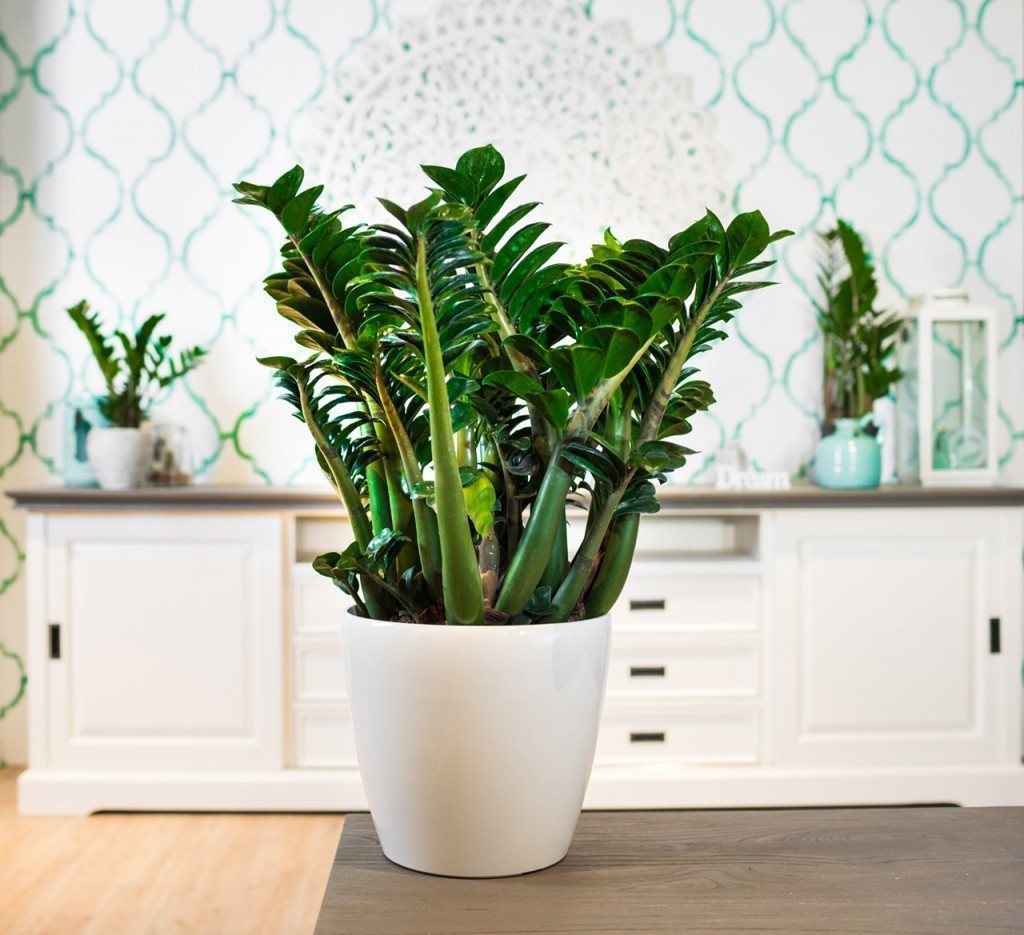
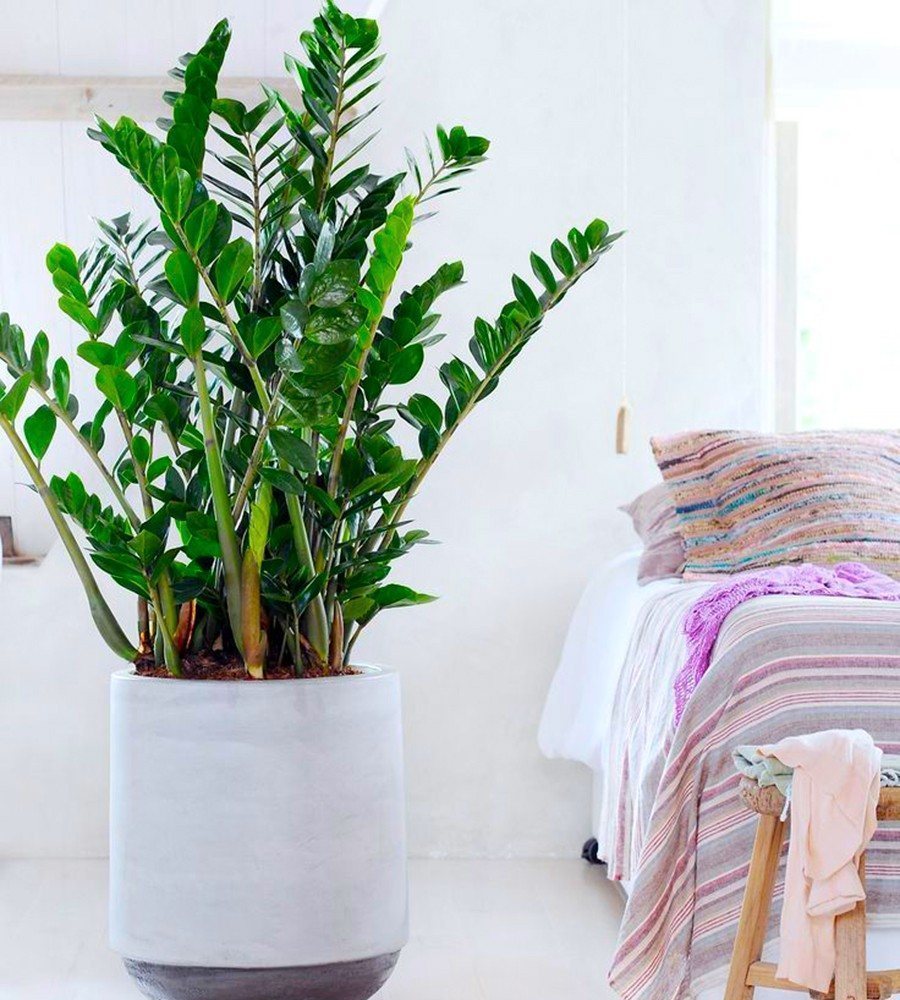
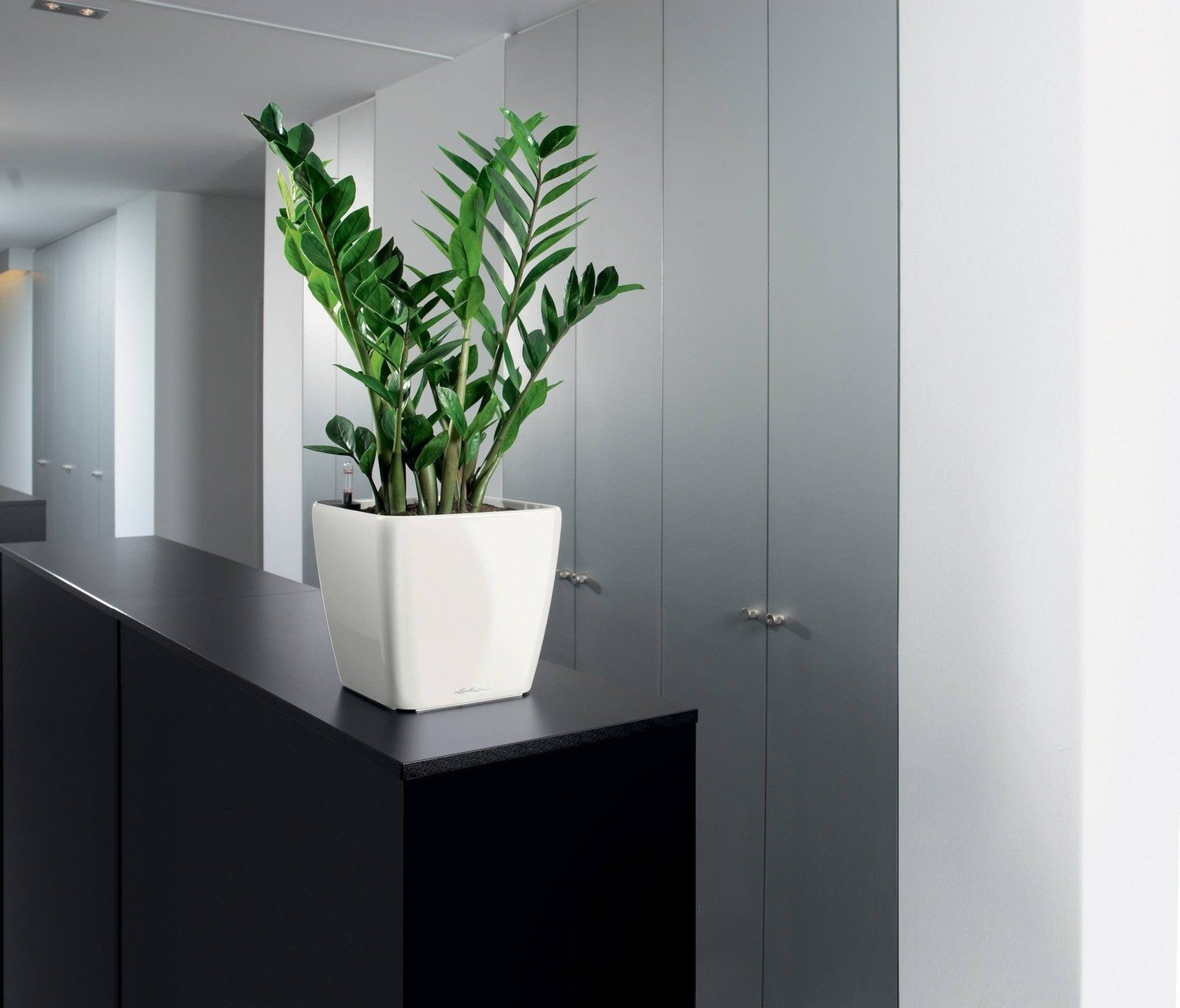
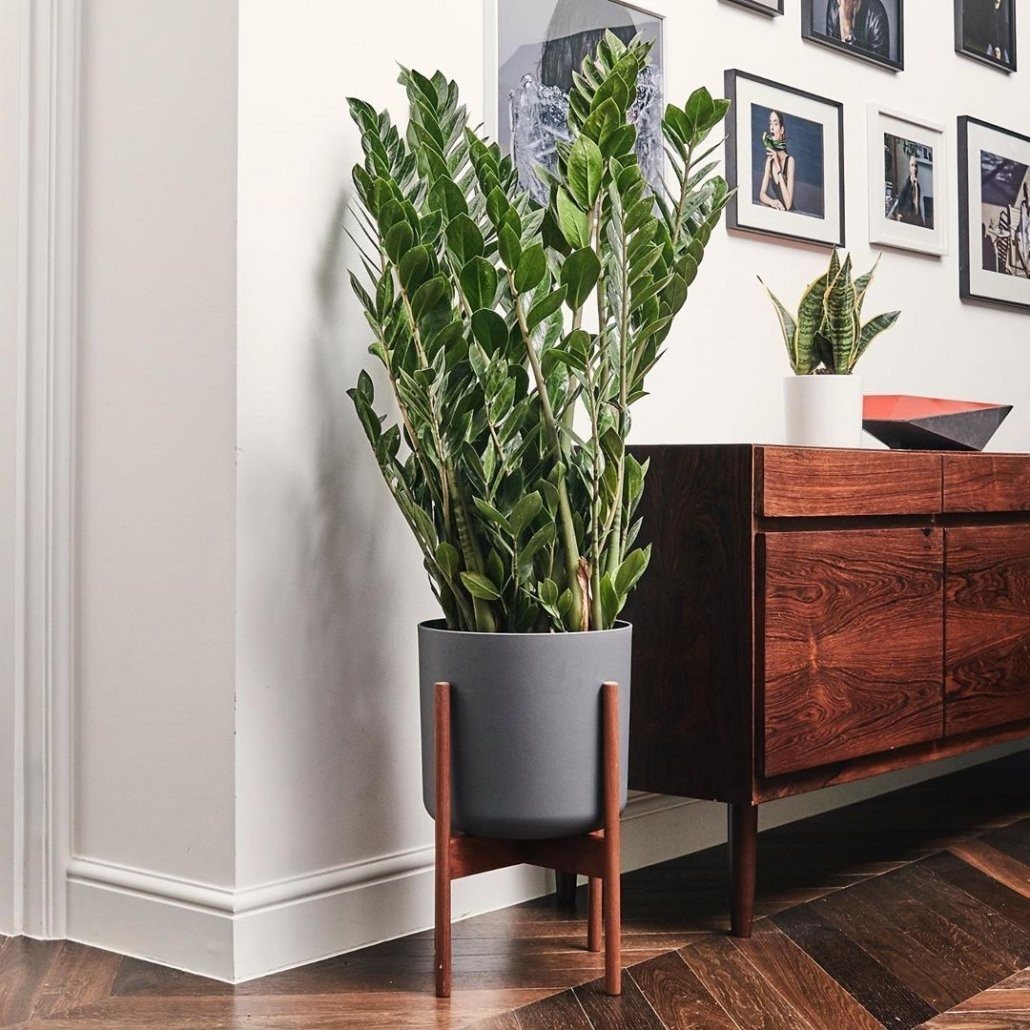
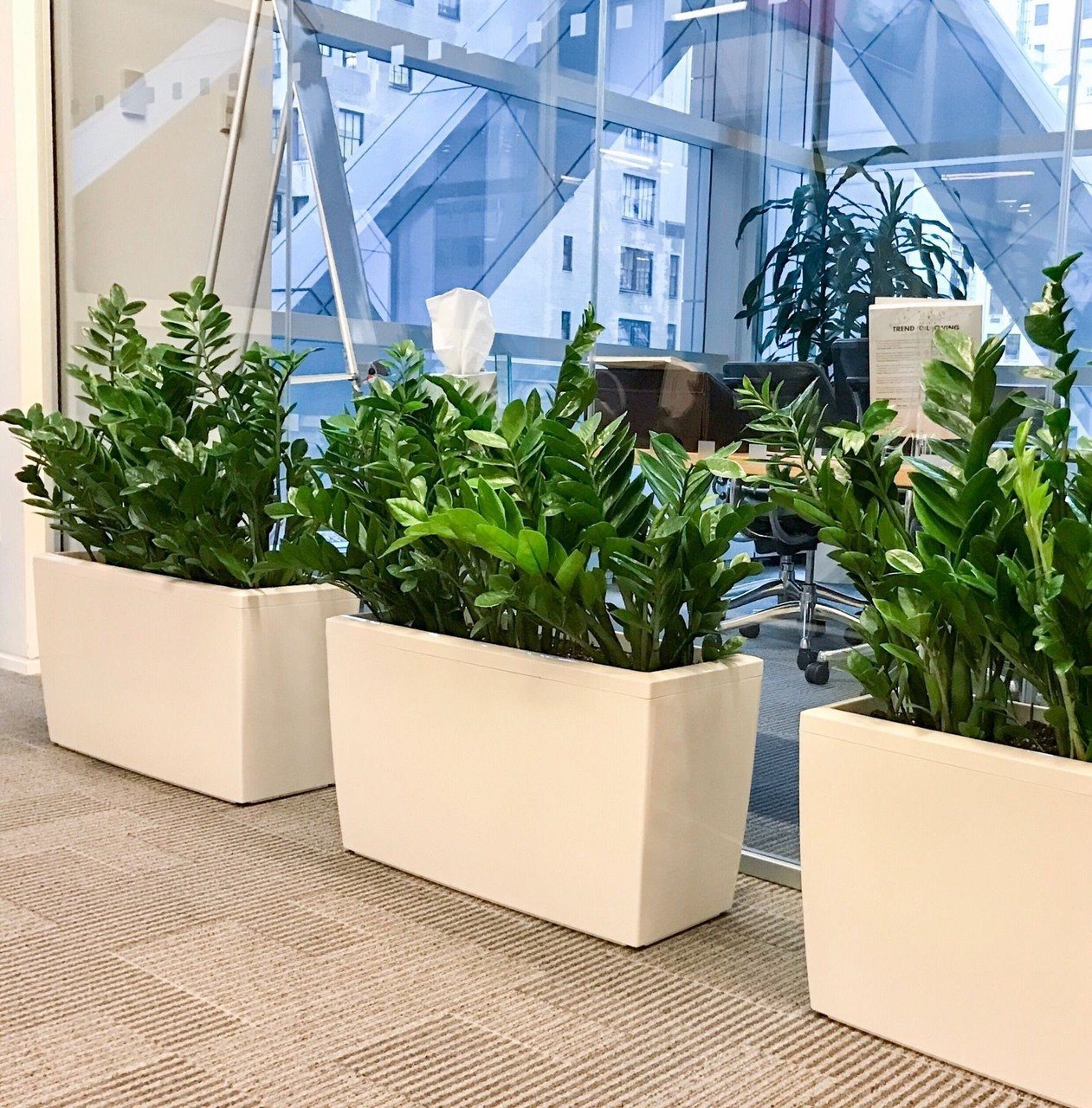
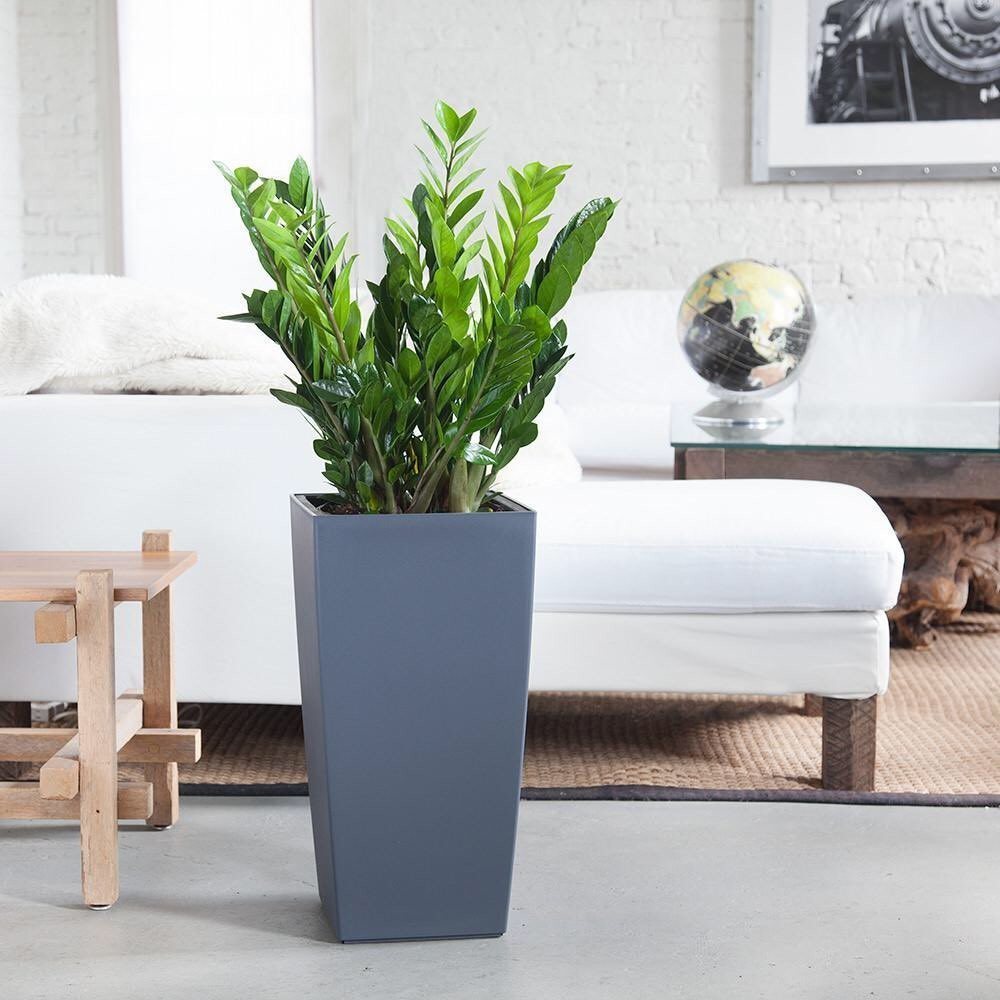
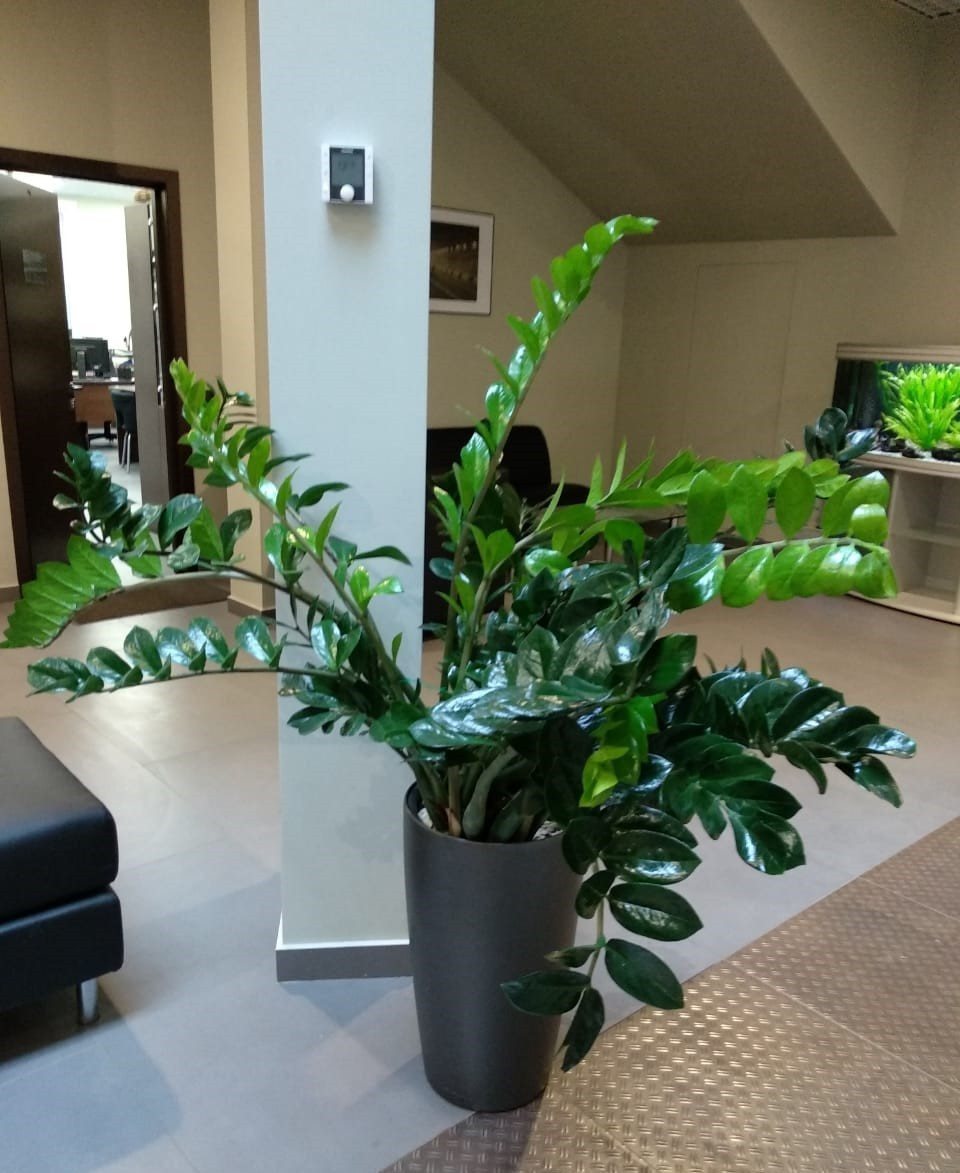
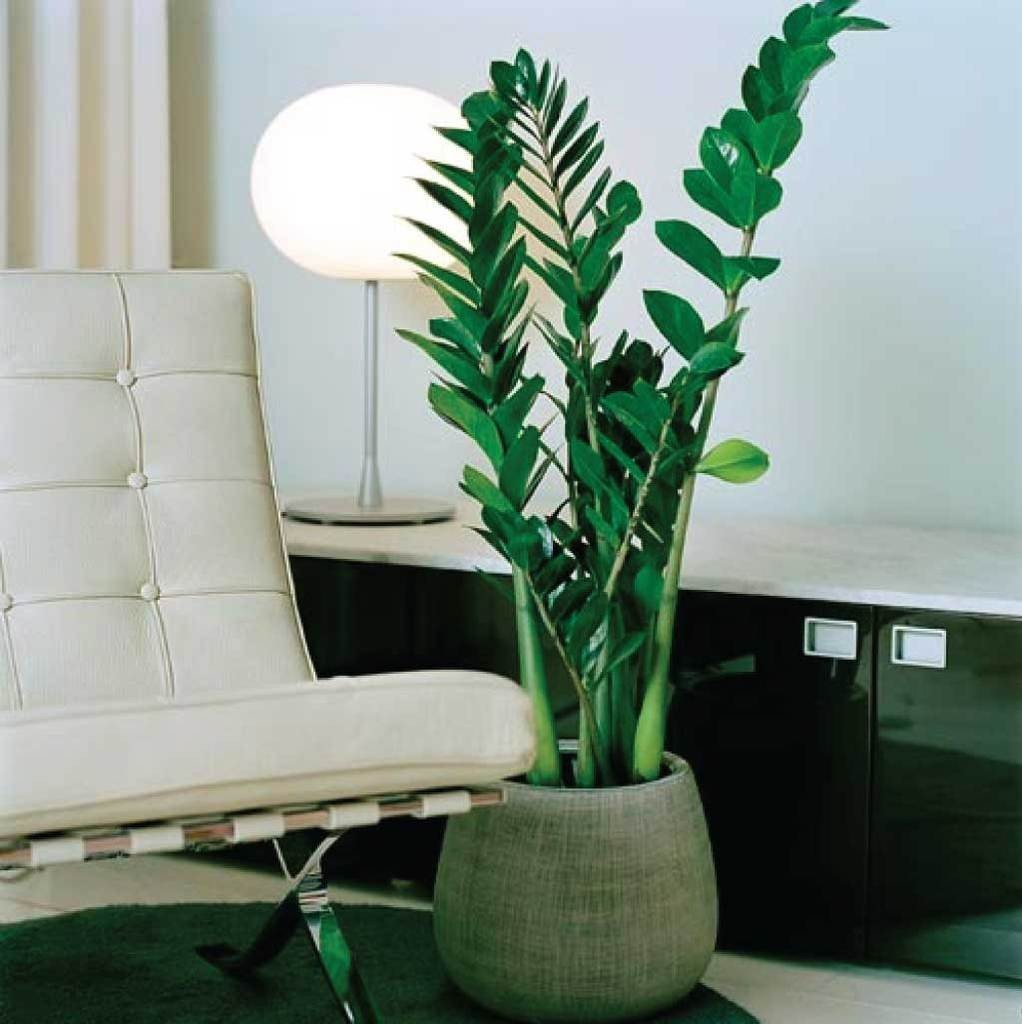
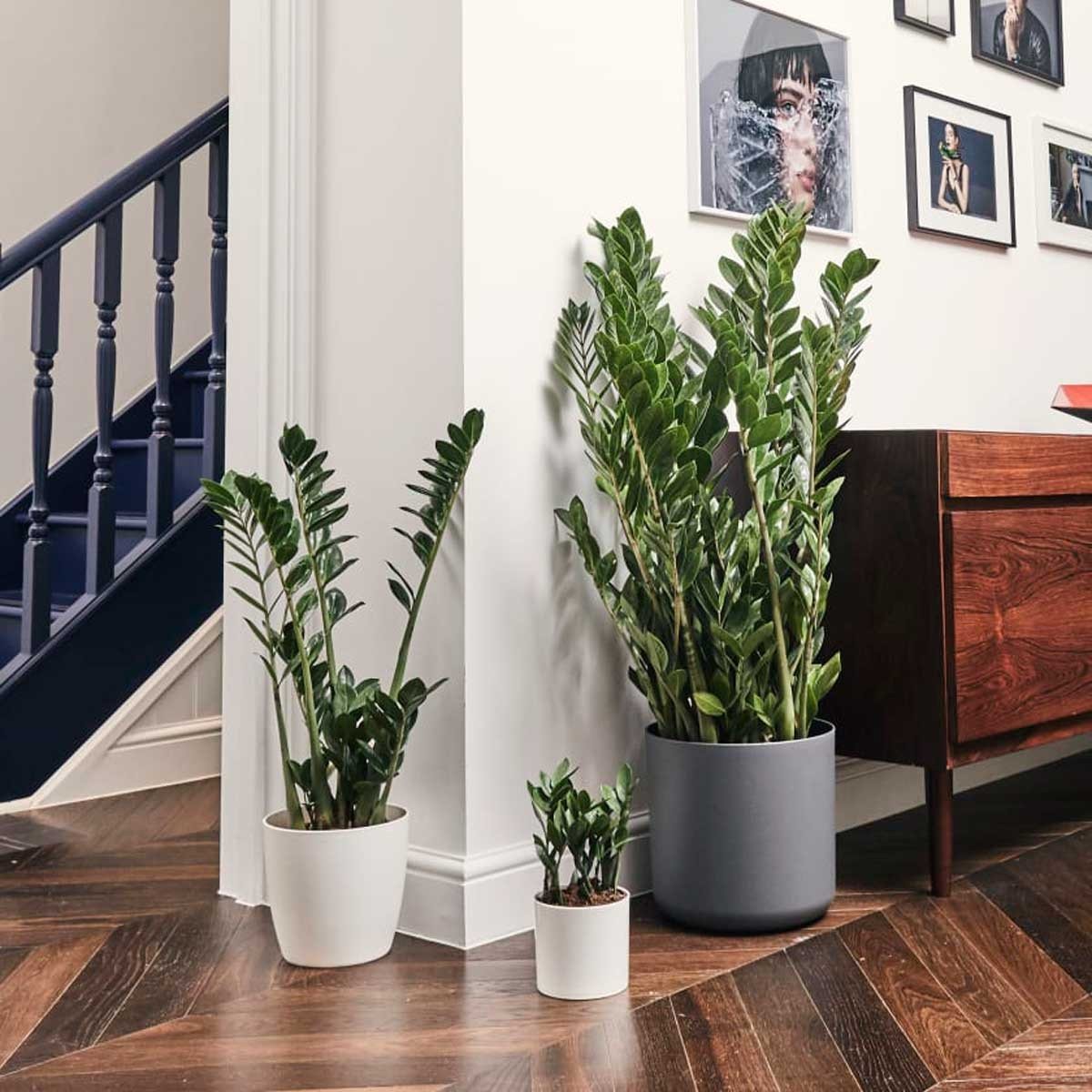
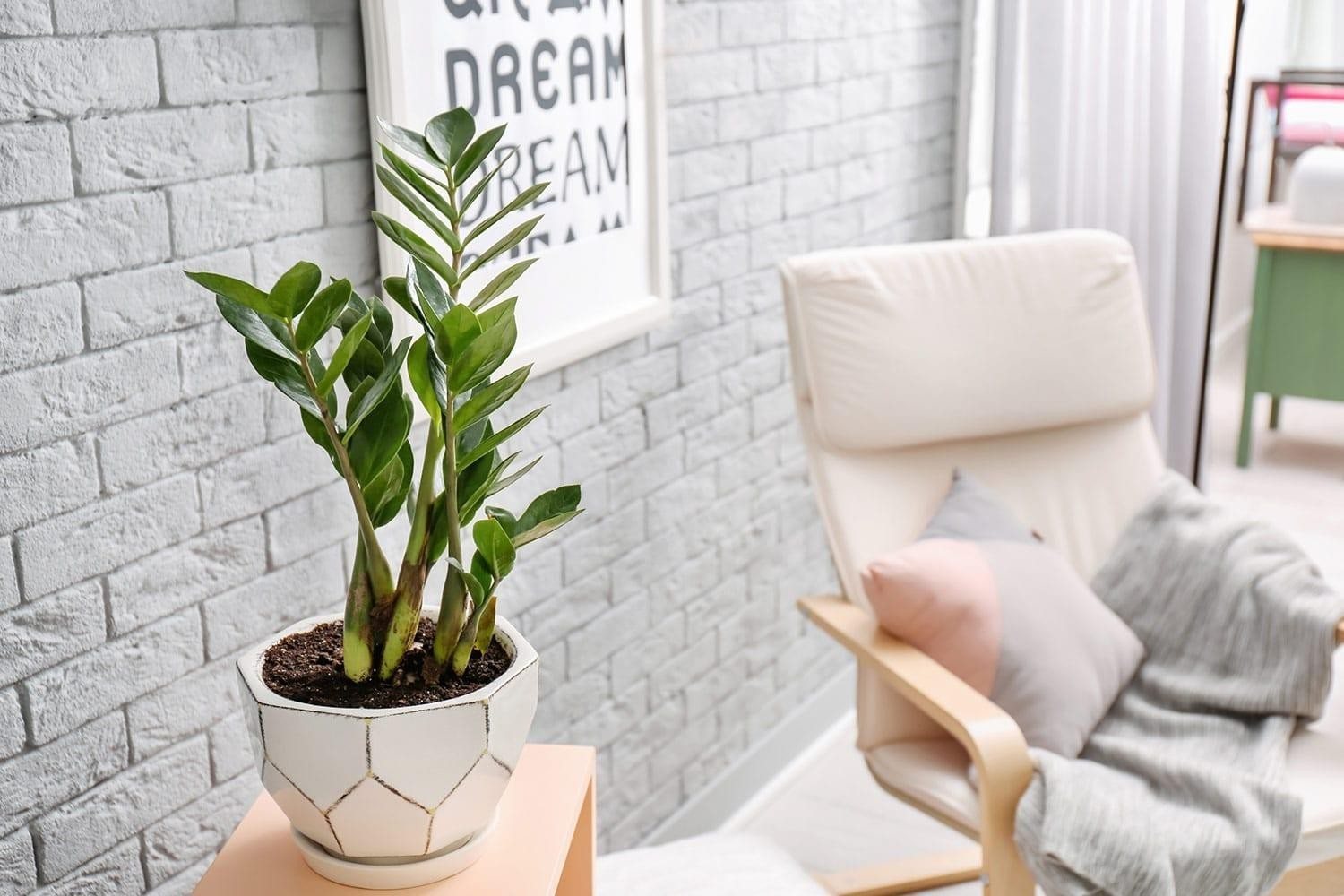










The mealybug is a small sucking insect whose body is covered with a white coating. The pest destroys the plant by feeding and reproducing on its surfaces. The provocateur of the lesion is high humidity and temperature in the room. Externally, the disease manifests itself as sticky spots on surfaces (traces of the life activity of a mealybug). Brown spots on greenery are traces of parasite bites. The method of treatment is treatment with a soap solution, and then with anticoccidal insecticides (Aktellik, Calypso, Fitoverm).
Drops of water appear


